

Is Verona Worth Visiting? 19 Reasons to Fall for the City of Love
“In fair Verona, where we lay our scene…”, writes William Shakespeare in the opening lines of Romeo & Juliet .
These few words and the city’s connection to the timeless tragic love story of Romeo and Juliet have made Verona one of the most visited cities in Italy. But is Verona worth visiting or is it all just a gimmick? Let me tell you, even if you skip over Juliet’s balcony entirely, Verona is 100 percent worth visiting. In fact, so far it is one of my favorite cities in Italy (and that is saying a lot).
I recently watched the Netflix movie Love in the Villa and while I had to roll my eyes at the all-too-obvious rom-com storyline and the obsessive focus of the main character, aptly named Julie, with Romeo and Juliet , I still enjoyed revisiting the streets and scenes of fair Verona. It was very easy to fall for the City of Love and I’m happy to tell you why.
About Verona
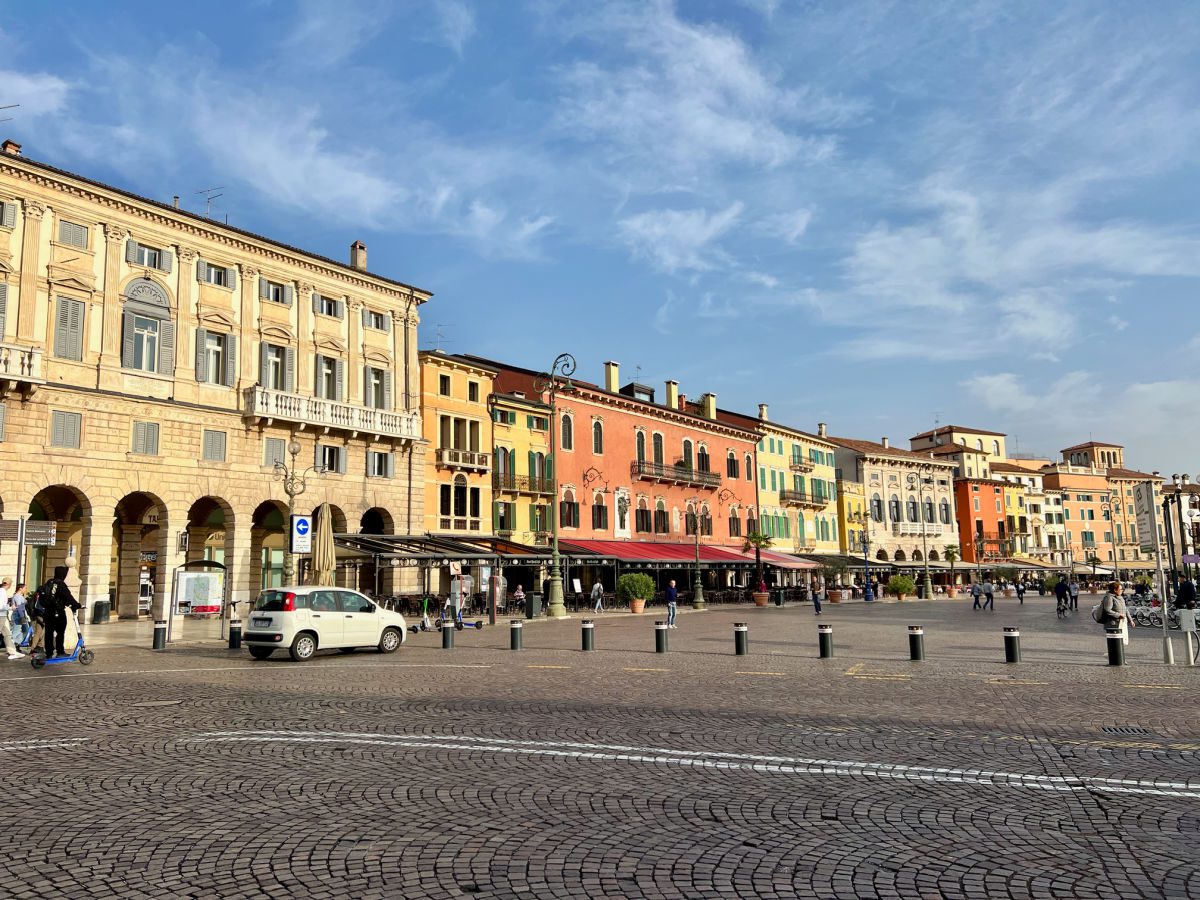
Long before it was known as the City of Love and established as a UNESCO World Heritage Centre, Verona played an important role in trade, government, and culture. Founded by the Ancient Romans in the 1st century B.C., many Roman structures still remain including the city gate, the Arco dei Gavi, the Ponte Pietra bridge, the Roman theatre, and the Arena.
Walking through the city, you will notice a mix of architectural styles, reflecting the city’s long and rich history, with Roman, Gothic, and Renaissance influences showing in the city’s buildings.
The powerful Scaliger family ruled Verona from the 13th to the 14th centuries and left a lasting impact on the city’s architecture and culture. The city has also been home to a number of famous writers, musicians, and artists over the centuries. The Italian composer Giuseppe Verdi was born in a nearby village and spent much of his career in Verona and, like Parma , the city still holds a reputation as an opera destination.
When it comes to writers, it is likely that William Shakespeare never set foot in Verona, yet his famous romantic tragedy Romeo and Juliet (based on a common local legend) was set in Verona, along with Two Gentlemen of Verona . It can be argued that in modern times, this English writer has made the most impact on the city’s current travel and tourism.
Yet locals hold deep bonds with Dante Alighieri, the poet, and writer of The Divine Comedy . Dante spent seven years in Verona during his exile from Florence as a guest of the powerful Dell Scala family. Dante wrote the De Monarchia and a good chunk of Paradiso while in Verona.
Today, Verona is known as the City of Love, thanks to the legacy of Romeo and Juliet, the city’s ancient Arena, its opera festival, and the great food and wine produced in the region. Read on to see what you should see and do while in Verona.
19 Top Things to do in Verona
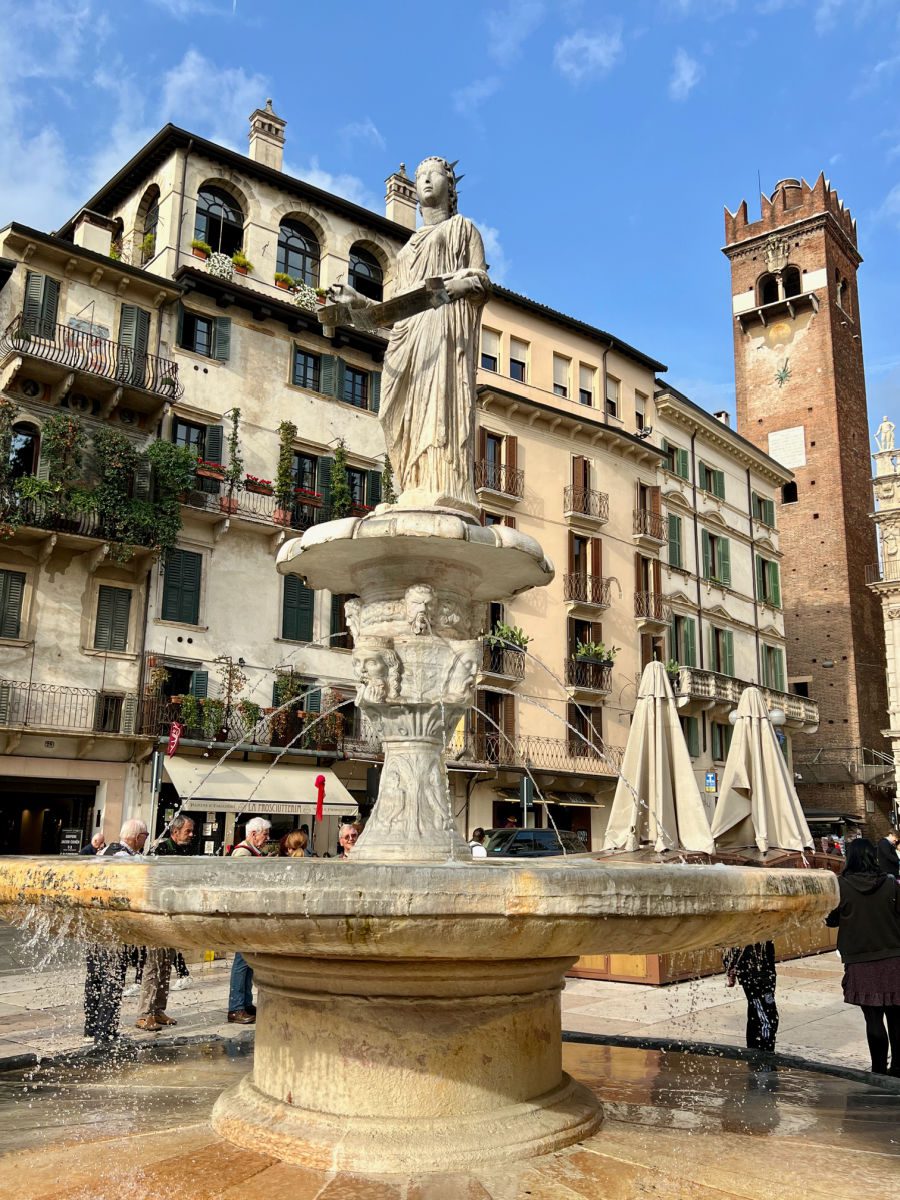
Note: This post contains affiliate links. If you click a link and make a purchase, I may receive a small commission at no cost to you.
While many people visit Verona on a day trip from Venice , I encourage you to stop and stay a while. The city center is compact and charming with clean streets that are easy to navigate. It can get crowded but nothing like Venice or Florence , except perhaps in the courtyard of Juliet’s house at midday. I visited on my own and felt totally safe as a solo female traveler, even at night.
Follow these things to do in Verona and I’m sure you will soon agree that Verona is worth visiting. One of the best ways to see many of these sights and get a feel for the city so that you can explore on your own is through a city highlights walking tour . I had a lovely tour with Silvia from LivTours, who customized a private tour to meet my interests (semi-private, small-group tours are also available).
Tip : if you are going to visit many of Verona’s top attractions, you may want to purchase a Verona Card . This is a combined ticket that gives you access to the main sights of the city including the Arena, Juliet’s House, Castelvecchio, Museo Archeologico, and the Teatro Romano. You can either purchase the 24-hour card or the 48-hour card for just a bit more. It also provides travel on city buses for free.
Check entrance fees for the sights you want to visit to determine your potential savings. Also, if you mainly want to visit churches, there is also a multi-church pass that you can purchase for overall savings on entrance fees.
Also, keep in mind that on the first Sunday of every month many attractions are only 1 euro to enter, so you can expect larger crowds on those days. The other thing to consider is that many monuments and attractions are closed on Mondays, especially from October through May. This is something I wish I knew before visiting on a Monday in October! Luckily there was still plenty to see and do that was open.
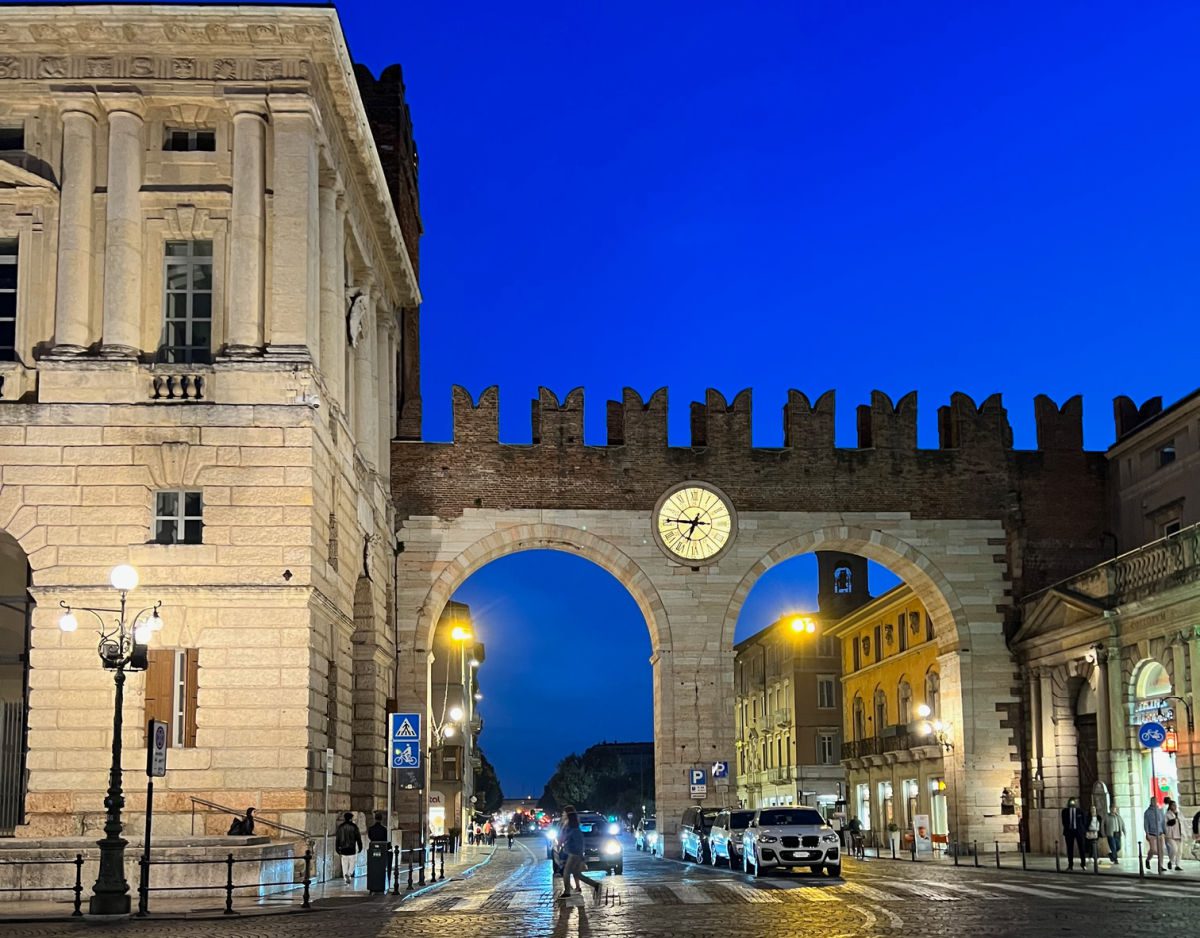
Start off exploring the Centro Storico (historic center) of Verona in Piazza Bra. This picturesque square is the hub of the city. In the center of the square, you will find the Brà Fountain and a monument to Vittoria Emanuele II, the first king of Italy.
Surrounding the piazza you will find the city gate, the Arena di Verona Roman amphitheater, the Verona Philharmonic Theatre (home to the Verona Opera Festival), and the City Hall. This is a fun spot to people-watch and soak up the atmosphere.
Arena di Verona
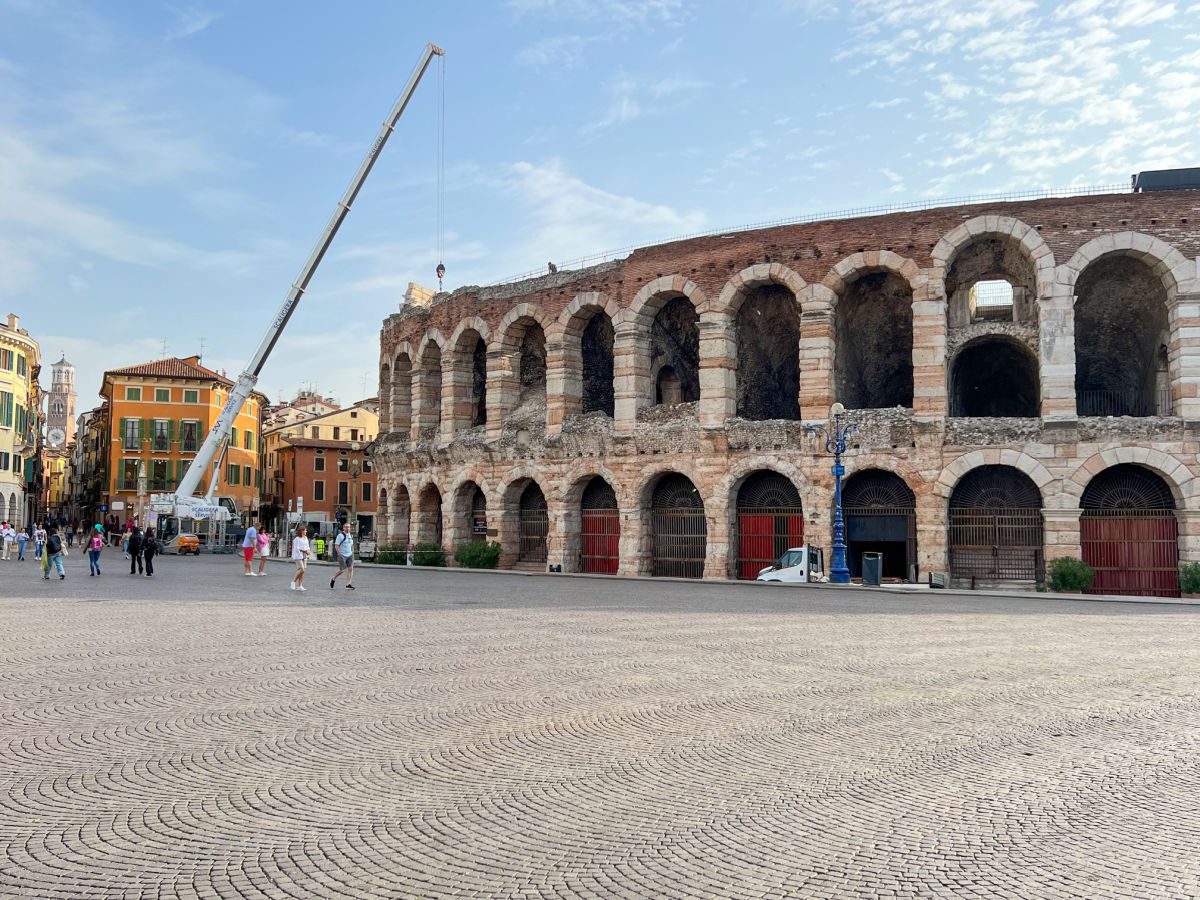
The Arena di Verona is a Roman Amphitheater built in the first half of the 1st century B.C., making it older (although smaller) than the famous Roman Colosseum. The Arena was built between the end of the empire of Augustus and the empire of Claudius to host gladiator shows, struggles with wild animals, and other events that were popular at the time.
Today, musical concerts and opera performances take place in the Arena, with its oval shape providing perfect acoustics. Visitors can also tour the Arena, just keep in mind that from October through May, the Arena is closed on Mondays. It is recommended that you pre-book your entrance ticket to the Arena or sign up for a skip-the-line tour. Sadly, when I visited in October it was on a Monday and the Arena was closed so I could only see it from the outside.
Via Giuseppe Mazzini / Centro Storico
The Piazza Bra and the Arena, I would recommend walking up the pedestrian street of Via Giuseppe Mazzini toward Piazza delle Erbe. This tiled street is lined with designer boutiques and is a main shopping area in Verona. You will also find yummy stops for gelato, like at Grom or Venchi. There is a mix of Italian designers and international brands.
Once you wander off the main route, you will find charming side streets, authentic local restaurants, and beautiful architecture.
Casa di Giulietta
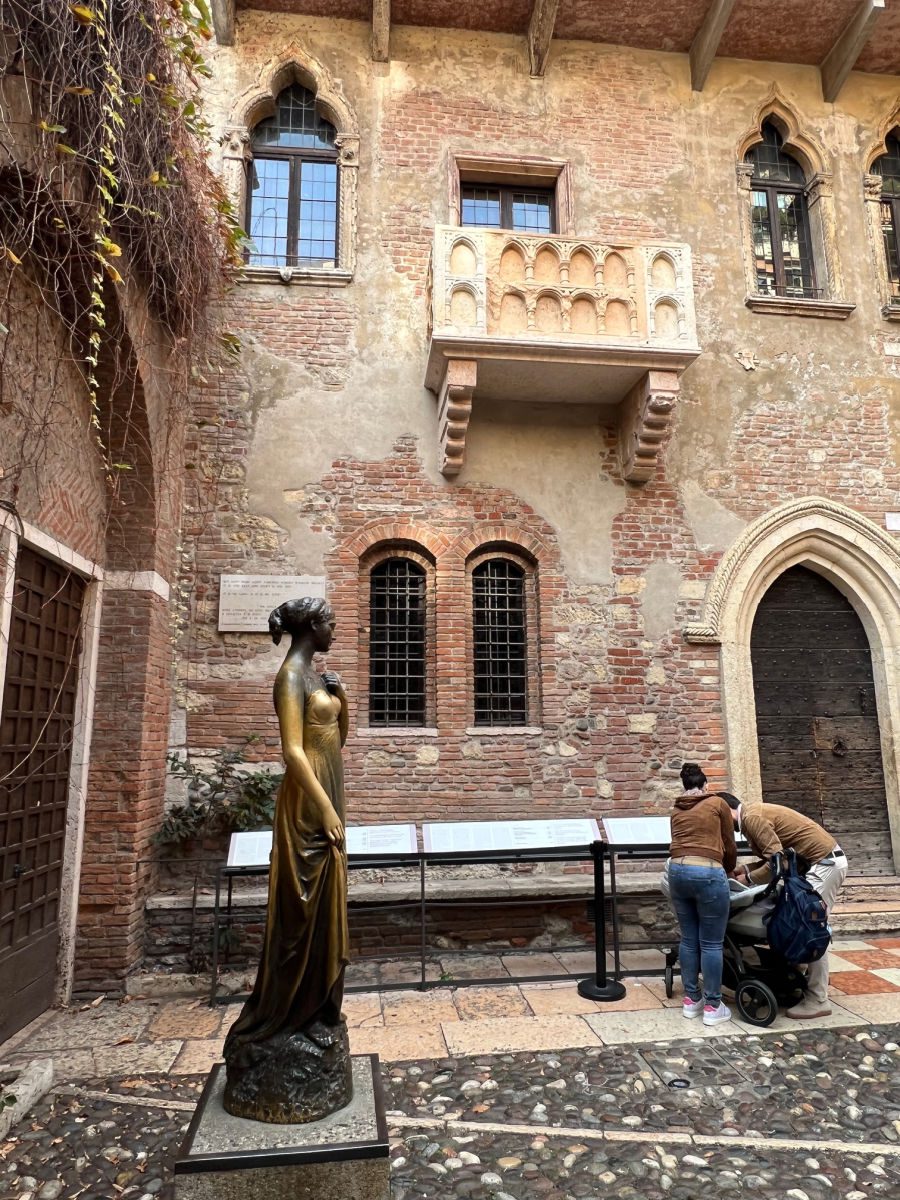
Juliet’s House is one of the most famous and visited attractions in Verona. Casa di Giulietta is located in a medieval palace in Verona off Via Cappello, where the Dal Cappello family probably lived since the 13th century. Legend has identified it as the birthplace of Giulietta Capuleti, protagonist, along with the beloved Romeo Montecchi, of the famous Shakespearean tragedy, Romeo and Juliet .
The balcony where we can imagine Juliet pining over Romeo is actually a reconstruction using marble remains from the fourteenth century. In the courtyard, there is a bronze statue of Juliet, made by Nereo Costantini. You will notice that her right breast has been rubbed to a sheen by visitors wishing for good luck in love.
If you want to visit Juliet’s courtyard and see her balcony, I would suggest getting there early to avoid the crowds. In the tunnel into the courtyard, you will see love notes left on the walls to replace the graffiti visitors used to leave on the walls. There is also a fence with love locks left by visitors and the red mailbox featured in Letters to Juliet , where people from around the world leave letters to “Juliet.” These letters are thoughtfully answered by a group of volunteer women called the “Secretaries of Juliet.”
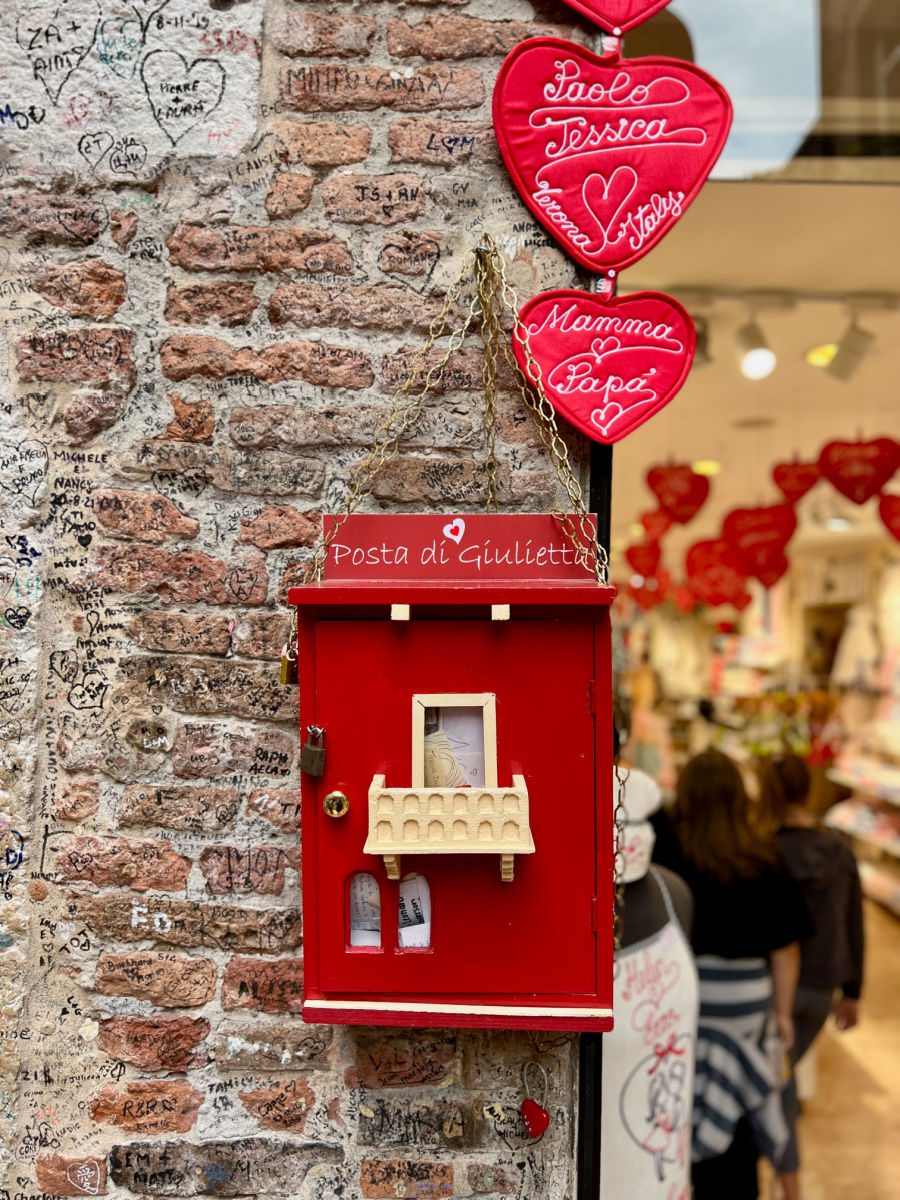
The Casa di Giulietta Museum is open to visitors that have pre-purchased a ticket online . The Museum is open from 9 am to 7 pm. From October through May, the museum is closed on Mondays. Inside the house, you can see Veronese frescoes and paintings of the nineteenth century depicting some moments of the legend of the two lovers, a desk, from which you can write messages of love for Juliet, furnishings from the time period, and some costumes used in the famous film by Franco Zeffirelli.
Piazza Delle Erbe
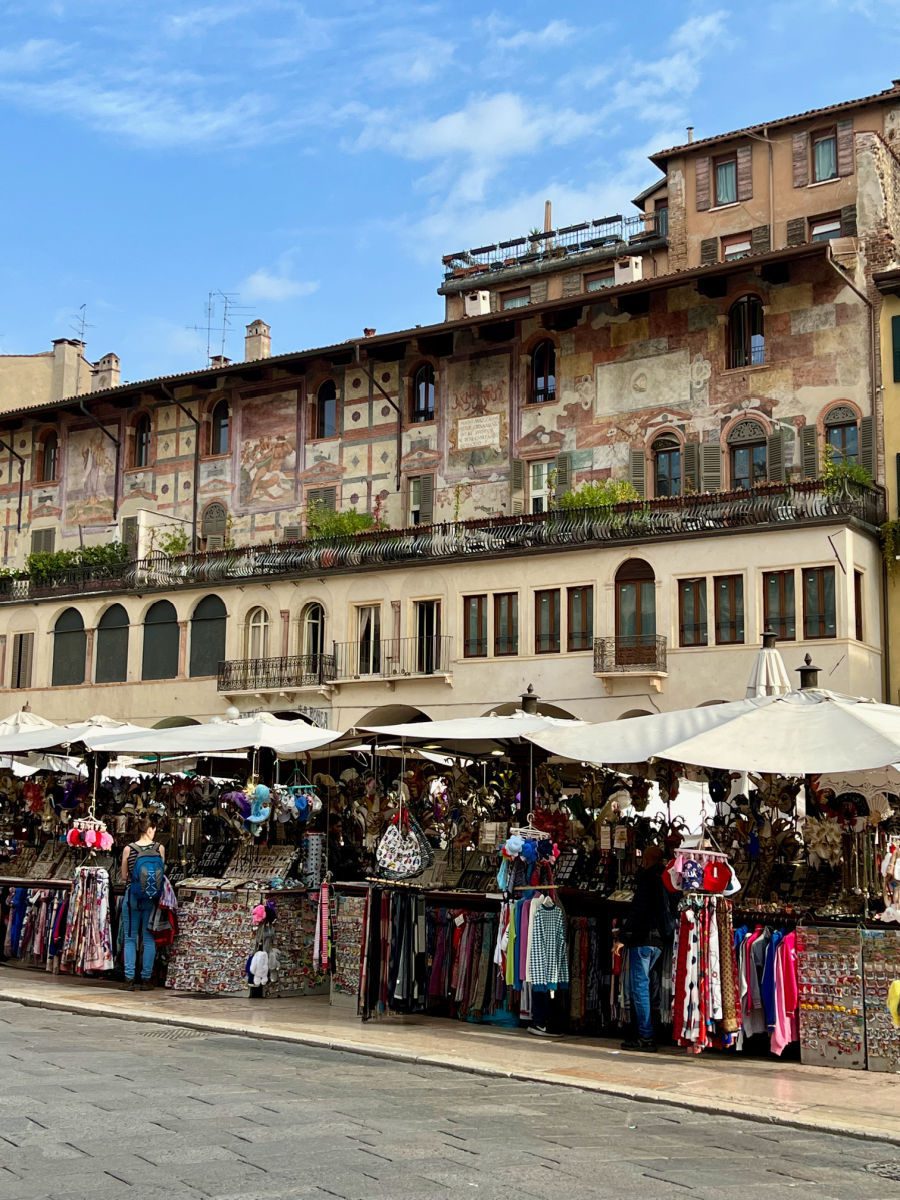
Piazza Delle Erbe (Herbs Square) is the oldest piazza in Verona and was the center of commerce, social, and economic life for centuries. Today, there is a market every Monday consisting mainly of souvenirs so the market itself isn’t the attraction, but the buildings around the square are.
In Piazza Delle Erbe you will find the Madonna Verona Fountain. There is also a row of small, narrow but tall buildings on one end that were previously part of the Jewish Ghetto, which was disbanded by Napoleon. At the other end are a series of columns with lions at the top that resemble those in St. Mark’s Square in Venice.
Many of the buildings around the square are still decorated with beautiful frescoes that date back centuries. Looming over the square is the Torre del Lamberti.
Torre dei Lamberti
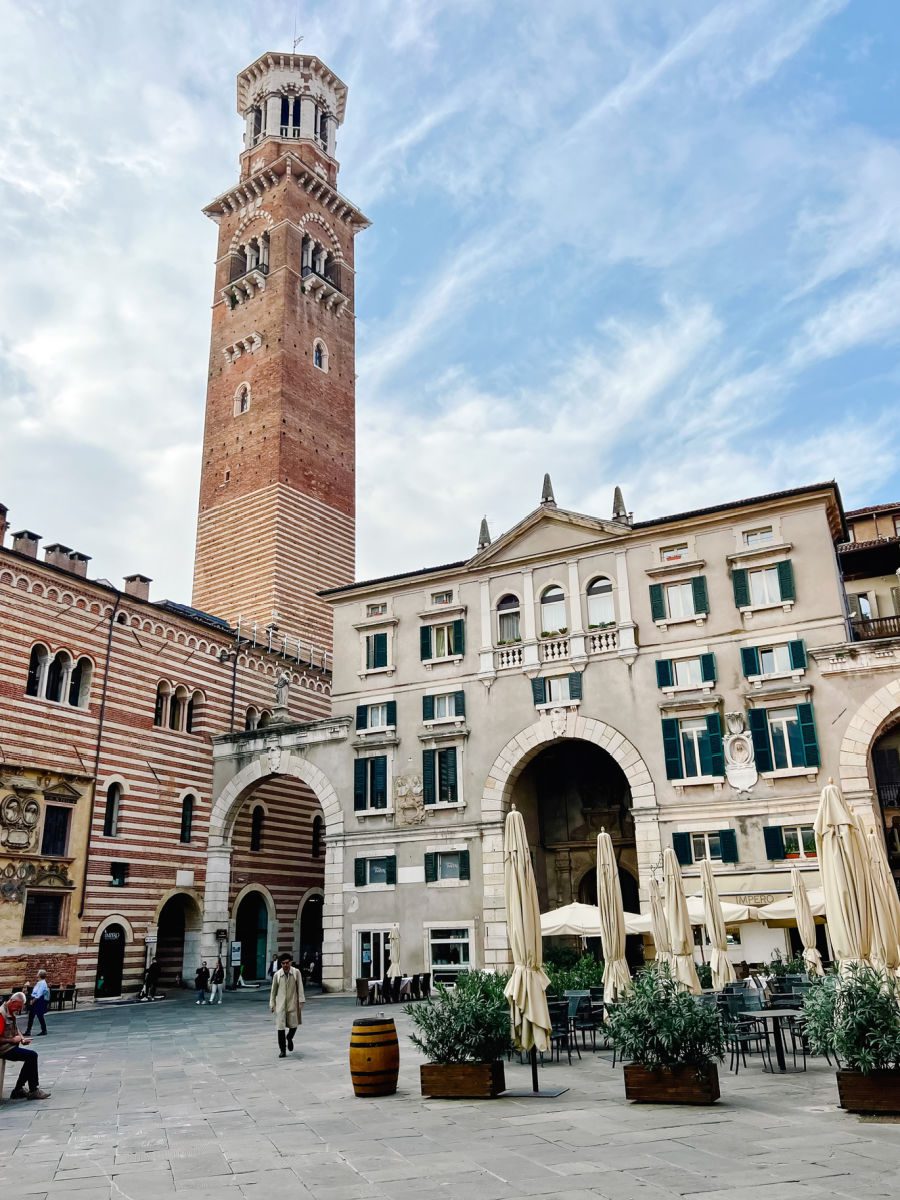
Standing tall at 84 meters above Piazza Delle Erbe, the Torre dei Lamberti offers 306-degree views of Verona for those that venture to the top. Built in 1172 at the behest of the Lamberti family, the bell tower was added in 1295 with two Rengo bells. It later collapsed after a lightning strike and was rebuilt and completed in 1463, with the clock added in 1798.
You can climb this Veronese landmark, or purchase a ticket to ride the elevator for just a little bit more. It is recommended that you pre-book your tickets, yet visiting in October I had no problem walking in, purchasing a ticket, and waiting less than five minutes for an elevator to the top. You may want to time your visit to the top of the hour in hopes of being at the top when the bells are rung.
Piazza dei Signori
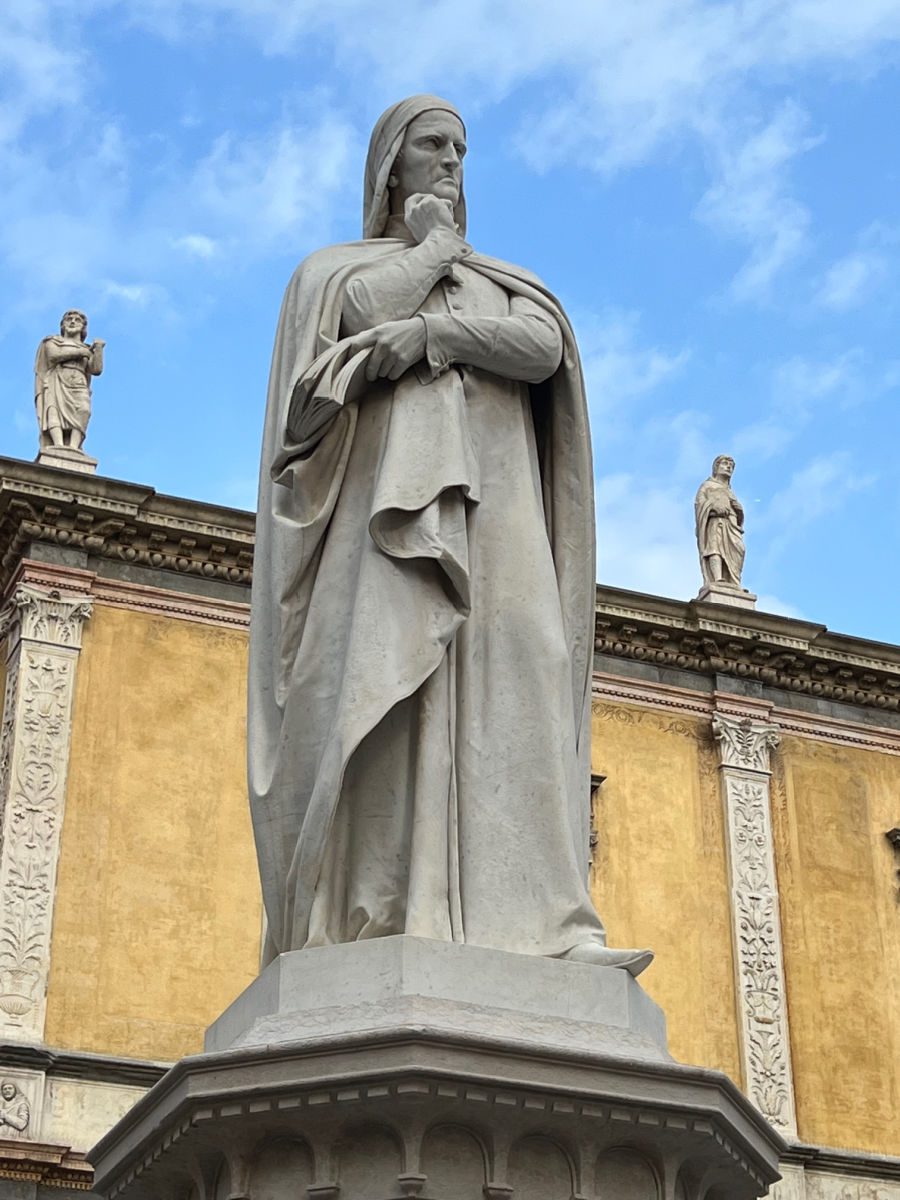
If you follow an archway through the Piazza Delle Erbe, past the Torre dei Lamberti, you will reach another beautiful, and quieter square, Piazza dei Signori. Surrounded by beautiful buildings and cafes, the highlight of this square is the central statue of writer and hometown favorite Dante Alighieri.
If you look closely around this area, you may also find some small carved faces or medallions with open slots. These were actually once mail slots that were used for townspeople to anonymously tattle on those that were committing crimes. Each was set up for a different type of infraction. Kind of fascinating!
Palazzo Della Ragione
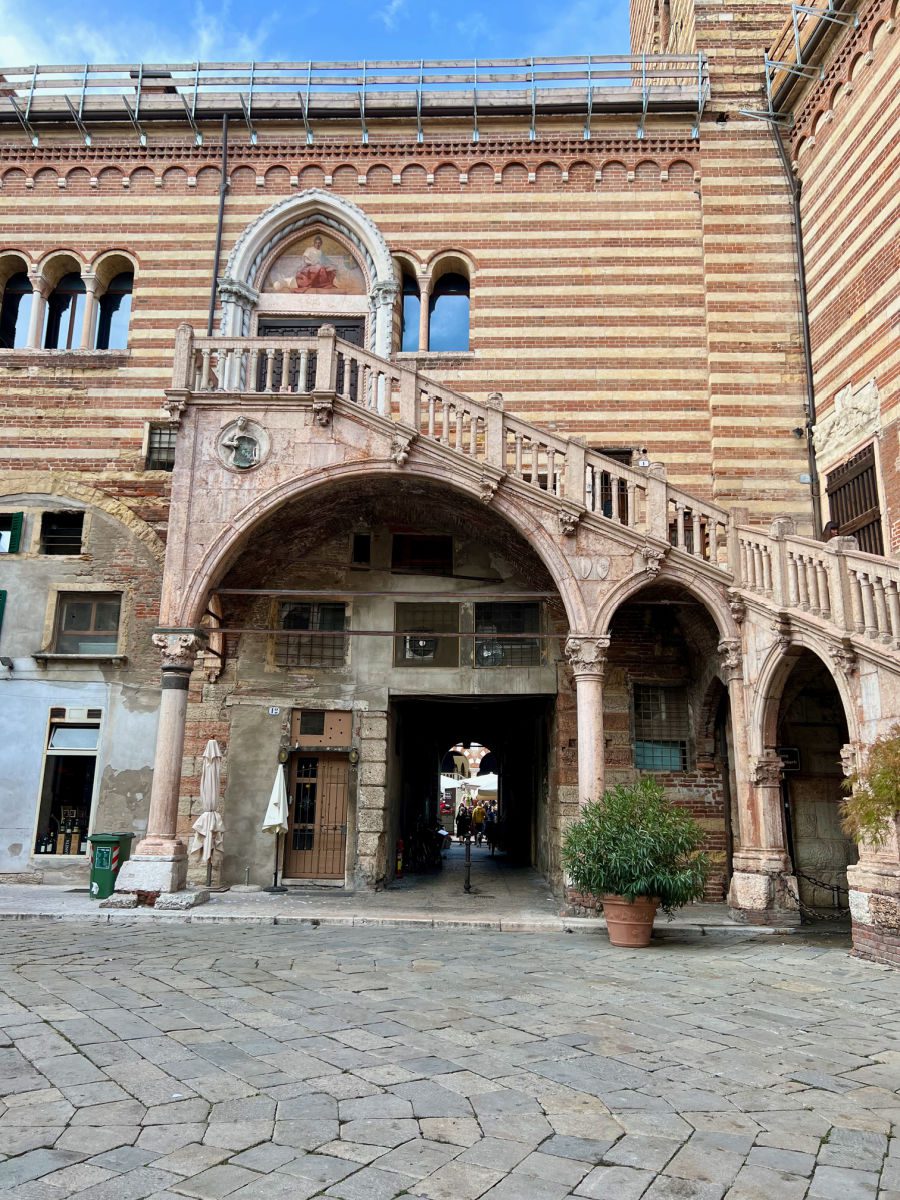
Just off the Piazza dei Signore, you will find another courtyard in front of the Palazzo Della Ragione, now home to a modern art gallery. The Mercato Vecchio courtyard is surrounded by a portico with arches supported by rustic ashlar pillars, with stripes of alternating colors of brick and tuff stone.
The main attraction is the Scala Della Ragione, which is a beautiful staircase built from red Veronese marble that makes a beautiful photo backdrop.
Scaliger Family Tombs
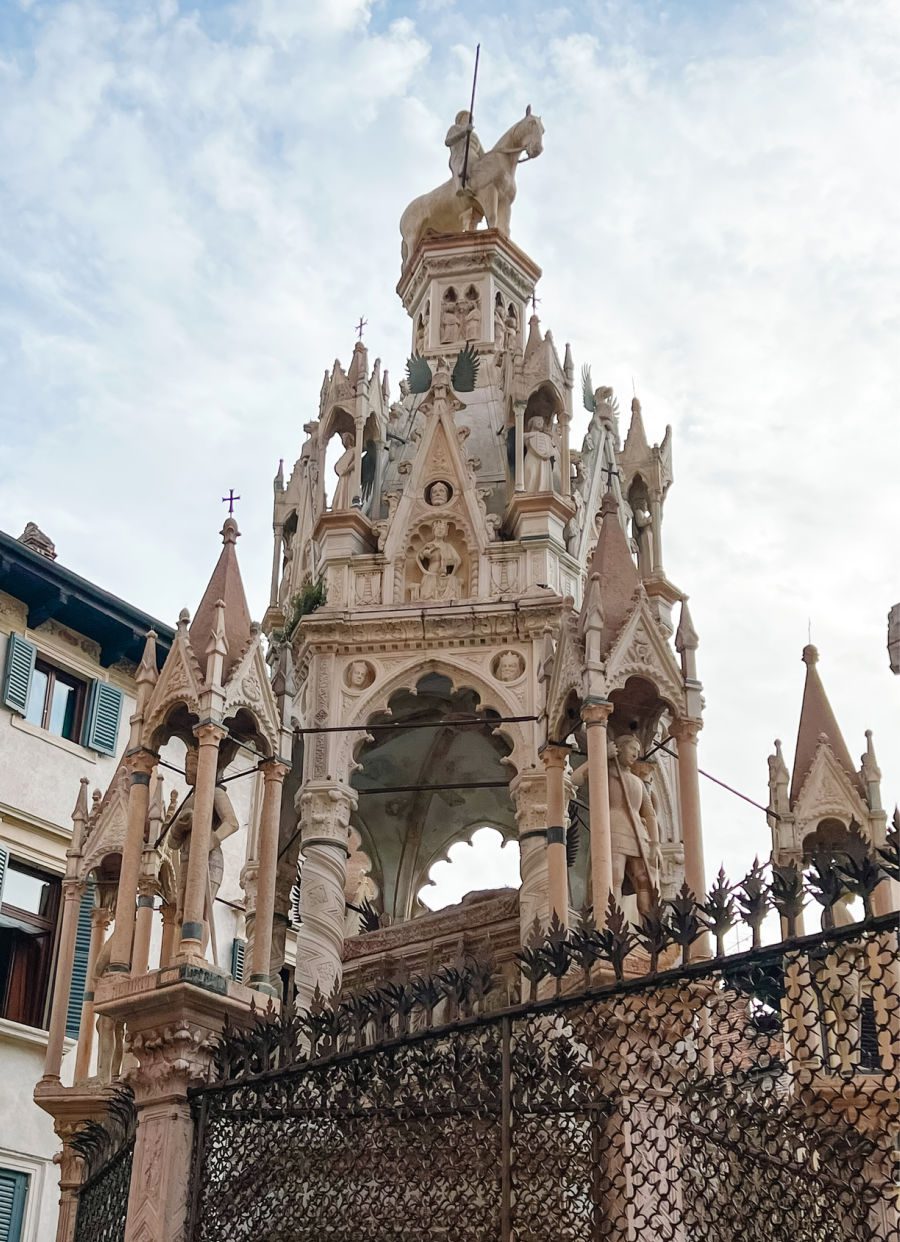
Nearby you will also find the Scaliger family tombs. While that may seem a bit dark, it is another example of Verona’s elaborate architecture and the power and wealth of the city’s ruling families.
Chiesa di Santa Anastasia
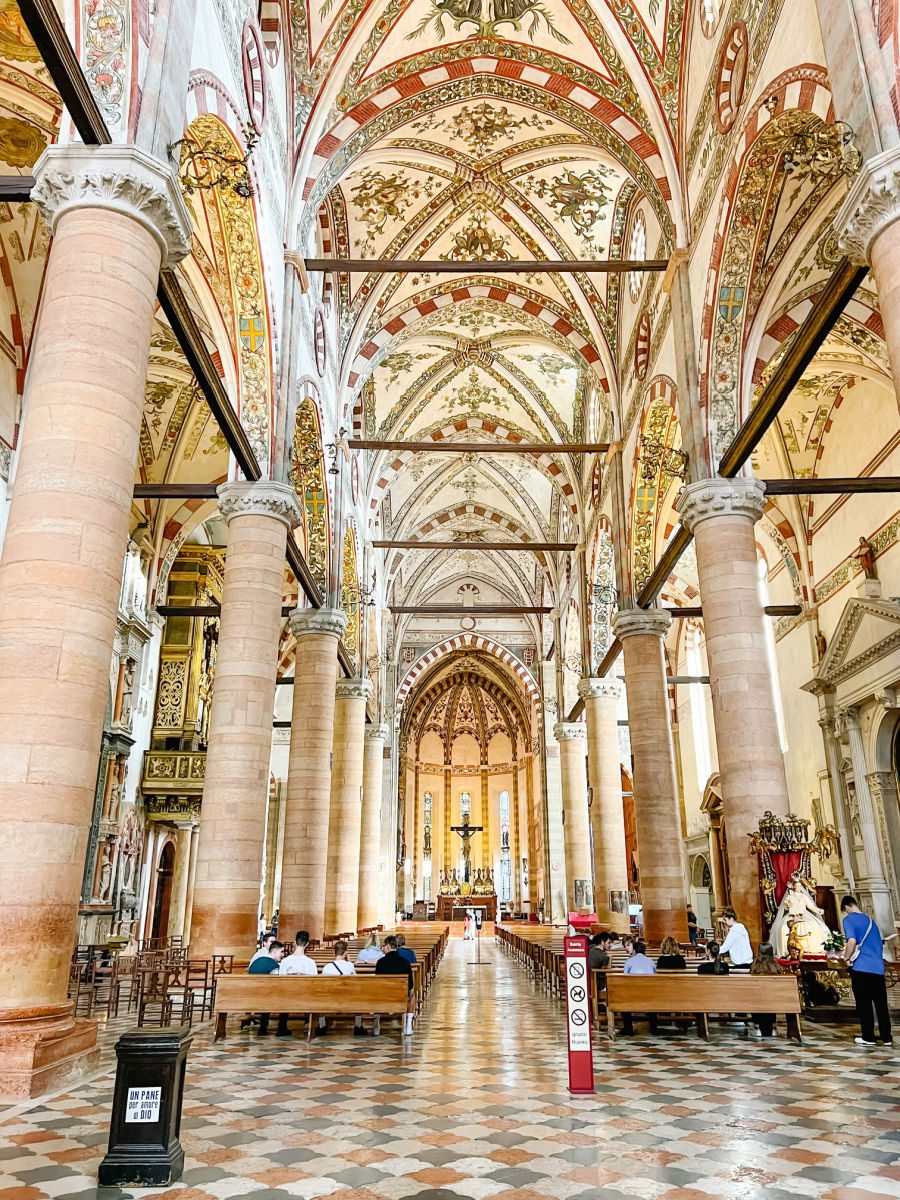
Located just a short walk from Piazza Delle Erbe and steps from the Adige River near the Ponte Piedra, the Chiesa di Santa Anastasia (Church of Anastasia) is a Dominican church with Gothic architecture that was built in the late 13th century on an older church. The largest religious building in Verona, this church has a majestic apse and a high bell tower all made from red brick.
The facade was never completed, but inside there are many beautiful chapels with a large collection of paintings by famous painters from Verona such as Girolamo dai Libri and Altichiero. St Anastasia’s most famous work of art is the fresco by Pisanello representing St George freeing the Princess , considered a masterpiece of gothic painting. It decorates the arch of the Pellegrini Chapel.
Outside, there is a beautiful little square in front of St. Anastasia, and to the left is the suspended tomb of Guglielmo da Castelbarco, the forerunner of the famous Scala family tombs.
Duomo (Verona Cathedral)
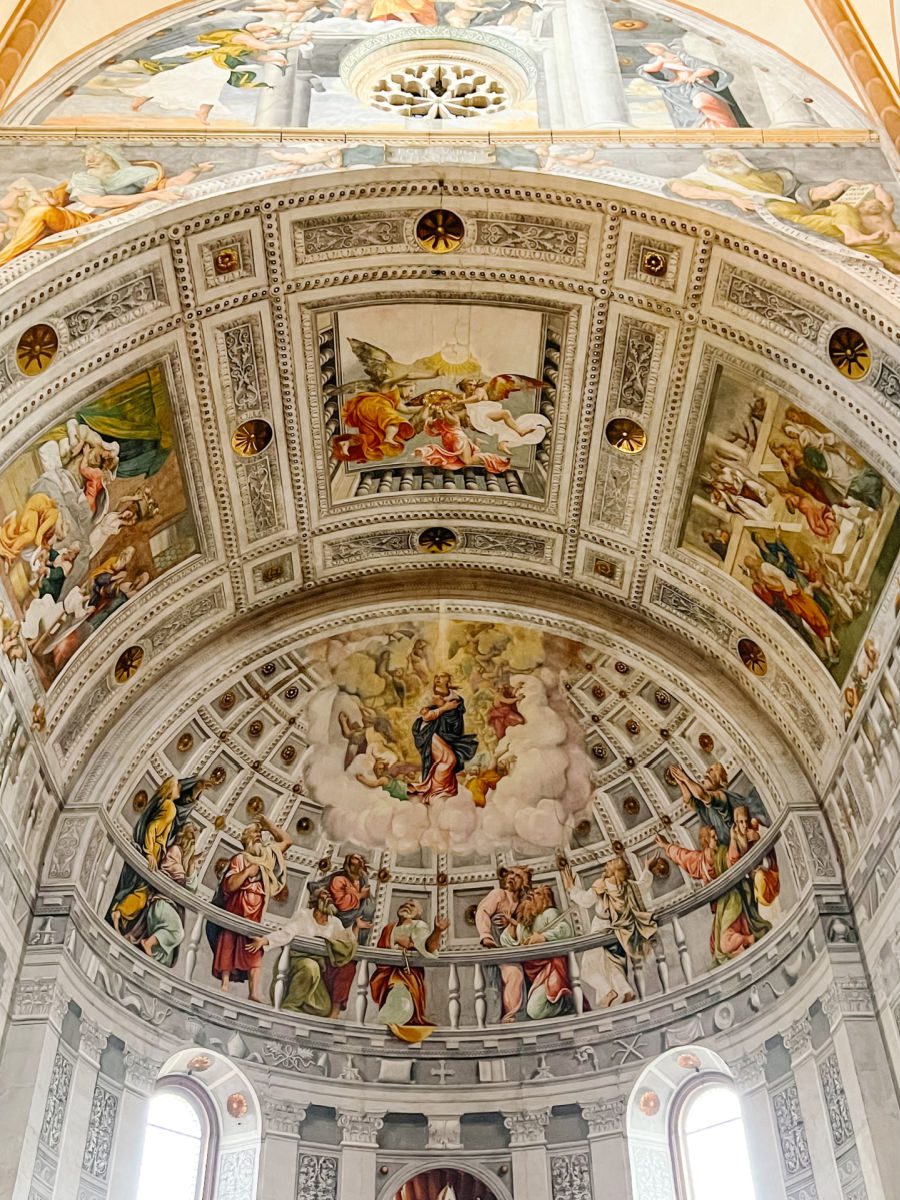
The Verona Cathedral is located near Anastasia and it is easy to visit both within a short time, especially if you get the pass for all of Verona’s churches. If you are limited in time, you can skip this one as it isn’t as impressive as the other two churches that I recommend. The Cathedral of Verona consists of a group of buildings including the Duomo, St. Giovanni in Fonte baptistery of Verona, St. Elena, the Canonical museum, its cloister, the library, the bishop’s residence, and the bell tower.
It was built in the Romanesque style in 1187 but it was restored and enlarged in the gothic style in 1440. Its highlights are the Fresco decorations on the walls are by Falconetto, painted in the sixteenth century, the apse basin decorated with a fresco by Francesco Torbido, and the Our Lady of Assumption painting by Titian.
Chiesa di San Fermo
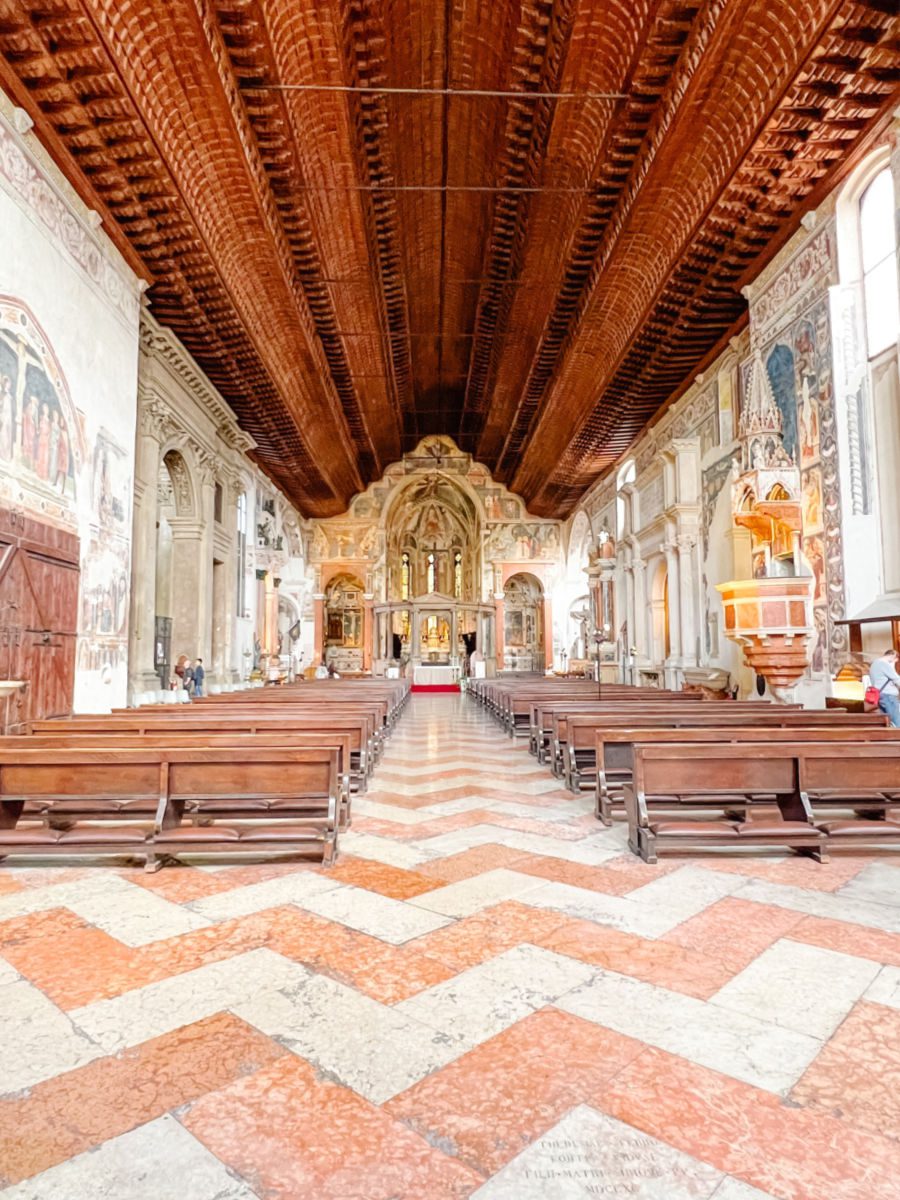
Of all the churches in Verona, my favorite was Chiesa di San Fermo (although I didn’t get to the Basilica di San Zeno.) While it is a bit more off-the-beaten-path on the banks of the river Adige, near the Porta dei Leoni, the church was built in the 5th century. It is dedicated to the Saints and martyrs, Fermo and Rustico. There is a lower church, but the draw is the upper church, which was completed in 1261.
There are many beautiful frescoes in Chiesa di San Fermo, but what I really loved was the carved wooden ceiling. It is painted with the busts of 416 saints in the arches with vibes of a Nordic grand hall and is an architectural masterpiece.
Ponte Piedra
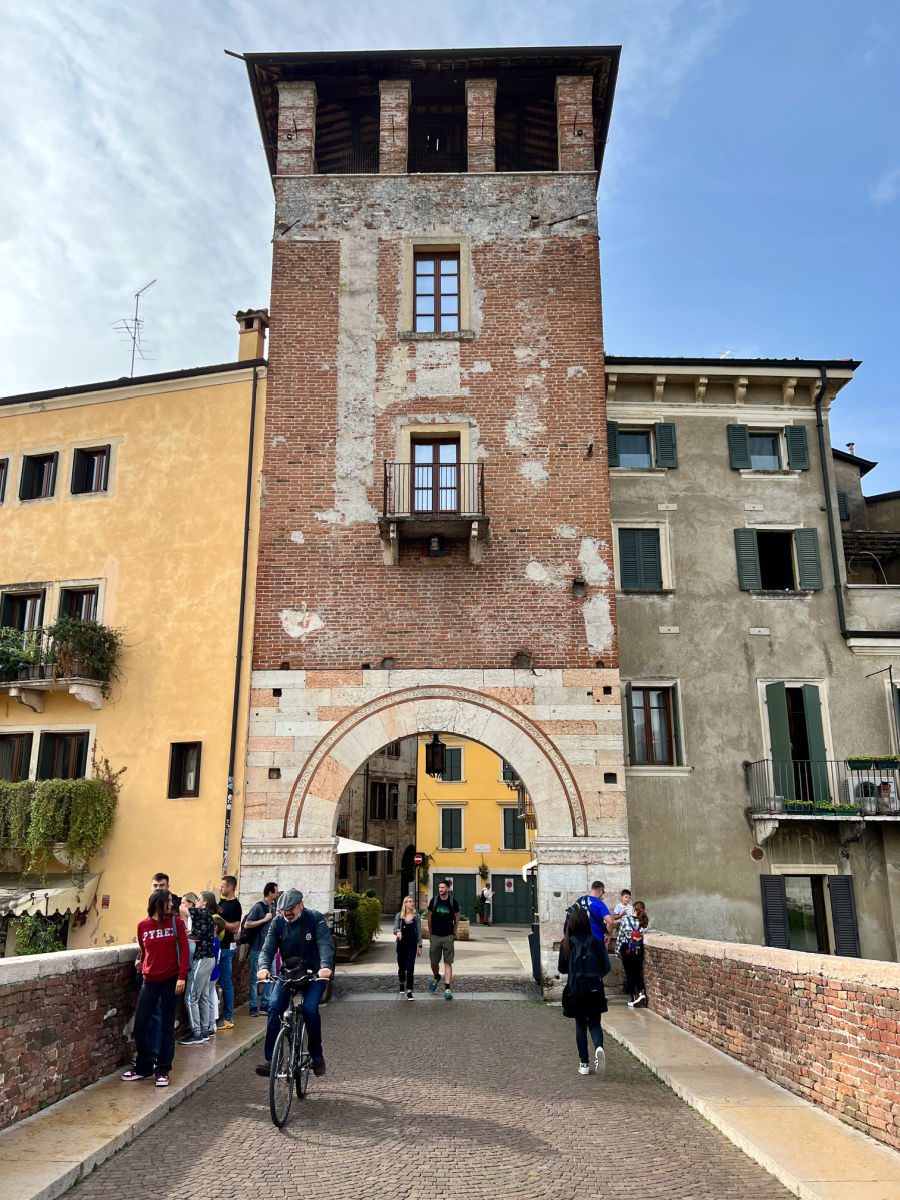
The Ponte Piedra is a stone arch bridge built by the Romans in 100 B.C. across the Adige River and it is the oldest bridge in Verona. This camel-hump-shaped bridge was nearly destroyed by the Germans in World War II but it was restored in the 1950s. Today, you can walk across this pedestrian bridge to reach the Roman Teatro. From the bridge, you have beautiful views up and down the river of the hills north of the city, and the entire area of Castel San Pietro and the Roman Theater.
Teatro Romano
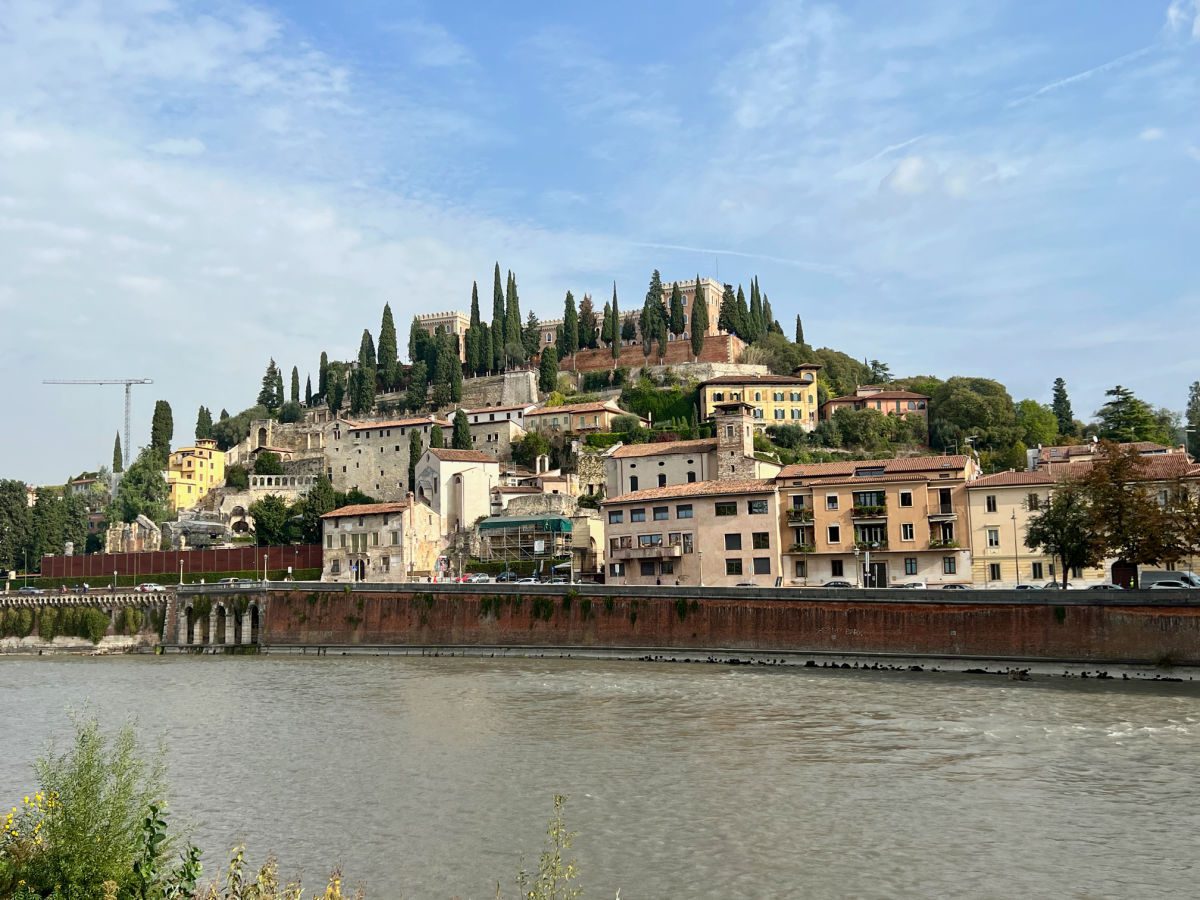
The Roman Theatre of Verona (Teatro Romano di Verona) was built towards the end of the 1st century B.C., at the foot of the Hill of St. Peter and overlooking the Adige River. These ancient ruins have been excavated and today you can see the remains of the stage, orchestra, open-air auditorium, and parts of two levels of seating. If you climb up to the overlook at Castel San Pietro, you can see the Teatro from above. When you are visiting Verona, check to see if there are any special events taking place at the Teatro in the summer, such as Shakespeare plays, concerts, or music or dance performances.
Piazzale Castel San Pietro
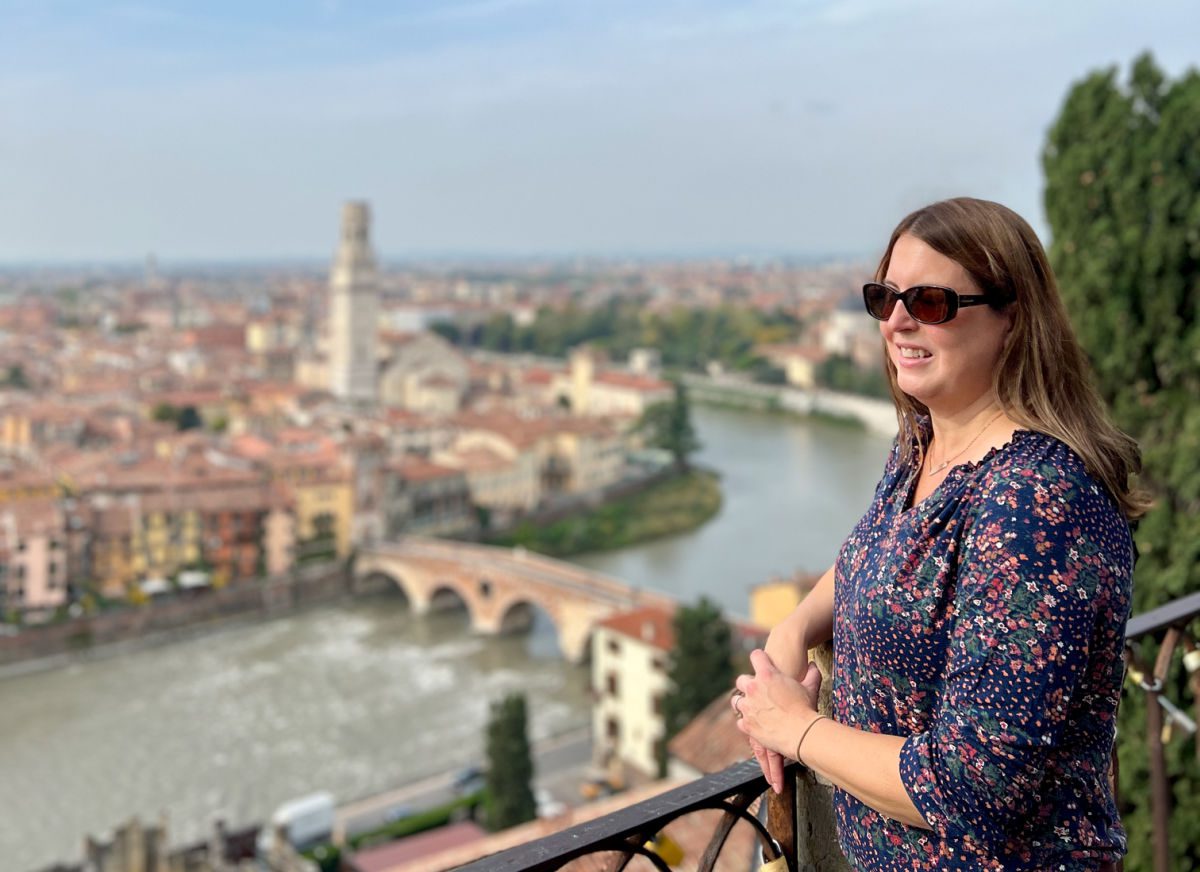
While you can’t visit the interior of Castel San Pietro, you can see it from the outside and there is also a little cafe on site that makes a nice spot for a coffee or snack. You can view Castel San Pietro from the outside, but the better view is that of the city from the panoramic viewpoint at Piazzale Castel San Pietro.
There are two ways to get there, you can take the Funicular . To reach the funicular station, go to the left after crossing the Ponte Pietra towards via Santo Stefano and the departure station is on the right. A rountrip ticket is 3 euro and a one-way ticket is 2 euro. Alternatively, if you have the energy, it isn’t a bad climb up the stairs to the viewpoint.
Castelvecchio
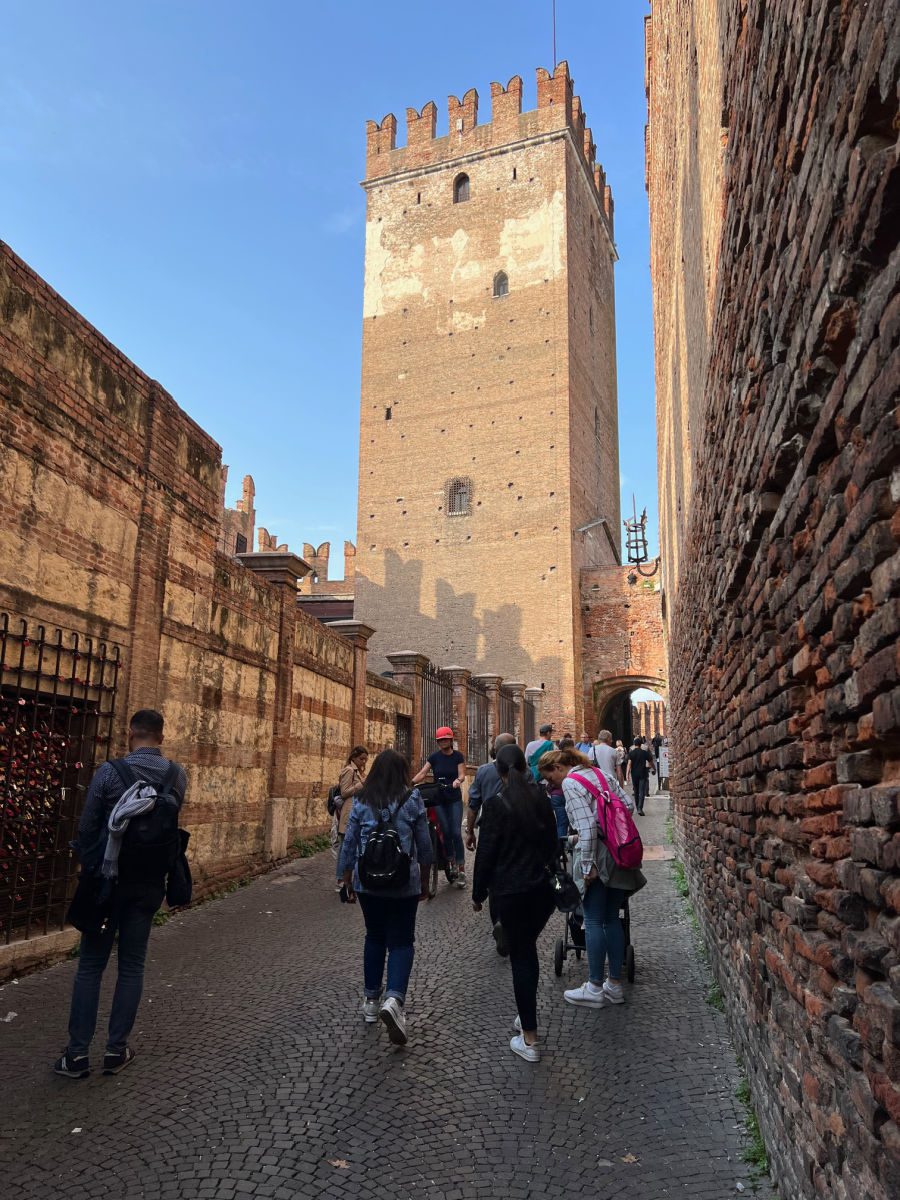
Castelvecchio, which means old castle, is a medieval fortress and the most important museum in Verona. Built in the 1300s by the Scaliger family that ruled the city in the Middle Ages, the Castelvecchio Museum houses important mediaeval, renaissance, and modern art collections (up to the 18th century) throughout 29 exhibition halls. A ticket to the museum includes access to the open rooms and the wall walkway.
In addition to the museum, you can walk across the Ponte Scaligero, a reconstructed arched bridge from the 1350s. Next to the museum, you can see the Arco dei Gavi, which is an ancient white-marble arch which was dismantled by the French and later reassembled in 1932.
Wine tasting

If the architecture and history doesn’t make you fall in love with Verona, than the food and wine certainly will. The region around Verona produces 15 DOC and 5 DOCG wines. Among the most famous are the Amarone della Valpolicella, Soave, Valdadige, Valpolicella, and Ripasso.
If you have extra time in Verona, you can take a wine tour of the region . However, if you time is limited, you can also arrange a wine tasting at a wine shop in town. I booked a wine tasting through Airbnb Experiences with Bruno of the Baraldi Winery at Via Roma 10, just a few minutes off Piazza Bra. Bruno was so friendly and knowledgeable, spoke excellent English and wasn’t at all pretentious. It was a very relaxed setting in his wine shop and I tried four wines, paired with a selection of meats and cheese over a one-hour period. If you are interested, I’d recommend reaching out to Bruno at Bacco Verona .
Veronese Food
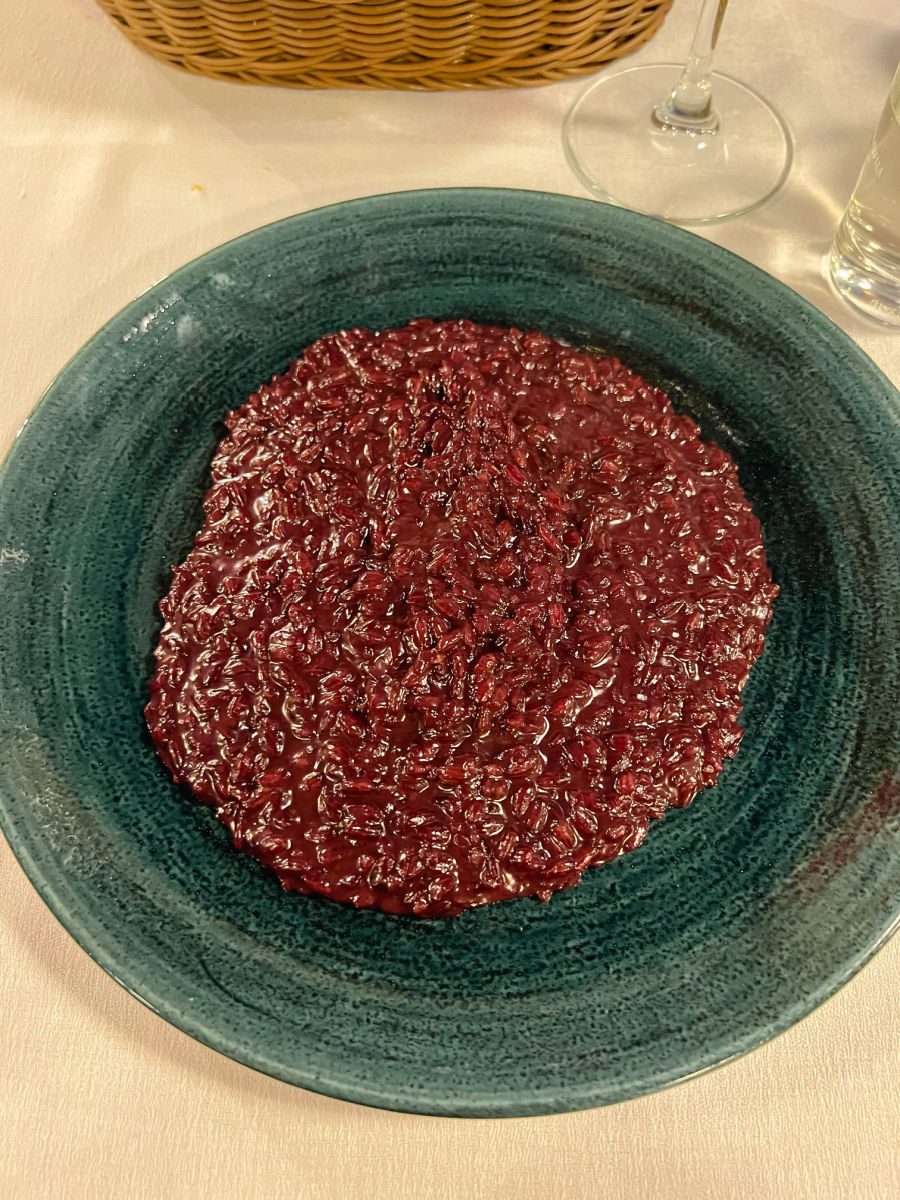
If you saw the movie Love in the Villa, you may recall the scene when Charlie fooled Julie into thinking she just ate horse? Well, that isn’t too far off the mark. Many menus in Verona will feature proteins such as horse, donkey, tripe, or a boiled meat feast made up of all sorts of parts I don’t want named. While that is not my cup of tea (I’m a foodie but still a fairly limited palate), I also had some of the best meals of my life in Verona.
Two restaurants that I would highly recommend are:
- Taverna di Via Stella at Via Stella, 5c, 37121 Verona: this small taverna has a wide selection of the meats mentioned above, but they also make an amazing Risotto Amarone, a Veronese specialty. This rich dish is made with at least half a bottle of pricey Amarone wine, so a minimum order of two people is required. That put me in a bit of a pickle as a solo traveler that really wanted to try this dish so I did what any foodie would do and ordered for two — one to eat and one to go and heat up in my hotel room the next day. I’ve since tried to recreate this dish at home but didn’t quite hit the mark so a return trip to Verona is needed just to eat this succulent risotto.
- Osteria da Ugo at Lungadige Cangrande 8, 37126, Verona: this osteria is a bit more upscale but still quite friendly and welcoming, especially when I went for lunch. I stuffed myself with a starter and a primi dish and wish I had a second stomach to fit even more because the food was outstanding. I started with the Piatto Lessino, which consisted of polenta with grilled mushrooms topped with asiago cheese wrapped in crispy broiled speck ham. I could have gone home right there but I had already ordered a second course of gnocchi made from polenta with a gorgonzola sauce. I’m not even typically a gorgonzola fan but it was just the right balance for the gnocchi.
Getting to Verona
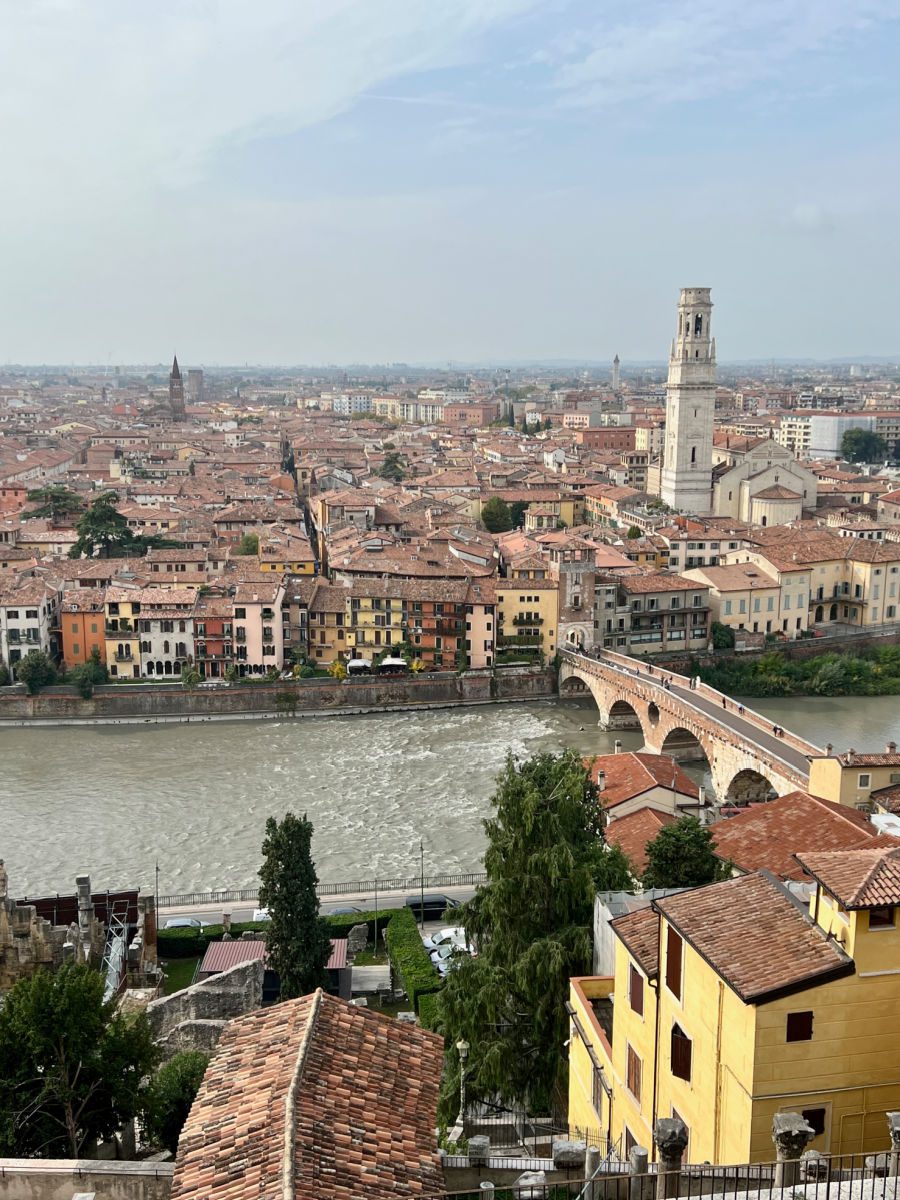
Verona is the in the Veneto region of Northeastern Italy, approximately 1.25 hours west of Venice and 1.75 hours east of Milan . The city is located on the Adige River, which curves around the historic city center with bridges crossing the river to the newer parts of town.
You can easily get to Verona via plane, train, or automobile. While there are no direct flights from the United States to Verona, you can connect through Europe to flights on a variety of carriers.
The closest airport is Valerio Catullo (VRN), located less than 7 km from the city. However, you can also fly into Milan, Venice, or even Bologna and easily get to Verona via train. Verona’s Porta Nuova train station is at the crossroads of the Rome to Brenner and Milan to Venice train lines, providing countless options for traveling around Italy. The train station is easy to navigate and not nearly as big as those in Bologna or Milan. Just remember that if you are purchasing a ticket at the train station, you need to validate it before boarding. If you pre-book a specific train with an assigned seat, this isn’t necessary.
Driving in Verona isn’t as challenging as in heavily populated or visited cities like Florence . However, once you arrive at your hotel, you will want to spend your time in town walking from place to place. There are some streets in the historic city center that are pedestrian-only so be sure to check with your hotel if they offer parking and the best way to reach the property.
Where to Stay in Verona
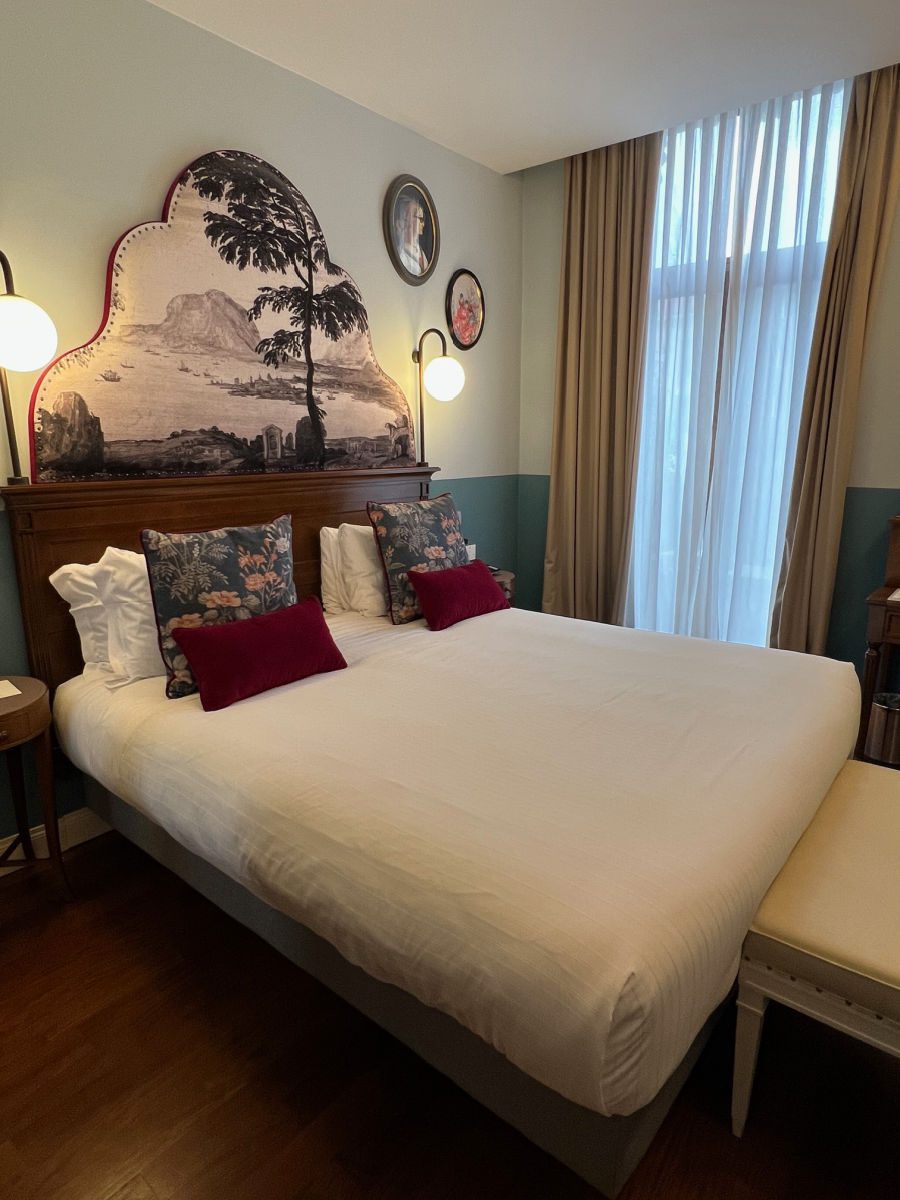
Verona is a very walkable city and I would recommend staying within a 10-minute walk to Piazza Bra. During my two-night stay in Verona, I stayed at the Hotel Indigo Verona – Grand Hotel des Arts . While not in the heart of the historic center, it was within an easy to both the train station and Piazza Bra, making getting into/out of and around the city very easy. It was also very affordable and offers an optional breakfast and has a hotel lobby bar. While the rooms were cozy, I found it quite pleasant.
Find other places to stay in Verona:
Day Trips from Verona
If you would like to spend a few days in Verona, there are many places that you can do as a day trip nearby. In addition to Venice or the wine tour mentioned above, you can go to:
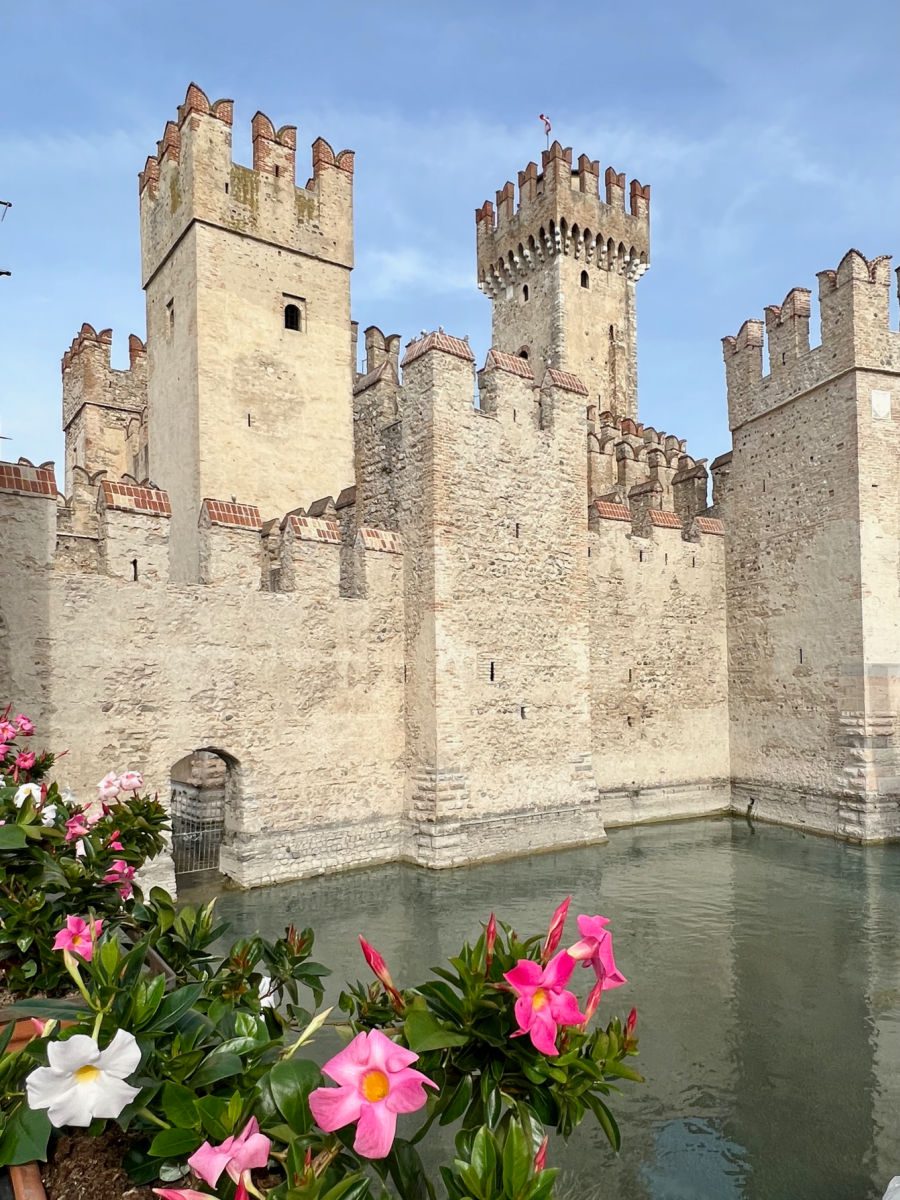
Sirmione is located at the southern tip of Lake Garda, less than one hour from Verona. There are many options for small group tours to Lake Garda if you don’t have a car. Sirmione is a charming medieval village located on Lake Garda, which is popular with British, German, Italian, and American tourists.
I visited Lake Garda after spending a few days on Lake Como and I have to say, I actually prefer Lake Garda. The aqua blue water is just stunning and the town’s cobblestone streets and shops draped in bouganvilla offer instant charm. In addition to taking a boat cruise and exploring town, you can also tour the lakeside Scaligero Castle.
Borgo sul Mincio
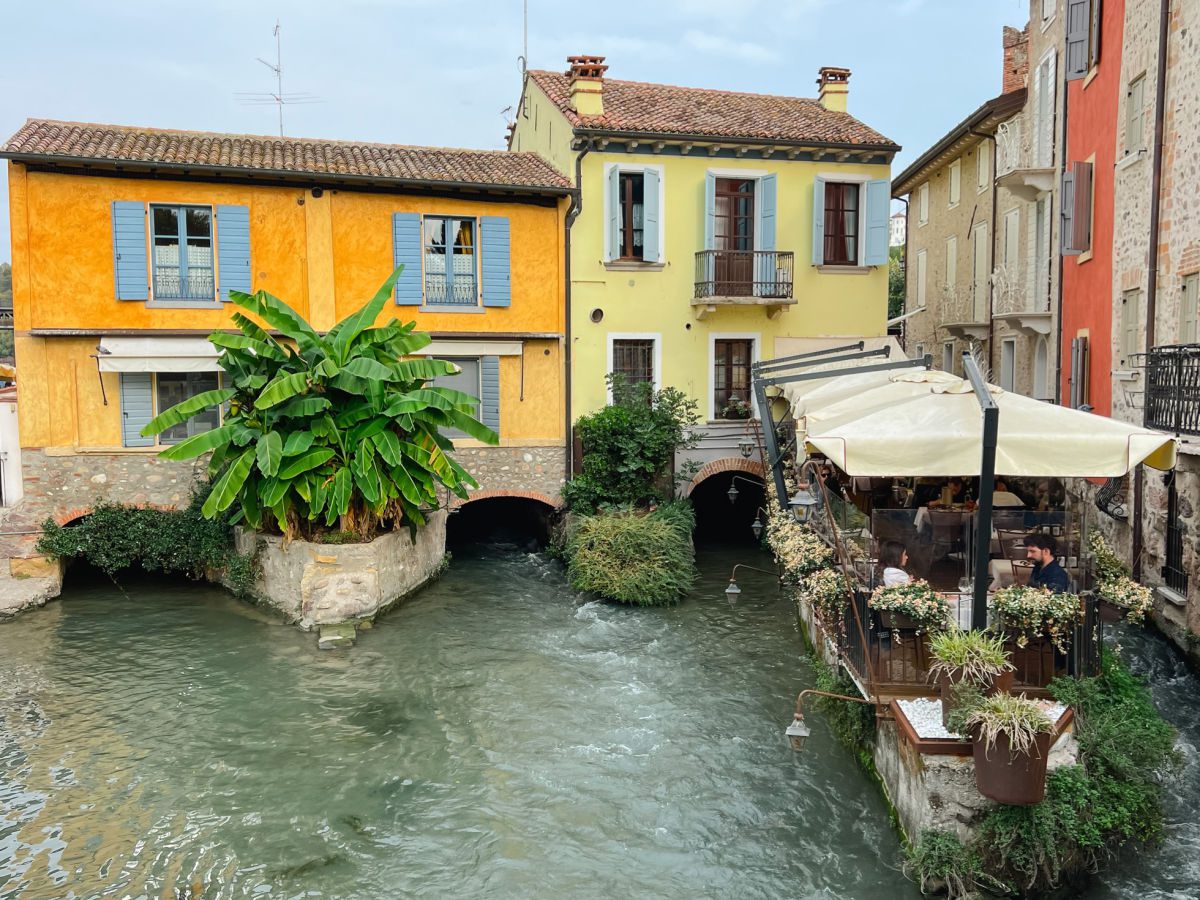
Borgo sul Mincio is a teeny, tiny town that is popular with Italians but relatively undiscovered by American tourists. Located less than 40 minutes from Verona, it is easy to visit on a half-day trip. This fairytale-like town is situated on the Mincio River, with a small borgo on one side and a slightly larger town on the other, connected by a pedestrian bridge.
In addition to enjoying the atmosphere of the town, you can walk across the Visconti Bridge, watch the swans swimming in the river below Cafe San Marco, toss a coin in a waterwheel that used to power the mills, have lunch at one of the outdoor cafes along the river, walk across the Ponte di Legno Bridge, and walk up to Castello Scaligero, which dates back to the 1300s.
Things to know About Verona
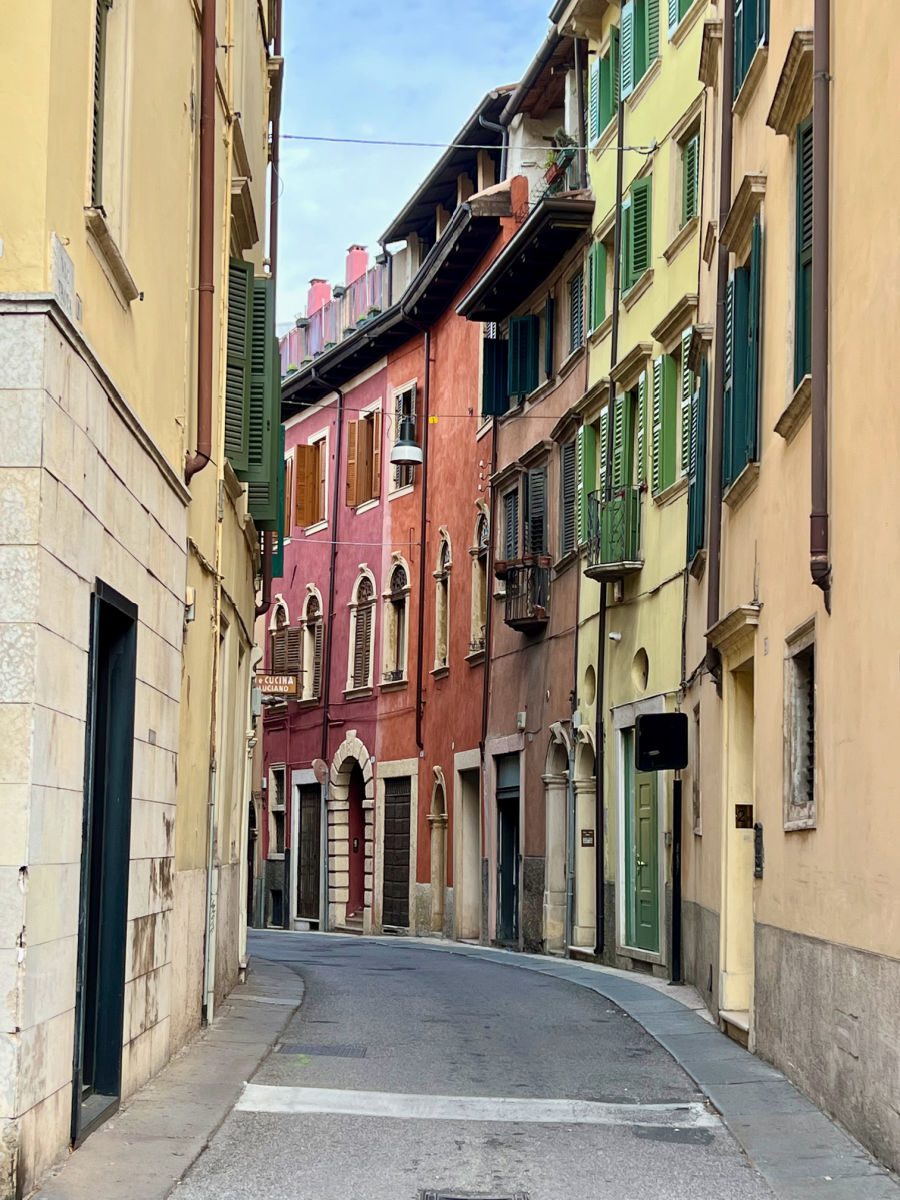
Best Time to Visit Verona
Verona is a very popular tourist destination in Italy, so if you can visit during the shoulder seasons from April-May or September-November, you will still have pleasant weather but fewer crowds. Verona hosts many events and festivals throughout the year that you may want to make note of including:
1. Verona Carnival is one of the oldest carnivals in Europe, known as Bacanal del Gnoco . Taking place in the lead up to Lent, it is still traditional in Verona to eat gnocchi on the last Friday before Lent. If you are in town, in addition to gnocchi you can enjoy the pastries baked for the festival including fritters and galena (thin pieces of fried batter.) 2. February is the most romantic time of the year in Verona with Verona in Love , the event dedicated to lovers from all over the world which is held to mark Valentine’s Day. Businesses across Verona put on special events or offerings like romantic dinners, movies, markets, and musical performances. 3. If you visit Verona for the holidays, Piazza dei Signori (also known as Piazza Dante) and the Courtyard of the Mercato Vecchio, the old market host a Christmas Market from mid-November until 26 December. Also don’t miss the Feast of Saint Lucy , celebrated on 13 December in Piazza Bra. 4. The world-renowned Verona Opera Festival runs from mid-June to early September in the Arena di Verona, which is a stunning setting to see the opera. 5. During the summer, Verona’s Teatro Romano (different than the arena), is also host to many performances including Shakespeare plays, jazz, and dance performances. 6. In September, Verona hosts Tocati, a festival that combines games, watching folk music performances from far-off countries, sampling their food and rediscovering old traditional games. 7. In October, the city hosts ArtVerona , a fair for modern and contemporary art.
Romeo and Juliet Are Not Real
It is thought that Romeo and Juliet was based on a local legend, which was written about by many authors before Shakespeare made it famous. It is thought that Shakespeare heard about these star-crossed lovers in Arthur Brooke’s 1562 poem entitled “The Tragical History of Romeo and Juliet”. Prior to Brooke, this story was written about by Italian writers, including Luigi de Porto and Matteo Bandello, who told the story of Romeo and Giuletta and the deadly feud between the families Montecchi and Capelletti. These names are also mentioned in a verse of Dante’s Purgatory. There is also a theory that Shakespeare may have gotten inspiration from a book by Christopher Marlowe. What we do know is that while Juliet Capulet is a fictional character, “Juliet’s House” in Verona was once inhabited by the Cappello family and dates back to the 13th century.
Yes, Verona is Better Than Venice (In Some ways)
There is no place quite like Venice so while it is hard to compare Verona and Venice, there are many reasons why I liked Verona better. First, it is not nearly as crowded as Venice, making visiting a much more pleasant experience. Second, while Venice feels so overrun with tourists and souvenir shops, Verona has a more authentic feel and it is easier to get to see the “real” Verona.
Should You Go To Bologna or Verona (Why Not Both?)
Bologna and Verona are only an hour apart by train and it is easy to do both on a trip to Italy. If you have to choose between the two, it would depend on what you are looking for. Bologna is a larger, university city that is bustling and at times, a bit chaotic. But it is known as a food city and attracts foodies from around the world to sample the goods of the Food Valley. Verona is quieter, more charming, and more focused on historical attractions.
Verona is Affordable
I was able to stay in a nice room with a balcony, just a 10 minute walk to Piazza Bra for only $150 per night. This would be much harder to do in Rome. Overall, I found Verona very affordable.
Visiting Italy? Read more…
- Find out how much a trip to Italy costs
- Get tips for driving in Italy
- Get itineraries for Rome , Florence , Venice , Bologna , Parma , and Milan
- See tips and things to do in Ravello , Cinque Terre , Siena, Assisi
Save this to pinterest
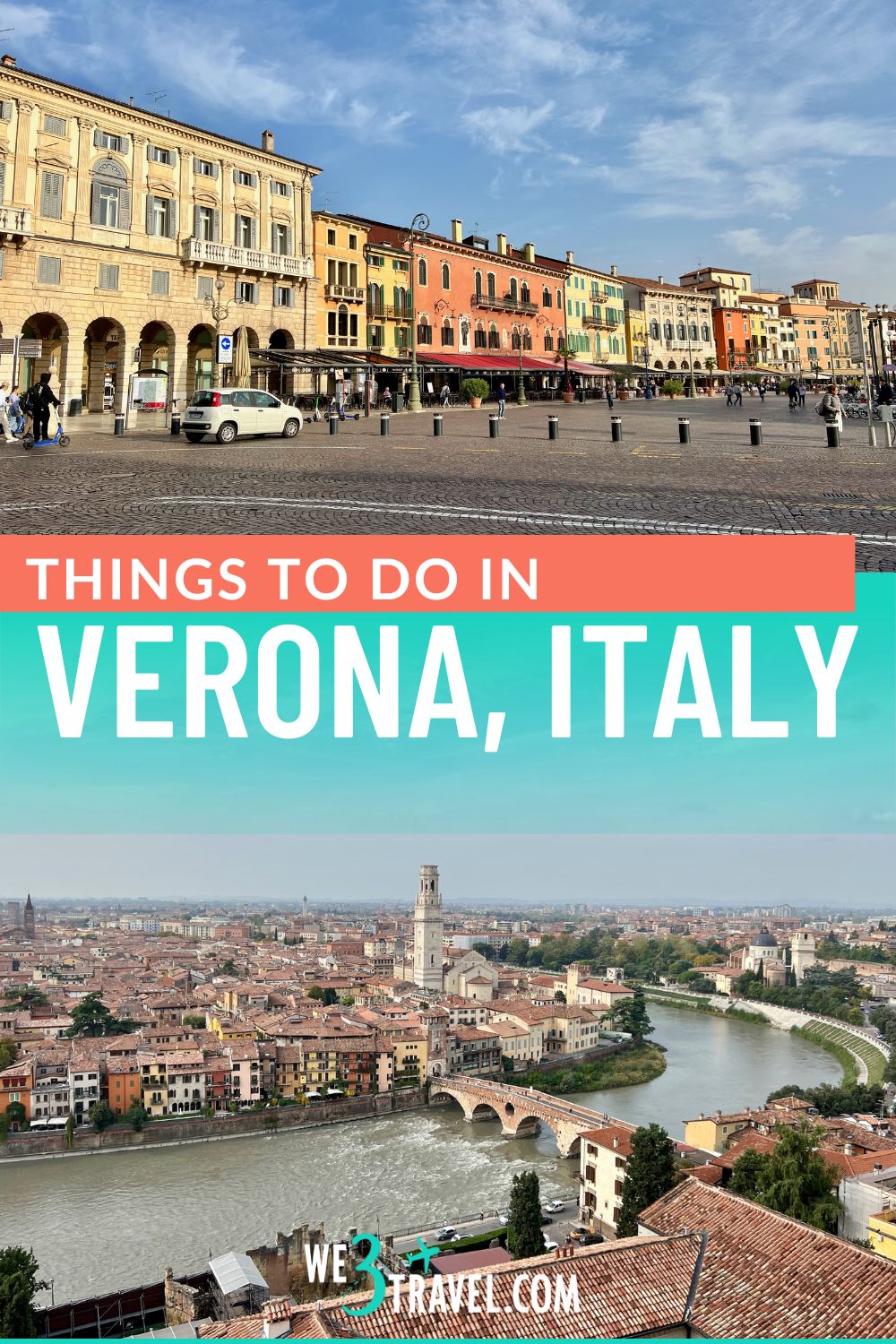
Tamara Gruber is the Founder and Publisher of We3Travel. A former marketing executive and travel advisor, Tamara is an award-winning travel writer and recognized expert in family travel. Tamara is a member of SATW and the Adventure Travel Trade Association, and serves on the Board of the Family Travel Association. She is also the publisher of YourTimetoFly.com and the co-host of the Vacation Mavens travel podcast.
Find this useful? Share it!
Publish Date: November 26, 2023

SIGN UP FOR OUR NEWSLETTER & RECEIVE A FAMILY VACATION PLANNING KIT!
We3Travel.com will use the information you provide on this form to send you newsletters. You can unsubscribe at any time by clicking the link in the footer of any email you receive from us, or by contacting [email protected] . By clicking below, you agree that we may process your information in accordance with these terms.

Start typing and press enter to search

The Perfect 2 or 3 Days in Verona Itinerary
Last Updated on January 22, 2024
by Olivia Ellis
Disclaimer: This article contains affiliate links. That means if you click a link and make a purchase, we may make a small commission. As an Amazon Associate we earn from qualifying purchases. For more information, see our privacy policy.
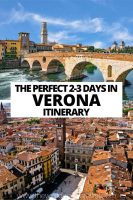
Verona is truly one of the most enchanting medieval cities in Italy which makes planning a Verona itinerary one of the best things to do when visiting Northern Italy.
The city is the home of Romeo and Juliet, has incredible landmarks, and is the beginning of a wonderful off-the-radar trip in the Veneto region. Many skip Verona and head to Venice instead, but spending time in Romantic Verona is a wonderfully pleasant experience in itself.
Verona itself is quite small, making 2 to 3 days in Verona sufficient to then make your way to explore the surrounding areas and region.
Table of Contents
How Many Days in Verona?
If you’re wondering how many days to spend in Verona but only have one day to allot for seeing the city, you’ll still have enough time to experience the main sights and enjoy the splendor that Verona has to offer.
If you have 2 days in Verona, you will be able to see the vast majority of the site the city has to offer at a fairly leisurely pace.
This way you’ll have enough time to explore the city center, acquaint yourself better with the city and local ways, and not be too tired to continue a trip.
For those who are able to budget 3 days to visit Verona, you will also be able to have some time to explore some highlights nearby, such as on a day trip to beautiful Lake Garda.

Getting To & Around Verona
Getting to the city center is quite convenient whether you’re flying in or taking a train, making it a perfect short trip or weekend destination.
If you’re flying into Verona, you’ll most likely be arriving at the Valerio Catullo Airport. The Verona airport is located 10 km southwest of the city center and offers a few international routes yearly, frequent Italian routes as well as many international summer routes.
If you prefer to skip the hefty cost of a taxi into the city, take the Verona Airport bus ATV that will bring you directly to the Verona Porta Nuova train station in just under 20 minutes.
From here it’s about a 15-minute walk into the city center but there are also plenty of local bus options as well. Tickets for the shuttle are €7 and can be purchased either online , at the airport, or on the bus.
For those taking the train into Verona from any other Italian city (or maybe even another country), the Verona Porta Nuova station is well-connected with the Trenitalia and Italo train lines.
You can reach Verona from Milan in under an hour and a half, Verona from Venice in an hour, and Rome to Verona in a little over 4 hours. Upon arrival at the train station, the magical city center is only about a 15-minute walk away. You can view train schedules here.

2 to 3-Day Verona Itinerary
On this itinerary you’ll fully experience everything that the city (and maybe outside) has to offer. From feeling the fairy-tale ambience at the home of Romeo and Juliet to the gorgeous gardens and nature the city boasts, you’ll be glad that you gave this city a chance.
If you want to learn more about the city with a guide consider taking a tour such as this history tour , this food tour or this winery tour depending on your interests.
Day 1 – The City Center
While the city center of Verona isn’t incredibly big, it has a grand feeling to it. Just walking along the Adige river and seeing the mountains that surround you makes you feel like you’re in a different time.
Day 1 will take you through the main sights of the city center and offer a wonderful first day and stroll through the city of Verona.
Torre dei Lamberti
Start your day with an incredible panoramic view from atop the Torre dei Lamberti – or the Lamberti Tower in English. Located in Piazza delle Erbe in the city center, this medieval tower provides incredible views of the adjacent Piazza dei Signori, the Verona Cathedral, the Verona Arena and more.
Built in the 12th century, this is the tallest tower in Verona and it is truly a focal point of the city’s skyline.
There is a small entry fee to get to the top of the tower, however, there is also an elevator so you don’t need to climb hundreds of rickety steps and can conserve your energy for your further Verona exploration. You can pre-book tickets here or they are included with a Verona Card which includes access to several attractions in the city.
There is no denying that starting your day with this kind of view is one of the best things to do in Verona.
Before making your way to the next stop, make a pit stop in Piazza dei Signori to take in the Scaliger Tombs, an above-ground mausoleum for the Scaligeri family dating back to the 14th Century.
Juliet’s House “Casa di Giulietta”
Directly in the center of the city on Via Cappello, you’ll find the Casa di Giulietta. While the story of Romeo and Juliet as we know it, written by Shakespeare is fictional, the house that he took inspiration from isn’t, as well as the sentiments people bring to it today.
Juliet’s House and most famously, her balcony, are easily one of the main attractions to see when visiting Verona. Ironically, the balcony itself wasn’t added to the house until the 20th century, whereas the house dates back to the 13th century. Just below the balcony is a golden statue of Juliet herself, and the fable has it that if you rub the statue, love is on its way!
Inside the house, you’ll find a museum that offers abundant information on the Romeo and Juliet tale as well as the building. The house itself is also decorated in an accurate 16th-17th century style to reflect what it was like in the era of Romeo and Juliet.
It’s quite an inspiring and touching place to be, witnessing lovers and hopeless lovers visit the statue, leave their notes, and ask Juliet for her love advice.
While it’s free to enter the courtyard and see the balcony, there is a fee to enter the museum. Keep in mind to arrive early and wait in queues as this is an extremely popular attraction with very little space.

Arena di Verona
It isn’t a trip to another Italian city without some sort of arena, is it? Located in the main square of central Verona, Piazza Bra, you’ll find the third-largest Roman amphitheater, with a maximum hold of 25,000 people.
Built in 30 CE and made of 44 levels, the Verona Arena truly encompasses the mass level that ancient Rome lived and built society. Just like any other ancient Roman arena, the Verona Arena was mainly used for gladiator games, and visiting the arena itself offers an unreal experience picturing the way things once were.
The arena itself is quite impressive just to look at from the outside but is also incredibly worth it to pay the admission fee to wander around the inside of it. With just 2 days in Verona or 3 days in Verona, the arena is somewhere that can’t be missed!
Tickets to enter the arena can be purchased on-site or alternatively, you can purchase a Verona Card that gives you priority access. It is also possible to organise a guided tour here.
Opening hours vary seasonally as well as the day of the week & whether or not a show is scheduled.

Verona Cathedral
After about a pleasant 15-minute walk from the Verona Arena and through the center, you’ll find yourself at the Verona Cathedral (or Duomo Santa Maria Matricolare). While this cathedral isn’t as immaculate as many of the others in Italy, it still holds many gems to be explored inside.
This Romanesque-style church was first built in 1187 and still proudly stands as an important part of the city of Verona. Inside you’ll find the pediment, as well as an interesting feature, the library. To this day, the library of the Verona Cathedral is known to be one of the oldest libraries still in rotation today, including various ancient texts!
Whether you’re someone keen on visiting churches or not, even just exploring for a quick walk around is a beautiful experience.

Osteria il Bertoldo
A great way to wrap up your first day in Verona is at the delicious Osteria il Bertoldo. Located just a few minutes away from the Verona Cathedral is a deliciously classic Italian meal.
From a cozy atmosphere, friendly service, and delicious local foods, you’ll likely want to return for more!
Day 2 – Dig Deeper in Verona
Castel san pietro.
After grabbing your morning coffee and pastry (Verona is known to have exquisite cornettos and pastries), the perfect place to start your second day is with another breathtaking view of the city – at the Castel San Pietro.
Located across the Ponte Pietra, this Romanesque fortress is an excellent place to visit. If you’re up for a bit of a hike, it takes about 20 minutes from the base of the fortress to reach the top. Alternatively, there is a cable car that you can ride for a small fee.
The fortress itself may not be that interesting, however, the views are absolutely unbeatable as you will be able to get a full view of the old town of Verona and get more of a panorama that you were from the Lamberti Tower.
Palazzo Giusti and Giardino Giusti
The next stop on your second day is the Palazzo and Giardino Giusti – or the Giusti Palace and Gardens in English.
The palace and gardens are located on the east end of Verona and are a beautiful component of the city. The palace was built in the 16th century and the garden was planted in 1580, and while they’re known to Verona quite well, they’re a hidden gem on a tourist radar.
The garden is known to be one of the best examples of a classic Italian garden and is also known as one of the best Renaissance gardens in all of Europe. Once entering and exploring the large gardens, you’ll feel as if you’ve fallen into a medieval fairytale.
As for the palace, the majority of it is closed off but one section is kept open for visitors and is included in the gardens admission ticket. Tickets include an audio guide for your visit.

Ponte Scaligero (Castelvecchio Bridge)
Just about a 25-minute walk away from the Giardino and Palazzo Giusti, you’ll arrive at the Ponte Scagliero. The Ponte Scagliero is a fortified bridge linking the Citadella neighborhood to the Borgo Trento.
Built in the 1350s, and at the time, had the largest span of any bridge in the world (it’s quite small, so imagine that!) The bridge was destroyed in 1945 by retreating German troops but was luckily rebuilt in 1951.
Castelvecchio
Directly across from the Ponte Scagliero is the Castelvecchio, meaning old castle. The Castelvecchio is the most influential military building of the Scaliger dynasty and is also an important icon representing the history of Verona.
The castle was built in 1355 by the Della Scala family, the head of the Scaglier dynasty and the leading family of Verona in the middle ages. The castle was also damaged during World War 2 but was also renovated in the way we see it today.
In the Castelvecchio museum, you’ll find Romanesque and Gothic sculptures as well as old gothic paintings such as Pisanello with his Madonna of the quail, which are crucial to the history of Verona.

Basilica di San Zeno Maggiore
Not far at all from the Castelvecchio Bridge, you will find the imposing Basilica di San Zeno Maggiore. This gorgeous Romanesque-style church is well worth a visit if you’re spending 2 days exploring Verona.
The exterior of the church itself is gorgeous and beautiful to take in, however, it is known for its incredibly ornate frescoes within the interior of the church so definitely make sure you venture inside the building, as well.
For those visiting Verona because they’re Shakespeare fans, the basilica’s crypt is said to be the place the Bard set for Romeo and Juliet’s wedding.

Day 3 – Day Trip to Lake Garda
While Verona is a gorgeous city full of things to do, the Veneto region is rich in nature as well as culture. On day 3, we will head out to the famous Lake Garda for some fantastic views, and weather depending, maybe a swim.
Lake Garda (Lago di Garda) is Italy’s largest lake and should certainly be on your travel radar. From its picturesque villages to cobblestoned streets and wonderful food, Lake Garda is truly special.
To reach Lake Garda from Verona, you can easily take a train from Verona’s Porta Nuova station. Two of the towns on Lake Garda have train stations so you can take a direct train to either, these are; Desenzano del Garda and Peschiera del Garda.
They are just about 15 km away from each other as well as between 13-23 minutes away from the city center of Verona.
There are also many options for guided tours such as this full-day tour.
Desenzano del Garda
Desenzano del Garda is about a 25-minute train ride away from Verona with train tickets costing just 5 euros each way with trains just about every hour. The town has been a popular tourist location for thousands of years and offers lovely walks and views as well as food.
Take a walk along the harbor and maybe even visit the Bronze and Stone Age museum. A great way to wrap up your day is by enjoying a meal by the water at the wonderful La Taverna del Garda.
Peschiera del Garda
If you’re looking for a closer day trip, Peschiera del Garda is a great option. Just 13 minutes away by train, with tickets at just 3 euros and trains departing every 20 minutes, Peschiera del Garda is a delight.
Peschiera del Garda is a charming town with old winding alleys, beautiful flora, and colorful boats. The town has two parts; the new town, and the old town located within the fortified walls of the town.
I recommend visiting the Fortress of Peschiera del Garda, as it is its own UNESCO World Heritage Site truly worth the visit.

Where to Stay in Verona
Hotel Giulietta e Romeo – This 3-star hotel is an excellent choice for those looking for a mid-range option in Verona. They have a range of lovely rooms on offer and a great, central location for exploring the city.
Hotel Accademia – Those after a bit of luxury in Verona are sure to love this plush hotel. They have a number of beautiful, luxe rooms on offer, plenty of wonderful amenities and a perfect location for exploring all the city has to offer.
Opera Relais De Charme – If you’d like to have your own space while in Verona, then this aparthotel is a great option. It is centrally located and they have a range of apartments to choose from in varying sizes to suit all kinds of travellers.
The Hostello – If you’re travelling solo or are more budget-conscious, then this hostel is a great choice. They have a range of both dorms and private rooms available, a great location and plenty of common areas and self-catering facilities.
Not quite what you’re looking for? Click here to browse more Verona hotels!
Whether you’re someone already with knowledge and desire to go to Verona, or it’s somewhere new on your travel list, it truly is the epitome of medieval Italy. Enjoy this Verona itinerary and make special memories in and around the city. The views, the food, and the city are undoubtedly going to make you want to come back for more.
Are you planning on visiting Verona? Have any questions about the city? Let us know in the comments!

Related Posts:

The Perfect 2 to 3 Days in Bologna Itinerary

The Ultimate 1, 2 or 3 Days in Catania Itinerary

Florence or Venice: Which Italian City to Visit?

About Olivia Ellis
Olivia is a writer for The World Was Here First. Originally from Michigan, USA, she is currently living in Athens, Greece exploring Europe and filmmaking. When she’s not travelling or writing, Olivia can be found cooking delicious new recipes from around the world, reading, and spending time outdoors.
Hi Olivia Great article about 2-3 days in Verona. Apart from the usual tourist sights that you mention,is there much else to do in the city…we simply enjoy walking cities and stumbling across things as we come upon them…in addition my wife really loves shopping….is there a main shopping area? Or other lesser known streets with more independent retailers? Many Thanks John
Leave a Comment Cancel reply

Is Verona Worth Visiting? 10 Reasons Why You Must!
When planning their next trip to Italy, lots of folks seem to wonder “is Verona worth visiting?”. Despite its stunning cityscape and extremely rich history, the birthplace of literature’s most famous couple (Romeo and Juliet) is often overlooked by foreign visitors.
That’s what I’m here to fix today!

How? It’s simple: I’ll give you 10 different reasons why there’s no answer but yes to the question “is Verona worth visiting?”.
Before that, though, I’ll make up for my bias by letting you know why a few people choose to skip it instead.
Why some travelers avoid Verona
There are other destinations in italy they’d rather visit first.
Verona faces unfair competition both at the national level and within its own region as well. The city is a 90-minute drive away from Venice and about two hours from Milan.
While that also means the city is perfect for a day trip if you’re staying in the area, Verona is consistently overshadowed by its more exuberant neighbors.

To be fair, I’m not saying Verona should have the upper hand over Italy’s top attractions. Yet you can easily make room for it on a second trip to the country, for example.
Speaking of which, there’s something else you should try for a full Italian experience. Pick one large city, a couple of midsize ones, and a few towns if you have the chance to be in the country for longer than a week. That way Verona can definitely fit into your plans.
The nightlife scene isn’t particularly busy
Granted, Verona is not really the kind of town you’d normally head to if you wanted to dance the night away. It does feel like a small city, as the majority of streets get quite empty after dark.
That said, the city is dotted with bars and clubs that sometimes close as late as 4 p.m. (though 2 a.m. is more common). On top of that, its Roman arena hosts a world-famous opera festival in the warmer months.

The historic core and the area known as Veronetta on the other side of the river are where you should go in case you’re looking for a fun night out.
But not even at Piazza Bra (pictured above), the city’s main square, folks linger for too long come nightfall.
Why is Verona worth visiting?
1. it’s a unesco world heritage site.
The story of Verona’s founding and the origin of its name are uncertain; that’s how ancient it is. We do know, however, that it was settled in prehistorical times.
Sitting at the crossroads of the Alps and the Plain of the Po (Italy’s longest river), it worked as a sort of checkpoint between the Latin and the Germanic realms.

The strategically located city and its surroundings have been fought over by kingdoms and dynasties for 2,000 years, which has left its mark on a set of fortresses and Verona’s primarily medieval building stock.
And that’s not all: Verona’s cultural scene has always been thriving, to the point that the city has often been praised as a Florence of the northeast. Every corner in town exudes history and erudition so intensely that even the more clueless visitors feel inspired.
2. Romeo and Juliet were born there
Well, maybe born is a bit of an overstatement, but the fact remains William Shakespeare’s legendary play (as well as the more obscure The Two Gentlemen of Verona ) is set in the city.
Romeo and Juliet’s impossible love turned Verona into a much sought-after stop among local and foreign couples alike, alongside Venice and Florence.

Nobody can tell for certain whether Shakespeare ever visited Verona. Yet there’s a balcony in the historic core that went on to be nicknamed “Juliet’s balcony” (although the story of the house is controversial).
A bronze statue of Juliet placed in the courtyard in the 1960s became more popular than the balcony itself, as people took to rubbing its right breast to be able to go back to Verona (or so superstition says). No wonder the right breast looks weirdly smaller than the left one!
3. You’ll marvel at the ancient walls and gates
Verona boasts an astonishing five different walls built between Antiquity and the 1800s to protect the city. Several of the city’s rulers (the Della Scala Family, the Venetians, and the Austrians) expanded a defense system first adopted by the Romans.
A handful of ruins of the original imperial walls are still standing (including two gateways, the magnificent Porta Borsari and the more modest Porta Leoni). The most impressive set of walls, however, is the one erected by Veronese authorities in the 13th century, which is visible through the whole eastern section of downtown.

It used to reach Castelvecchio, a beautiful medieval fortress that is complete with a moat. Verona has even a fortified bridge linking Castelvecchio to the other side of the Adige river (seen on no. 1).
The city’s romantic vibes both contrast sharply and fit seamlessly into its imposing and warring past. Thank God the Capulets and the Montagues lived within the walled city, or their brawl could’ve cost Verona its architectural heritage!
4. It’s a very walkable town
Regardless of your physical condition, Verona will welcome you. It’s true that the northern end of town is surrounded by hills known as Torricelle; this is the foothills of the Alps after all.
Yet the only attraction you’re likely to visit in that part of Verona is Castel San Pietro, a medieval fortress where you can get superb views of the entire city. There’s no need to walk uphill, though, since an elevator will take you up there.

The city center, in contrast, was laid out within a dramatic bend of the Adige river, which means it’s almost flawlessly flat.
What’s more, unlike the bulk of Italian cities, most streets follow a strict grid plan. So you’ll have to go out of your way to get lost here.
And the best part is the two banks of the Adige are lined with extensive riverwalks that you can stroll along for hours as a cool breeze blows.
5. You’ll be close to countless must-sees in northeastern Italy
Verona is midway between Milan and Venice , which again makes visiting really easy if you’re dropping by either of these cities.
It’s also pretty close to the Alps and South Tyrol, Italy’s picturesque German-speaking region.

Within a one-hour-drive range, you’ll have the chance to discover dazzling towns like Vicenza, Mantua, Padua, and Brescia, each with its own set of UNESCO World Heritage Sites.
Most importantly, the Province of Verona is home to a great deal of Lake Garda (pictured above), Italy’s largest and a fantastic and relaxing destination year-round.
Trust me when I say Verona isn’t an end in itself but a gateway to the rest of northeastern Italy!
Also read: 16 Exciting Day Trips from Verona Worth Doing
6. The views from above are breathtaking
The hills surrounding Verona seem to have been created on purpose to offer unimpeded views of town. They’re located right outside the city center and aren’t too tall, so you’ll get to watch everything in detail.
The most popular viewpoint is Castel San Pietro, a 19th-century Austrian barracks that stands at a site first settled for defense purposes during the Iron Age.

For a more central vantage point, you can walk up the medieval Torre dei Lamberti at the heart of downtown and have the entire city at your feet.
From up there you’ll have a commanding sight of bustling Piazza delle Erbe, where an ancient forum was replaced by an open-air market as the centuries passed.
7. The Verona Arena is probably the best-preserved of them all
The Verona Arena has been the city’s ultimate symbol for circa 2,000 years. Like the majority of such venues across the Roman Empire, it was abandoned at some point between the Christianization of Europe and the onset of the Middle Ages.
Yet unlike most other arenas, it was given new roles throughout the centuries (i.e. hosting jousting tournaments and the burning of alleged heretics at the stake) and started being hailed as a city icon as far back as the 15th century.

Local authorities then closed the structure to the general public (which helped protect it from further decline) and even took on the upkeeping of its interior by the 17th century, something unheard of at the time.
In 1913, the arena went on to find its current use as host of an internationally acclaimed opera festival that has since taken place each summer, as well as of concerts year-round.
Apart from that, you can always tour the building during the day, learn about its two-millennium-old history, and marvel at the monumentality of the whole thing.
8. Verona is the unofficial capital of Italian wine
The Province of Verona accounts for 14% of the output of wines with a protected designation of origin nationwide, which means this is wine country at its finest. Two of the region’s quintessential wines are Soave and Amarone della Valpolicella.

Verona also hosts the biggest wine fair on the planet, Vinitaly, where 4,000+ wineries from around the globe showcase their labels. While the event is not open to the general public, it gives an idea of how Verona is all about that booze.
You won’t miss out on Vinitaly, though, as the city is jam-packed with top-notch wine bars, agencies offering wine tours and tastings, and eateries whose wine list can make any Michelin-starred restaurant jealous.
Also read: 10 Best Tastings and Wine Tours in Verona to Experience
9. Yet it’s not overrun with tourists
Verona is the 19th-most visited city in Italy, behind the more famous destinations and a bunch of mountain towns and seaside resorts.
But while Venice welcomes almost 13 million tourists a year, Verona barely receives 3 million of them — despite being roughly the same size as its island neighbor.

So apart from the obvious sights such as Juliet’s House and the Arena, the streets of Verona are teeming with a deliciously ordinary city life revolving around regular shops instead of souvenir stalls.
Exploring the city feels even more pleasant as you’re not constantly reminded your stay is bound to end in a few days by flocks of tourists zipping past you.
10. The cuisine is to die for
Because it has been influenced by the culinary traditions of Venice, Milan, and neighboring Austria (which actually ruled the city between 1815 and 1866), Veronese cuisine is both hearty and refined.
As in other parts of the country (such as Tuscany), many of the recipes were created by poor farmers, which is why ingredients like risotto and cornmeal feature prominently.

Verona’s best-known recipe is pandoro (seen above), a Christmas cake whose name literally means “bread gold”. Pandoro and the Milanese panettone vie for the title of ultimate Christmas dessert in northern Italy.
For a taste of authentic Veronese food, you’ll want to head to either a trattoria like Trattoria Da Camillo or an osteria like Osteria Nori. That’s what fairly priced restaurants specializing in local cuisine are called in Italy!

So is Verona worth visiting? How do you feel about it? Unless it’s a matter of priorities rather than worth to you, I can’t think of an excuse to keep from adding it to your bucket list.
History? Yup. Architecture? Check. Romance? Galore. Amazing food? Not to mention that! What are you waiting for to book your tickets? If you need more reasons, check out the 15 things that Verona is known for . Find out how many days to stay in Verona too!
Leave a Comment Cancel reply
Save my name, email, and website in this browser for the next time I comment.
© 2024 Hey Explorer
Stock images by Depositphotos
- 12 Reasons Everyone Should Visit...
Top Reasons Everyone Should Visit Verona, Italy, at Least Once

Verona is an ancient city with a history stretching back to Roman times. Whether you want to follow in the fictitious footsteps of Romeo and Juliet, or catch an opera at the Verona Arena, here are the reasons why you need to put this city in Italy on your bucket list.
Pierced at its heart by a mini colosseum and awash with romantic piazzas, the small city of Verona in northeast Italy inspires love at first sight. Set the scene for your own Romeo and Juliet love story with a bridge-to-bridge stroll along the River Adige, followed by coffee and people-watching at Piazza della Erbe. Then dive into a curated feast of Roman sights, fascinating museums and seductive Veronese cuisine.
1. Visit the Romeo and Juliet sights
Building, Museum

2. Stroll the less crowded streets
Natural Feature
Verona is not without its crowd-tangled streets and high-season gelato queues, but compared to traditionally jam-packed Venice – a one-and-a-half-hour drive or train journey east – the lack of tourist hordes is a relief. Meander away from Verona’s historic centre into lesser-frequented neighbourhoods, such as Veronetta, around romantic Renaissance gardens at Giardino Giusti and up high with a funicular ride to Castel San Pietro, where the city unfolds sublimely at your feet. Thrillseekers can escape the crowds with whitewater rafting on the River Adige.
4. Indulge in local wine tasting
The hills north of Verona are awash with vineyards. There’s no finer spot to taste wine than Valpolicella, a beautiful green sweep peppered with aristocratic villas built as weekend retreats for Verona nobles. Many are now wineries open to guests, including the 14th-century Villa Serego Alighieri, purchased by the son of Medieval poet Dante, who fled to Vernoa from Florence; the winery even has overnight accommodation. Elsewhere, guided tastings at Azienda Agricola Giuseppe Quintarelli above Negrar are a rare opportunity to experience the intense red amarone wines of the most illustrious winemaker in the region.
5. Embrace the multicultural atmosphere
Architectural Landmark
As with many EU countries, Italy encourages foreigners to feel at home. From the end of the 19th century until the 1970s, some 30m Italian emigrants sought their fortune in other parts of the world. Modern history has seen Italians welcome Romanians, Moroccans, Albanians, Chinese and others onto their home soil. Immigrants account for 8 percent of Italy’s population today, and multicultural Verona raises the bar with some 12 percent hailing from another country.
6. Embark on a day trip to Lake Garda

Take a 45-minute drive to the manicured shores of the majestic Lake Garda. Feast on Veronese art and architecture all morning, and frolic along the most beautiful lake in Italy come afternoon. If you have kids in tow, Disneyesque theme park Gardaland is quick to access. Otherwise, hit the soothing hot springs in the pretty village of Sirmione, or hike gently rolling vineyards hemming in Bardolino. Top tip: boats sail from Sirmione to Riva del Garda on the northern shore of the lake.
7. Explore ancient Roman ruins
Historical Landmark

Rome might be the Italian superstar of Roman ruins, but Verona gives the capital a run for its money with its littering of pink-hued Roman relics built between the third century BCE and first century CE. Admire remnants of Porta Leoni and Porta Borsari – gates in the defensive walls originally ensnaring two sides of the riverside city – and tour the Arena di Verona. Complete the story at the Museo Archeologico, squirrelled away in a second Roman theatre, just north of the city centre.
8. Admire fine art at the Museo di Castelvecchio

A Medieval fortress built in the 14th century, bombed during World War II and famously reinvented by modern architect Carlo Scarpa in the 1960s is the majestic setting for the fine arts museum in Verona. As much a lesson in modern museography as in gothic, Renaissance and 16th- to 18th-century Italian art, the museum juxtaposes raw concrete and steel with masterpieces by Giovanni Bellini, Andrea Mantegna, Tintoretto, Rubens and others. Don’t miss the startling works of contemporary art in its courtyard.
9. Marvel at the Verona Arena
Music Venue, Historical Landmark
History aficionados, get ready to swoon over the unexpected beauty of an open-air amphitheatre – a superbly preserved, tiered arena hewn in local pink limestone from Valpolicella in 30CE. In its Roman heyday, 30,000-odd wildly excited spectators watched gladiator games at the Verona Arena. Today, modern stars to take to this awe-inspiring Veronese stage include Paul McCartney, Sting, Bruce Springsteen, Peter Gabriel and Adele. In 2026, the arena will host the closing ceremony of the Milano-Cortina Winter Olympics.
10. Catch the Opera Festival
Music Venue, Architectural Landmark, Historical Landmark

Sitting on an ancient limestone step after dark, candle in hand, as opera singers let rip with Verdi’s La Traviata or Puccini’s Turandot during the summer Opera Festival is utterly magical. The acoustics inside the Roman amphitheatre are sensational, thanks in part to the arena’s elliptical form. As every opera connoisseur will tell you, this is one of the finest places in the world to enjoy opera.
Find the perfect place for your trip to Verona by booking one of the best hotels in the city now through Culture Trip. Explore more while you’re there, and take a look at the top things to see and do in the city of Shakespeare’s greatest romance. After a long day of sightseeing, spend an evening dining at one of the best restaurants in Verona . Extend your Italian adventure by visiting not-so-far-away Venice. Book a beautiful boutique hotel and explore the best of what the floating city has to offer .
This is an updated version of an article originally by Ione Wang .
Since you are here, we would like to share our vision for the future of travel - and the direction Culture Trip is moving in.
Culture Trip launched in 2011 with a simple yet passionate mission: to inspire people to go beyond their boundaries and experience what makes a place, its people and its culture special and meaningful — and this is still in our DNA today. We are proud that, for more than a decade, millions like you have trusted our award-winning recommendations by people who deeply understand what makes certain places and communities so special.
Increasingly we believe the world needs more meaningful, real-life connections between curious travellers keen to explore the world in a more responsible way. That is why we have intensively curated a collection of premium small-group trips as an invitation to meet and connect with new, like-minded people for once-in-a-lifetime experiences in three categories: Culture Trips, Rail Trips and Private Trips. Our Trips are suitable for both solo travelers, couples and friends who want to explore the world together.
Culture Trips are deeply immersive 5 to 16 days itineraries, that combine authentic local experiences, exciting activities and 4-5* accommodation to look forward to at the end of each day. Our Rail Trips are our most planet-friendly itineraries that invite you to take the scenic route, relax whilst getting under the skin of a destination. Our Private Trips are fully tailored itineraries, curated by our Travel Experts specifically for you, your friends or your family.
We know that many of you worry about the environmental impact of travel and are looking for ways of expanding horizons in ways that do minimal harm - and may even bring benefits. We are committed to go as far as possible in curating our trips with care for the planet. That is why all of our trips are flightless in destination, fully carbon offset - and we have ambitious plans to be net zero in the very near future.

Bars & Cafes
The top bars in verona, italy.

Guides & Tips
10 reasons to visit verona over venice.

Places to Stay
The best hotels to book in verona, italy.

See & Do
Top things to do and see in verona.

Restaurants
Eat at the top restaurants in verona, culture trip spring sale, save up to $1,100 on our unique small-group trips limited spots..

- Post ID: 1456841
- Sponsored? No
- View Payload
Turn your dream vacation into reality

One Day in Verona (Walking Itinerary + Map)
- December 26, 2023
Located in the Veneto region of Italy, Verona is a small city right between Venice and the famous Lake Garda. Although it’s mostly known for its connection to Shakespeare’s tragedy of Romeo and Juliet, the city has so much more to offer!
Steeped in historic charm with ancient Roman ruins, a medieval fortress, breathtaking piazzas and river views, Verona has everything you can desire. Not to mention the delicious regional food and famous wines, Amarone and Recioto della Valpolicella!
Just an hour away by train, Verona is a very popular day trip from Venice. Besides this, if you plan a day trip to Lake Garda, this is the best location to base yourself.
Planning to spend a few days in Venice as well? Then take a look at my 3-day itinerary for Venice . It covers all the must-see sights, including how to skip all the lines and how to see Murano and Burano in just one day.
One day in Verona itinerary
It’s important to know what are the key sights, so you can make the most of your one day in Verona. You’ll find all the essential information in my guide, including what attractions to see, why to buy the Verona card and where to eat.
This guide is perfect for all staying 1-2 nights in Verona as well as for those planning to explore the city on a day trip from Venice.
At the end of this suggested itinerary for one day in Verona, you’ll find a map (with all attractions and restaurants’ websites).
Already have a hotel booked? Then take a look at my guide to the best area to stay in Verona and make sure your hotel has a convenient location for exploring the city.
1 Day in Verona (best day trip itinerary)
- Start the day with breakfast at Pasticceria Camesco
See the famous Arena di Verona
Tour the medieval castelvecchio, stroll along the ponte scaligero, climb the lamberti tower, see the iconic balcony of romeo and juliet, visit the impressive basilica of santa anastasia, cross ponte pietra.
- Enjoy the best views of Verona
Breakfast at Pasticceria Camesco
08:30 AM – 09:30 AM If you look for the best coffee and croissants in Verona, there is one place to go – Pasticceria Camesco .
Although it’s located a 10min walk from the historic centre, this pasticceria is totally worth the detour. The pistachio croissants were the best I’ve had in my life!
If you’re about to explore Verona on a day trip, you won’t find a better convenient place for breakfast. The pasticceria is right between the Verona Porta Nuova train station and the historic centre!

Yet, if you prefer something closer to the historic sights, Caffe Borsari is the place to go.
09:30 AM – 10:00 AM Located on Piazza Bra, Arena di Verona is one of the city’s key sights. Originally made of white and pink limestone, the famous amphitheatre dates back to the 1st century BC. In fact, it’s one of the best-preserved ancient Roman structures in the world.
You can visit the Arena and get a sense of how huge the amphitheatre is. To find out more about its centuries-old history, book this excellent guided tour with a knowledgeable guide .
In ancient times, Roman spectacles and gladiator games were attended here by up to 30,000 visitors. Nowadays, the amphitheatre is used for concerts, ballets and opera performances.

10:10 AM – 11:45 AM Castelvecchio (means Old Castle in Italian) stands on the south bank of the Adige River. It’s built in the 14th century by the Scaliger dynasty, which ruled the city in the Middle Ages.
Once used as an important military fortress, today the castle houses a museum. The exhibitions feature weapons from the Middle Ages, as well as art pieces from the Renaissance period.

Don’t miss the views from the castle’s ramparts towards the Ponte Scaligero, one of the city’s most beautiful bridges.
11:45 AM – 12:00 PM After a visit to the castle, walk across the adjacent Ponte Scaligero (aka Castelvecchio Bridge). It’s one of the most impressive bridges in Verona. Built in the 14th century, its main purpose was to facilitate the escape from the fortified castle.

Lunch at La Bottega della Gina
12:00 PM – 02:00 PM For the best pasta in Verona, go to La Bottega della Gina . It’s a small authentic pasta shop with a few seats available. All the pasta is freshly prepared and cooked on premise.
We ordered the tagliatelle with ragout and a sample of all the tortellini flavours. Both extremely delicious!

La Bottega della Gina is the perfect spot for a quick casual lunch. Yet, if you prefer to sit and rest before continuing with this Verona itinerary, go to La Vecia Mescola . It’s an excellent restaurant with a beautiful atmosphere and lovely food.
02:00 PM – 02:40 PM Lamberti Tower (Torre dei Lamberti) is the largest tower in Verona. Originally built in 1172 by the Lamberti family, the tower stood at 37 metres in height. However, in the following centuries, after the construction was integrated into the Palazzo del Consiglio, its height was increased to 84 metres.
To climb to the top of the tower you have to take the staircase (368 steps) or the lift. If you don’t have a Verona Card, buy a skip-the-line ticket for the tower , as lines can be long at certain times.
Note that the Verona Card holders have to pay €1 extra to use the lift. From the top, you can enjoy superb panoramic views over the city’s red rooftops and River Adige’s curves.

02:40 PM – 03:20 PM Verona is well known for its connections to Romeo and Juliet. Thus, you can’t visit the city, without seeing the iconic Juliet’s House (Casa di Giulietta).
You’ll find Juliet’s House tucked away in a little alley with walls covered in love notes. This 13th-century house features a little courtyard with a statue of Juliet. Yet, the most popular spot in the house is the famous balcony where Romeo promised his eternal love to Juliet.

It’s free to enter the courtyard, where you can touch Juliet’s bronze chest for luck and love. However, to visit the house and stand in the iconic balcony you have to pay €6. The entrance is free with Verona Card.
You can even send a letter (or email) to Juliet! And you’ll get an answer! The letters are actually handled by a group of volunteers from the Club di Giulietta in Verona.

Before visiting, be aware that the house has no actual connection to the fictional characters of Romeo and Juliet. In fact, the balcony was only added in the 20th century. Still, it’s worth it to take a quick look and see how noble families lived in Verona centuries ago.
L’Arte del Gelato
And while in the area, stop for some gelato at L’Arte del Gelato . It’s one of the best in Verona!

03:40 PM – 04:10 PM Even if you have only one day in Verona, the Basilica of Santa Anastasia is not to be missed. It was built in the period 1280-1400 by the friars of the Dominican order.
Basilica of Santa Anastasia is the largest church in the city (and the most beautiful one). Don’t let its plain exterior turn you away. The interior is truly remarkable, featuring frescoed ceilings and beautiful chapels.
There is an entrance fee of €3 to visit the church (you get a free audio guide as well).

04:20 PM – 04:30 PM To get to the last sight of this Verona itinerary, you’ll have to cross the Adige River. And the best spot to do is one of the city’s iconic bridges, Ponte Pietra. Dating back to the 1st century BC, this is the oldest bridge in Verona.
The best views of Verona
04:40 PM – 05:30 PM Piazzale Castel San Pietro offers the best panoramic views of the city and Adige River. So, even if you have only 1 day in Verona, make the effort to visit the place. It will be the highlight of your trip!
The easiest way to get to the viewing point is by taking the Funicolare di Castel San Pietro. In less than a 2min ride, you’ll reach the top of the hill. Of course, if you prefer walking, there are some steep steps you can take to the top.
Whatever you choose, the panoramic views will be worth it! Besides the spectacular views, you’ll find a 14th-century palace (sadly it’s not open to visitors).

Dinner at Il Punto Rosa
Finish this Verona itinerary with dinner at Il Punto Rosa . It’s a lovely little restaurant where you can try some local food.

Ready for a second gelato? Well, then head to Gelateria La Romana Verona . It’s a 10min walk from the historic centre, but it’s worth it the little detour. You’ll have one of the best gelato in Italy!

More ideas for your one day in Verona
Take a food tour.
There is no better way to discover Verona than taking a food tour with wine tasting . You’ll taste the local tortellini fresh pasta, try an Italian espresso and the famous Amarone wine.
Marvel at the Scaliger Tombs
Scaliger Tombs (Arche Scaligere) is a group of Gothic funeral monuments erected by the Scaliger family. For €1 you can enter inside the iron gates and see the tombs at close hand. They are just a step away from the Piazza dei Signori, so don’t miss to take a look.

Visit the Renaissance garden of Giusti Palace
The gardens of Giusti Palace (Palazzo Giusti) is considered one of the best Renaissance gardens in Europe. The earliest gardens were set up in the late 1400s. In the 16th century, they were improved to serve as a backdrop of the Giusti Palace. The garden is laid out on several levels, featuring 600-year-old cypress trees and a maze.
Visit Verona’s famous churches
Besides the Basilica of Santa Anastasia, the city is home to several more gorgeous churches. Thus, if you have enough time I urge you to discover the religious sights below.
- Verona Cathedral – 12th-century Romanesque cathedral with a striped façade and beautiful frescoes and paintings by Titian
- Basilica of San Zeno – features an impressive Romanesque design with detailed bronze doors, decorated with vivid biblical scenes
- Church of San Fermo Maggiore – a fusion of Romanesque and Gothic styles with a magnificent carved wood ceiling
All three churches are free with Verona Card. Another option is to buy this combined ticket . It gives you a free entrance to Verona Cathedral, the Basilica of San Zeno, the Church of San Fermo Maggiore and the Basilica of Santa Anastasia.
How to save money on your Verona itinerary
The best way to discover the city and save money is to use the Verona Card . The pass includes:
- free entry to all major tourist sites
- skip the line entry at the Arena
- reduced entry to several museums
- free unlimited travel on the ATV city bus lines
By using the pass on this Verona day trip itinerary you’ll save €13 .
- Arena di Verona – €10
- Castelvecchio Museum – €6
- Lamberti Tower – €8
- Juliet’s House – €6
- Basilica di Santa Anastasia – €3
Total without the card – €33 If you use the card – €20 Total savings – €13
And I didn’t even include the free use of public transport (one ticket costs €1.3). So, even if you’re exploring Verona on a day trip, you can save at least €13. You can find more in my detailed review why the Verona Card is worth it .

Getting around in Verona
Find here a map with all the key sights from this Verona day trip itinerary.
Verona is easily accessible by foot. Yet, if walking is not your thing, you can always take the hop-on-hop-off bus . The bus takes you from the central train station to the historic centre. It’s very useful for Piazzale Castel San Pietro, as the scenic viewpoint is on the top of the hill.
How to get to Verona
Verona Porta Nuova is the city’s central train station. It’s an easy 15min walk away from the historic centre. Another option is to take public transport (there is a large bus station outside the train station) or the hop-on-hop-off bus.
If you’re planning to travel by train through Italy, book tickets in advance (they are cheaper if you buy earlier). Check timetables and book train tickets online at Trenitalia official website .
Be careful not to get off at Verona Porta Vescovo station, which is not within a walking distance of the tourist sights. The station you need is Verona Porta Nuova.
A big part of Verona’s historic centre is a limited traffic zone (ZTL). So, if you’re arriving by car, make sure your hotel has parking on-site. Another option is to use any of the numerous car parks .
The city’s main airport is known under two names – Villafranca Airport (VRN) and Valerio Catullo Airport. It’s just 10km away from the city and is connected to the train station via a shuttle. The shuttle Aerobus runs every 20min and it takes 15min to reach Porta Nuova station.

Best day trips from Verona
If you decide to spend a little more time in Verona, don’t miss to take a day trip and explore the region. See below the two most popular destinations for a day trip.
Sirmione and Lake Garda
If you have time for only one day trip, do this. Lake Garda is not only the largest lake in all of Italy, but the scenery is breathtaking!
Sirmione lies on the shores of the lake. It’s a picturesque little town that boasts a 12th-century water-surrounded fortress.
How to get to Sirmione and Lake Garda
- the easiest way is to take this Sirmione and Lake Garda guided tour . It includes not only a guided tour of the walled town of Sirmione but also a boat tour of the lake.
- another option is to take the bus line LN026 from Verona Porta Nuova bus station to Sirmione (1-hour journey)
Amarone Wine Trail Tour
If you’re a wine lover, this Amarone Wine Trail Tour is just for you! You’ll discover the wine valley of Valpolicella and learn the secrets of the Amarone winemaking. The tour also includes two wine tasting at authentic wineries!

How many days in Verona
Is one day in verona enough.
1 day is more than enough to discover the city and visit Arena di Verona, Castelvecchio Museum, Lamberti Tower and Juliet’s House. In fact, Verona is an easy and popular day trip from Venice and Milan.
How to see Verona in half a day
It’s possible to see the city in only half a day if you’re short on time. You can still follow my Verona itinerary, but you’ll have to skip the visit of some key sights.
For example, skip the visit of the Basilica di Santa Anastasia and see only outside the Arena and Juliet’s House. You’ll lose precious time at Juliet’s House, plus you can see the famous balcony from the courtyard. For city views choose between Lamberti Tower and Piazzale Castel San Pietro.
Best time to visit Verona
The best time to visit Verona is late spring (May and June) and early autumn (September and October). The high season is the summer months of July and August. Avoid these months if possible, because the crowds are big and the weather is too hot.
The Opera Festival takes place every year in June, July and August. During this time you can attend a classical music concert at the Arena! It’s a unique experience, so don’t miss it if you’re in the city at that time.
Every winter from the middle of November till Christmas, you can enjoy the magical Christmas markets .
Venice is not the only city famous for its carnival in the Veneto region. The Verona Carnival takes place on the last Friday before Lent and it’s one of the oldest in Italy!

Follow now for exclusive content
About the author
I am looking to visit verona and would like to know where the best place for a spa and pool for 2 adults and child also how much for the for tour tickets for a 7 year old
Hi Kate, For Spa I’d recommend you to stay in Hotel Milano . However, if the pool is a priority for you, you’ll need to look for a place outside Verona.
Hello Miss Milena,
I was looking at a 1 day trip in Verona and found your blog. It’s so detailed and super helpful. I will definitely follow them all and I hope to be able to visit your beautiful country too. I am traveling Europe with my husband. Also, I just want to say that the Bigoi Verona is permanently closed. Have a nice day! 🙂
Hi Paula, Thank you for your comment. I updated the itinerary. Have a great trip to Verona! 🙂
Hi Miss Milena,
I am looking to visit Verona for 1 day with my daughter. Please recommend a few places we could see? We have about 5 hours. Many Thanks Esther
This itinerary could be easily done in less than a day (if you’re visiting Verona on a day trip), so 5 hours are almost enough to see everything. 🙂 Still, it depends on how much time you’ll spend at each attraction. You can skip the part “More ideas for your one day in Verona” and choose a few must-see attractions only from the itinerary according to your and your daughter’s interests.
I’ll be happy to help if you have any specific questions, or if you at least give me more info on your interests, what you’d prefer to see and how old is your daughter.
Thank you for the easy and lovely recommendations 🙌
Thank you for your comment, Irem! 🙂
Leave a Reply Cancel Reply
Your email address will not be published. Required fields are marked *
Name *
Email *
Add Comment *
I accept the privacy policy
Post Comment
This site uses affiliates. Thank you for buying through our links and supporting this blog.

Verona Itinerary – Best things to do in Verona in 1, 2 or 3 days
- August 5, 2023
- Italy , Europe
Celebrated as the setting for Shakespeare’s Romeo and Juliet, the Verona’s storied past unfolds through its ancient Roman heritage, including the majestic Arena di Verona. Beyond its historical gems, Verona’s charming streets are lined with lively cafes, boutique shops, and bustling trattorias serving authentic Veronese cuisine.
Since my first visit to Verona and my recent one last month, the surge in visitors has been noteworthy, and all signs point to a further increase. If you’ve been pondering a Verona getaway, take this as your cue – seize the opportunity to discover Verona’s charm now!
Verona itinerary overview – the best of Verona, Italy
How many days in verona, where to stay in verona, day 1 – historic city center, day 2 – verona old town wider area, day 3 – day trip of choice, day 1 – verona old town, 1 day in verona itinerary, getting to verona, getting around verona, is verona worth visiting, best time to visit verona, planning a trip to italy.
Below I’m sharing crafted itineraries and recommendations on the best things to do (and eat) in Verona in 1, 2, and 3 days.
These itineraries include unmissable sights like the Areana di Verona and Juliette’s house, some off the beaten path attractions and I also made sure you get plenty of fun, delicious food, and the best aperitivos into your days.

In a hurry? Book your Verona essentials:
Verona walking tour Verona Card with priority Arena ticket Arena di Verona guided tour Daytrip to Sirmione & Lake Garda Valpolicella Wine Tour Hotel Milano & SPA
I’ve condensed all of the best things to do in Verona and the most amazing places to see into these 1, 2 and 3 day Verona itineraries.
These itineraries are designed to provide you with a diverse range of experiences in Verona, encouraging you to step out of your comfort zone and embrace new adventures.
Throughout the itineraries, I will provide ample information and include relevant links to articles about each attraction or activity when it is first mentioned. However, to avoid repetition, I have consolidated the repeated activities into a list and you can refer back up to where they’re first mentioned for additional information when needed.
Refer to this map of Verona sights to find the attractions mentioned below , as well as a list of bars, restaurants and additional sights you might want to consider.
You can visit the majority of Verona landmarks in just one jampacked day. However, if you’d like to enjoy some of the museums, do a wine tasting, and take your time soaking in the beauty and delicious aperitivos, I’d recommend a day and a half or two days in Verona. If you have three days or more at your disposal, use them to do some day trips from Verona.

Staying in the heart of old Verona is the best choice and you’ll be within easy walking distance from all the major attractions in Verona.
If relying on public transport opt for accommodation near Piazza Bra, or if traveling light opt for accommodation within the pedestrian area and head into the heart of the city.
Vista Palazzo
OPULENT CHARM
A luxurious boutique hotel offering an exquisite blend of timeless elegance and modern comfort in the heart of Verona’s historic center.
CHECK PRICES
Hotel Milano & SPA
PANORAMIC VIEWS
Only steps away from the Arena it offers excellent service, beautiful design, and a rooftop bar & jacuzzi with unparalleled views.
Check prices
Residenza Bonifacio
ADULTS ONLY
Located in a historic building it combines historic architecture with modern furnishing and amenities for a sophisticated retreat.
3 days in Verona itinerary
With three days in Verona you’ll be able to explore all the highlights without rushing and you’ll also be able to do a cooking class and a day trip of choice. Or you can simply skip what doesn’t appeal to you in lieu of some more aperitivos and delicious bites.

Verona’s historic center is small and walkable so I highly recommend you join this walking tour to get acquainted with the city and the main sights. A knowledgeable guide will tell you all about Verona’s history and culture.
I’d also suggest you get the Verona Card which includes entrance tickets to most attractions as well as discounts on other museums and sights. You can choose between the 24h or 48h options.
Book your tour of Verona Verona walking tour Hop-on, Hop-off Bus Verona Card
Juliet’s House and Balcony
Beat the crowds and start the day at Juliet’s house which is said to be the birthplace of Giulietta Capuleti, the beloved protagonist of Shakespeare’s tragic love story, Romeo and Juliet.
The renowned balcony scene, although commonly staged as Juliet on a balcony, is a pivotal moment in Romeo and Juliet, yet intriguingly, Shakespeare’s stage directions merely mention Juliet at a window above Romeo.
Once home to the Dal Cappello family, this medieval palace was restored in the 20th century. In the courtyard you’ll find a bronze Juliet statue and for an extra fee, you can peek through her famous balcony.
Book your Romeo & Juliet tour: Passionate Verona group tour Private Tour With Juliet’s House entrance Walking Tour with Skip-the-Line Juliet’s Balcony
Piazza delle Erbe
Piazza Erbe, Verona’s oldest square and a UNESCO World Heritage site, originated as the Roman forum. Renamed Piazza delle Erbe in the 14th century due to its fruit and vegetable market, it has transformed into a bustling gathering spot with markets, bars, and restaurants.
The square is surrounded by historic buildings with frescoes, featuring landmarks like Palazzo Maffei, the Roman Capitol, and the House of Merchants, showcasing Verona’s rich history.
The central fountain holds the Roman Madonna Verona statue, and the square also features the 13th-century Tribune, the lion of San Marco column, and poet Berto Barbarani’s statue.
Arco della Costa
A rib bone, believed to be a whale’s, has hung in Verona’s medieval Arco della Costa (Arch of the Rib) since at least the 1700s, possibly much longer.
The walkway above the arch also served as a passage for judges in the Middle Ages, keeping them safe from the common and corrupt people.
This gave rise to a myth that the bone will fall on the first innocent person passing beneath. Is this going to be you?
Piazza dei Signori
Passing through Costa Arch you’ll reach Piazza dei Signori, also Piazza Dante for the statue honoring the Italian language’s father.
The square is home to some of Verona’s most important buildings, including Domus Nova, Loggia del Consiglio, Palazzo del Podesta, Palace of Cansignorio, and Palazzo della Ragione with the unique Bocca di Leone complaint box.
Torre dei Lamberti
Walk through the arch on Palazzo della Ragione to the Old Market courtyard with the beautiful Gothic Scala della Ragione staircase. Here you can also commence your climb up the Lamberti Tower built by the Lamberti family in 1172.
From the top of the 84m tower you’ll get stunning panoramic views of Verona’s historic center, the Adige river, San Pietro hill, and the hinterlands. If you don’t want to do the 368-step climb to the viewing platform you can opt for the paid lift service.
Book your Ticket for the Lamberti Tower
Scaligeri Tombs
The Scaliger Tombs are a group of five Gothic funerary monuments, that honor the Scaliger family who ruled Verona from the 13th to the late 14th century.
Situated outside the Santa Maria Antica church, the tombs include the one of Cangrande I above the church portal and those of Alberto II, Mastino II, Cansignorio, and Giovanni in the courtyard.
Accessible during summer (June to October), these tombs are also partly visible from the street.
Basilica of Santa Anastasia
The grand Basilica of Saint Anastasia is Verona’s largest church. It showcases Italian Gothic architecture and inside, marble hunchbacks hold holy water basins, said to bring luck when touched.
Originally named after an earlier Lombard church, it was later rebuilt by the Dominicans in the 13th century, featuring three aisles supported by Veronese marble pillars and a remarkable marble entrance leading to the Giusti chapel.
Ponte Pietra
Ponte Pietra, Verona’s oldest bridge from the Roman era has endured centuries of history, floods, and war. It was meticulously restored after World War II using the original stones.
The bridge offers splendid views of colorful houses along the Adige River and landmarks like the Roman Theatre and Castel San Pietro. Walking along the river, you’ll notice circular openings on the bridge, designed to alleviate water pressure during floods.
Archaeological Museum Teatro Romano
The Archaeological Museum Teatro Romano is named after the 1st-century A.D. Teatro Romano, a smaller and less-preserved Roman theater overshadowed by the Arena. You can explore the visible remnants of the stage, orchestra, and cavea of the theater.
Entry is accessible with the Verona Card and includes access to the remains as well as the exhibition housed in the adjecent San Girolamo church.
The museum displays a diverse collection including Greek vases, mosaics, sculptures, and artifacts that provide captivating insights into Verona’s history and culture.
Castello San Pietro viewpoint
From the Teatro Romano take the stairs or funicular to Castel San Pietro. While the castle has a rich and interesting history, the highlight are the views from the platform in front.
Enjoy panoramic views of Verona’s red roofs, countless churches, the Adige river, and surrounding hills.
There is also a little bar at the top of the funicular where you can grab aperitivos at a very reasonable price considering the location.
Risotto all’Amarone
Risotto all’Amarone, harmoniously combines Amarone della Valpolicella wine and Vialone Nano rice. This sumptuous risotto is the flagship dish in the city’s renowned restaurants and a must-try when in Verona.
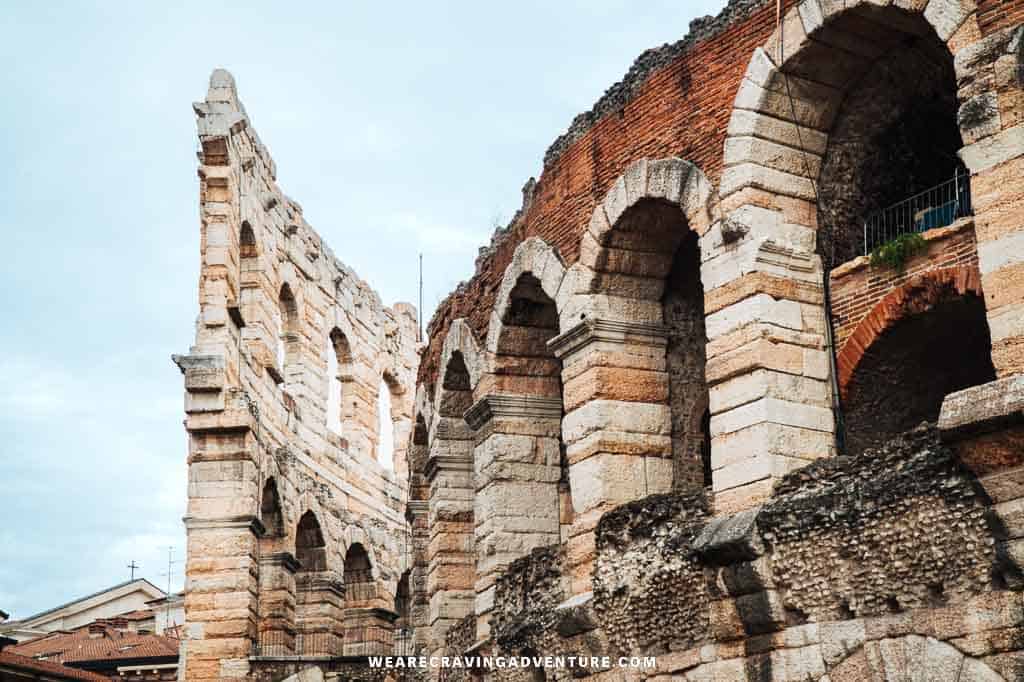
Arena of Verona
The Arena di Veron once hosted grand gladiator shows and popular events. Today, it remains an iconic venue for concerts, operas, and performances.
It is one of the main attractions in Verona so it’s best to beat the crowds with an early visit.
Experience the rich history of the Verona Arena on a guided tour and explore its Roman and medieval history, and learn about the captivating stories of emperors and gladiators.
Book your Arena visit: Historical tour of the Arena di Verona Skip the line tour of the Arena
Castelvecchio Bridge
The Castelvecchio Bridge, also known as Scaliger Bridge, connects the medieval Castelvecchio to the city.
Despite near-destruction during WWII, it was meticulously rebuilt to mirror its original design. It features tall walls, protective towers, and three arches, with the main spanning over 48 meters.
Museum of Castelvecchio
Castelvecchio, meaning Old Castle in Italian, was a pivotal military fortress constructed by Verona’s ruling Scaliger dynasty.
Restoration efforts in the late 1950s transformed it into the impressive Castelvecchio museum, home to extensive collections of medieval, Renaissance, and modern art spanning up to the 18th century.
The museum boasts 29 halls, exhibiting a diverse array of over 90,000 pieces, including paintings, sculptures, weaponry, coins, medals, and more.
Basilica of San Zeno Maggiore
Verona’s Basilica of San Zeno exemplifies exceptional Romanesque architecture. Its façade, resembling the Cathedral of St. Mary, showcases a captivating mosaic of colors through the use of tufa stone and bricks.
Situated between a monastery tower and a slender bell tower, this complex was erected atop an ancient Roman and early Christian burial site.
Porta Borsari
Porta Borsari was the main entrance during the Imperial Era. Dating to the 1st century AD, it was initially called Porta Iovia due to its proximity to a temple dedicated to Jupiter Lustrale.
It later became Porta San Zeno and finally Porta Borsari, honoring the Bursarii, the brave soldiers who collected the bishop’s duties.
Via Mazzini and Benetton
Nestled within the vibrant Via Mazzini, Verona’s trendiest shopping street, lies a hidden treasure like no other.
Amidst renovation efforts at the Benetton establishment on Via Mazzini, fragments of ancient Verona have been uncovered. Venture to the first level (Menswear) to witness a segment of a Roman domus and a unique geometric mosaic.
Verona Cathedral and Chiostro dei Canonici
The Cathedral in Verona, known as Cathedral of Santa Maria Assunta, serves as the central structure of a complex that also includes the churches of San Giovanni in Fonte and Sant’Elena, and the Cloister of the Canons.
The complex was built on the remnants of the city’s first paleo-Christian basilica. The current Cathedral was constructed between 1120 and 1187, boasting a blend of Gothic and Romanesque architecture. The interior houses invaluable artworks, including the recovered Assumption Altarpiece by Titian.
Tucked behind the Cathedral is the Chiostro dei Canonici, a serene 12th-century cloister with a beautiful garden and Romanesque columns. Here you’ll find numerous traces of the Christian churches that previously occupied this site.
Giardino Giusti or San Zeno in Monte
The Giardino Giusti, an exquisitely maintained garden, has welcomed historical luminaries like Goethe, Alexander I, and Mozart over the centuries.
Established in the late 1400s, it complements the Giusti palace with terraces offering gradual city views and a belvedere atop for panoramic Verona vistas.
Alongside its flowers, the garden showcases Roman relics, the grand Cypress of Goethe, and well-preserved 16th-century features including fountains, labyrinths, and mythological statues.
If you’re not interested in the gardens but would still like to enjoy a breathtaking view of Verona, head over to the viewing platform infront of the Church of San Zeno in Monte

Verona is the perfect base to discover more of the Veneto region from and there is so much beauty within easy reach that it’d be a shame not to go on a day trip! There are plenty of day trip options from Verona and if you have more days in Verona you could certainly fill them with fun day trips.
Book your day trip from Verona: Daytrip to Sirmione & Lake Garda from Verona Lake Garda Sunset Cruise Lake Garda Full-Day Tour Gardaland Entry Ticket Gardaland Private Transfer Valpolicella wine tour Amarone Wine e-Bike
Sirmione and Lake Garda are just a short drive away and perfect for nature lovers. Gardaland theme park makes for a day filled with fun and excitement. And if you love wine, don’t miss the opportunity to tour Valpolicella on this Valpolicella wine tour.
And if you haven’t already, you must visit Venice or the Dolomites on a day trip from Verona (altho, I’d recommend spending more than just a day here).
Read next: Things to do in Venice Venice Itinerary
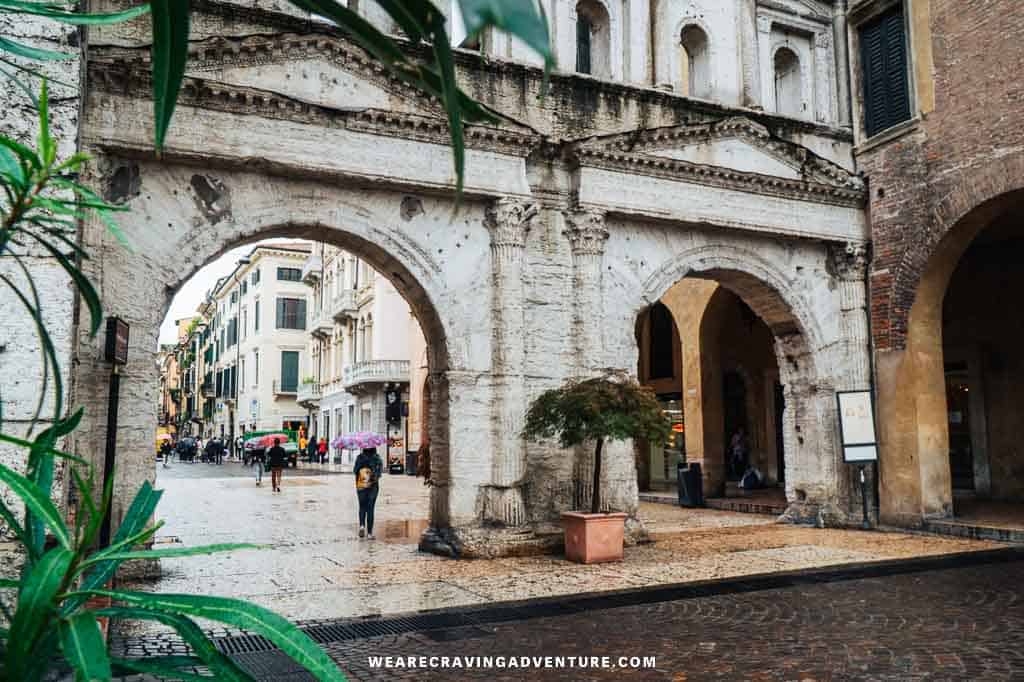
2 days in Verona itinerary
If you have two days in Verona you can either follow the first two days of the above itinerary (and skip the day trips) for a super relaxed visit, or you can slightly pick up the tempo by following the adjusted 48h Verona itinerary below which allows time for a wine tour on your second day.
The historic center of Bologna is fairly small and walkable so I highly recommend you join this walking tour to get acquainted with the city and the main sights. You’ll learn so much about Verona history and culture.
Juliet’s House and Balcony | Passionate Verona tour | Walking Tour with Juliet’s Balcony
Scaligeri Tombs | Verona Card
Torre dei Lamberti | Verona Card | Lamberti Tower ticket
Verona Cathedral and Chiostro dei Canonici | Verona Card
Basilica of Santa Anastasia | Verona Card
Archaeological Museum Teatro Romano | Verona Card
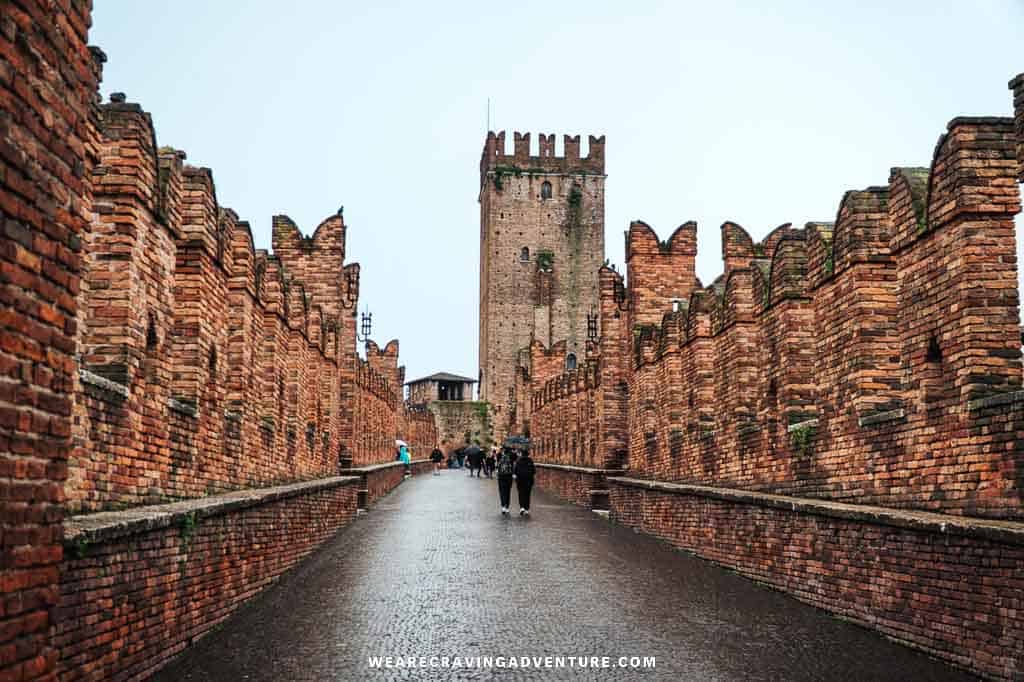
Arena of Verona | Verona Card with priority Arena ticket | Arena di Verona guided tour
Museum of Castelvecchio | Verona Card
Basilica of San Zeno Maggiore | Verona Card
Wine tour | Wine tasting with views

If you only have one day in Verona it’s gonna have to be a jam-packed one so grab some comfy shoes and get ready to do your steps! I highly recommend you book this walking tour so you can avoid getting lost and wasting precious time.

Verona is well-connected by various transportation options, making it easily accessible from different parts of Italy and neighboring countries.
By Air: Verona is serviced by Verona’s Valerio Catullo Airport (VRN) operated by several major airlines and offers both domestic and international flights. From the airport, you can take a shuttle, taxi, or public bus to reach the city center.
By Train: Verona is well-connected to Italy’s extensive rail network. It’s easily accessible by high-speed trains (Frecciarossa) from major cities like Rome, Milan, Venice, Florence, and others. The Verona Porta Nuova railway station is the city’s main station and only a short bus or taxi ride from the old city center.
By Car: If you prefer a more flexible and scenic journey, driving to Verona is an option. The city is well-connected to the Italian highway system, and you can reach it via the A4 motorway from cities like Milan or Venice. However, keep in mind that driving in the city center might be challenging due to traffic restrictions in some areas.
By Bus: Several long-distance bus companies operate routes to Verona from various cities in Italy and Europe. While this option may take longer than a train or flight, it can be more economical and suitable for budget travelers.
The best way to get around in Verona, especially in the old city center, is on foot. Verona’s historic center is relatively compact and pedestrian-friendly, making it ideal for exploring by walking. Many of the city’s main attractions, such as Piazza Bra, Juliet’s House, the Arena di Verona, and Piazza delle Erbe, are within a short walking distance from each other.
If you need to cover longer distances within the city or want to visit sights located outside the historic center check out this Hop-on, Hop-off Bus.
Verona also has a reliable public bus system. Make sure to convalidate your ticket as you board the bus, download the ATV bus ap or purchase the Verona Card which includes public transport as well as entrance tickets to most attractions.

Verona is absolutely worth visiting and you should visit it sooner rather than later before it becomes overly touristic as we’ve seen happen with some other Italian destinations.
Verona offers the perfect blend of beautiful architecture, rich history, romance and legend, while also offering incredible events, a lively bar scene, great food, fabulous shopping opportunities and so much more!
Verona is beautiful any time of the year and can be visited year-round, even in winter. In fact, Verona is the perfect destination for a Valentine’s Day getaway.
Spring and autumn are especially beautiful when the surrounding hills and Verona’s parks take on a new layer of color. In summer you can enjoy many events in Verona but it can get quite hot.
Italy is such a stunning country that packs beautiful nature, astonishing architecture, rich history, interesting culture, loads of hand gestures, and delicious food. Oh, don’t even get me started on Italian food!
I’ve prepared a whole plethora of articles to help you plan your Italian adventure and if you’re planning a trip to Venice make sure to check out the relevant resources below:
Verona: Best things to do in Verona
Venice: Best things to do in Venice Best things to do in Venice in winter Venice itinerary – 1, 2, 3 and 5 days
Bologna: Best things to do in Bologna Best hotels in Bologna Where to stay in Bologna
Milan: Things to do in Milan Milano itinerary – 1, 2 & 3 days Where to stay in Milan
Travel Insurance
Good travel insurance is an absolute must when traveling abroad, and I’ve learned that the hard way!
Now I always get insured before we leave and Travel Insurance Masters is my go-to platform to find the best insurance options for the specific trip.
The TIM platform works as a search engine and suggests the best insurance company and insurance plan for your criteria so you don’t end up paying more for things you don’t need! It also takes into account your age, nationality, destination etc. which can greatly impact the final price.
You can get your quote & provider recommendations here.
Zi @Craving Adventure
Zi is the Founder and Editor in Chief behind Craving Adventure.
Leave a Reply Cancel Reply
Your email address will not be published. Required fields are marked *
Name *
Email *
Save my name, email, and website in this browser for the next time I comment.
Post Comment

Home » Travel Guides » Italy » 15 Best Things to Do in Verona (Italy)
15 Best Things to Do in Verona (Italy)
Nestled on a U bend on the Adige River, Verona is one of the most important cities in the Veneto region of Italy and is famed for its historical centre and myriad of stunning buildings and architecture.
Verona is the second largest city in the region behind Venice and has a population of 269,000. In 89 BC, Verona became a Roman settlement and held an important position in Northern Italy as it was located at the intersection of two important roads.
As time progressed and the Roman Empire collapsed, other factions and ruling parties exercised control over Verona including Alboin of the Lombards, Mastino II, and Maximilian I. Today, Verona attracts a huge number of tourist due to its rich history and significance, and its myriad of ancient buildings such as the Arena and the Ponte Scaligero.
Lets explore the best things to do in Verona :
1. Arena di Verona

Forget about the Colosseum in Rome; Verona has its own version that is just as spectacular and possibly better preserved.
This national landmark is unknown to many, but it stands as a triumph of Roman engineering and is a true wonder.
Located in the middle of the historic town centre, the Arena is an immense Colosseum that contains literally of its original seating and exterior arches.
Constructed in 30 AD, it is remarkable that this structure has stood in such a fine condition for thousands of years.
Various shows and games would have been held here such as the Roman Ludi and at its peak, the amphitheatre would have held 30,000 spectators.
Today you can walk inside the Arena and admire its architecture; furthermore, concerts and musical shows are still held here which is a true spectacle.
2. Castle Vecchio

Sitting on the banks of the River Adige, the Castle Vecchio is a hugely important structure and has stood since its initial construction in 1354. Serving as a primary mode of defence for the city, this castle was the greatest achievement of engineering for the Scaliger dynasty.
The front gatehouse of the castle is quit imposing and features a series of crenulated battlements and two guard towers.
Inside there is a museum dedicated to the history of the castle that contains a myriad of artefacts and factual displays.
Furthermore, there is the fantastic Castle Vecchio Bridge that is attached to the main complex and provides fantastic views down the river.
3. Ponte di Castle Vecchio

At the time of its construction, the bridge was the longest of its kind in the world.
Connected to the Castle Vecchio, the bridge is decorated in the same style as the walls of the castle and features a fantastic series of crenulated battlements that you can see through down the River Adige.
As with most of the historic buildings of Verona created during this era, the bridge is made from red brick which makes it stand out against the landscape of the city.
Furthermore, there is several series of stairs that you can climb in the towers of the bridge to gain an elevated viewpoint.
Aside from walking across the bridge, ensure that you walk along the river bank to view it and photography it from the side.
4. Basilica of San Zeno Maggiore

The Basilica of San Zeno is one of the most important religious buildings in Verona, mainly for its stunning architecture, but also because it was the fictional place of the marriage of Shakespeare’s Romeo and Juliet.
Located on the west side of the River Adige, the Basilica sits at the far end of the Piazza San Zeno.
The front façade of this church is quite simple and has a large central circular window and a beautiful ornate wooden door.
Inside the Basilica is truly beautiful however – the floor is covered with peach and grey tiles, marble columns hold up the arches and the ceiling has a series of decorative tile-work.
Additionally, an Abbey is also attached to the church with a wonderful arched courtyard and cloister.
5. Piazza Delle Erbe

Verona has a wonderful amount of charming squares and the Piazza Delle Erbe is one of the finest examples.
This diamond shaped piazza lies in the heart of the historic centre of the city and serves as one of the main points of activity.
During the Roman Empire, this piazza would have served as the main forum for the settlement.
Various important buildings line the square including the Torre Lamberti, the Palazzo Maffeia and the Case dei Giudici.
Furthermore, there is a selection of cafes and restaurants and also several fountains and marble statues.
The architecture, building facades and character of this beautiful piazza is undeniable.
6. Giardino Giusti

The Giusti Gardens are located in the grounds of the palace of the same name on the eastern bank of the river Adige.
The palace itself is a Neo-Classical structure and the gardens can be found at the back of the building.
Designed in an Italian Renaissance style, the gardens are some of the finest in Verona and provide a beautiful contrast to the waves of architecture that is present in the city.
Separated into 8 different squares, each part contains a different design and a central fountain or decoration.
Maintained to a beautiful standard, it is easy to see the care and attention that is put into this garden.
Furthermore, there is also an exciting hedge maze and a small wooded area to walk through.
7. Piazza Bra

As the largest piazza in Verona, the Piazza Bra is one of the main tourist areas of the city and contains a great amount of historic buildings, public amenities and eateries.
Undoubtedly the main attraction of the piazza is the colossal Arena di Verona and the open space surrounding this monument offers some fantastic photographic opportunities.
Furthermore, there is the Gran Guardia and the Palazzo Beriberi which are two fabulous buildings in their own right.
Aside from the main buildings, there are many quaint shopping and residential structures that are painted in various colour and have beautifully decorated shutters and balconies.
The Piazza Bra is definitely one of the best places to start your tour of Verona.
8. Torre dei Lamberti

Standing proudly on the Piazza Delle Erbe, the Torre dei Lamberti is the tallest tower in Verona standing at 84m high.
Construction originally started in the 1100’s however the tower stood in a state of disrepair and it was not until the 15th century that the tower was enlarged and clad.
Different time periods can be seen when looking at the tower as it is split into several distinct different sections.
A huge clock face adorns the wall that faces into the piazza, and the tower is topped with an octagonal dome containing a series of marble arches.
If you want to see Verona from a different angle, you can climb to the top of the tower and see the whole of the city spread out before you.
9. Verona Cathedral

Created in a similar style to the Basilica of San Zeno, Verona Cathedral presents a building that is grander, larger and more decorative.
The front facade features a similar shape and composition, but contains a great deal more decoration and some fantastic artwork and stained glass windows.
Consecrated in 1187, the Cathedral is one of the oldest religious buildings in Verona and is dedicated to the Virgin Mary.
Whilst the exterior is marvellous in its own right, the interior is just as opulent and decorative.
At the main altar, there is a stunning fresco depicting the a religious scene, and more Renaissance frescos can be seen in the main chapels.
Furthermore, a huge gold organ stands to the right of the altar and red Verona marble columns line the main knave.
10. Castel San Pietro

Holding a strategic position on the eastern bank of the Adige, the Castle of Saint Peter sits on a slightly elevated hill and has been inhabited since Roman times.
Originally, a church dedicated to Saint Peter stood here which gives the castle its name.
During the 1300’s the actual castle was built as a means of fortification for the city and stood firm for over 400 years.
Although the castle is no longer open to the public, you can still walk through its grounds, admire the amazing architecture, and experience fantastic views across to the historic centre of Verona.
11. Scaliger Tombs

Located next to the Piazza dei Signori, the Scaliger Tombs are a series of gothic funerary monuments dedicated to the influential Scaliger family.
This family rule Verona for many years and the heads of the house sat as the Lords of Verona.
Enclosed within a series or ornate Iron grills, the tombs have a Gothic design and feature a central arched structure with many pointed towers and stone sculptured decoration.
Five tombs in total sit in the enclosure dedicated to Cangrande I, Mastino II, Cansignorio, Alberto II and Giovanni.
The last monument is actually built into the wall of the adjoining chapel and features an ornate coffin and death mask.

12. Arco dei Gavi

Reminiscent of the Arch of Constantine in Rome, the Arco dei Gavi was constructed during the first century AD and would have originally served as part of the city defences and been a major gate into what is now the historic city centre.
The original inscription of the pediment on the arch read “Lucius Vitruvius Libertus”. During the Napoleonic era, the arch was actually demolished and it was not properly rebuilt using original designs until the 20th century.
You can now marvel at the arch in all its glory next to the Castle Vecchio – It is also worth seeing at night when it is beautifully lit up.
13. Casa di Giulietta

Verona is famous for having an associated with William Shakespeare; several of his plays are set in this city including the epic Romeo and Juliet.
Located on the Via Cappello, the Casa di Giulietta is the supposed building from the famous scene in Shakespeare’s play where Romeo Hails Juliet and she speaks to him from the balcony.
Although this building has been added too and any truth has be embellished, it nonetheless provides an important attraction and is a great place to visit if you are in that part of the city.
You can see the fabled balcony and inside the house there is a selection of informative displays about the play and the building.
14. Lake Garda

There are many great lakes in Italy, but non is as impressive as the mighty Lake Garda.
Lake Garda covers a surface area of 369 squared KM and has a water volume of 50.35km cubed.
It is one of the largest lakes in Italy, and also a popular holiday location due to its favourable climate, beautiful scenery and the amount of attractions available.
If you are staying in Verona for a length of time, consider taking a day trip to Lake Garda to explore this beautiful area of natural beauty – Consider a boat ride on the lake, or visiting one of the charming towns that sit on its shores such as Sermione or Bardolino.
15. Piazza dei Signori

Another of Verona’s fine Piazza’s, the Piazza dei Signori actually sits in close proximity to the Piazza delle Erbe but is just as interesting and popular.
Many historical and architecturally beautiful buildings line the square including the Palazzo del Capitano, the Loggia del Consiglio and the Case della Pieta.
Each building offers a slightly different style and the square is a miss-match of different time periods that creates a pleasant contrast.
Music performances are often held here and there is also several cafes and restaurants with outdoor seating.
15 Best Things to Do in Verona (Italy):
- Arena di Verona
- Castle Vecchio
- Ponte di Castle Vecchio
- Basilica of San Zeno Maggiore
- Piazza Delle Erbe
- Giardino Giusti
- Torre dei Lamberti
- Verona Cathedral
- Castel San Pietro
- Scaliger Tombs
- Arco dei Gavi
- Casa di Giulietta
- Piazza dei Signori

How Many Days to Spend in Verona: Sample 3-Day Itinerary
Please share this post:
Are you planning a trip to Verona and wondering how many days you should stay and what activities you could do? You’ve come to the right place!
Here, you’ll not only find answers to your questions but also a detailed itinerary that you can use as a reference during your visit. (I also have a sample 3-day Verona Itinerary at the end of this post)
We’ll begin by listing the top things to do in Verona and the time required to fully experience them. With this information, we’ll be able to answer your questions and help you plan your perfect trip. Let’s get started!
This post contains affiliate links. I may receive a tiny commission at no additional cost to you.
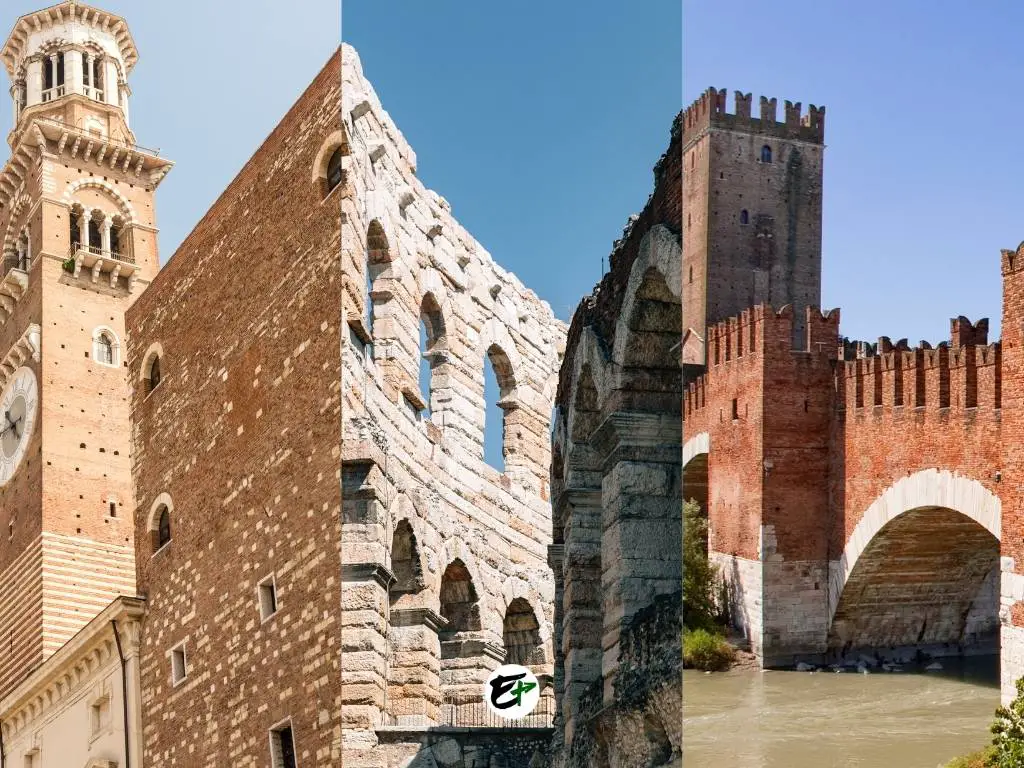
Use the table of contents to skip to topics.
Before you proceed to the itineraries and further details of how you can visit Verona, I strongly suggest you read my article, 12 Reasons To Visit Verona , first.
In that article, you’ll find all the tourist attractions (scenic spots, best experiences, impressive landmarks, etc.) in Verona and see why you’d visit them.
If you need a place to stay in Verona, you can find the best hotel deals in Verona using this link.
Time Needed in Visiting The Attractions in Verona
For some, creating an itinerary is the least enjoyable part of traveling.
Only a few enjoy it, as far as I know. It is not hard to understand why because it involves so much effort, like reading reviews, studying the map, and booking flights and hotels. Who got time for that?!
In this part, I help you determine how many days you must stay in Verona . To do that, I should first give you ideas of how much time you need for each tourist attraction in the city. This way, we can compute how long it would be.
The way I calculate how long a visit to a city is simple.
First, I research the destination and the things to do in it. Then, I pick which points of interest I like to see. After that, I look for how long or how much time other travelers have spent on each attraction. Finally, I sum up all the hours corresponding to the places I want to visit.
The total time is added to the minutes and hours consumed from transportation, meal breaks, and other necessary activities (for example, dropping bags at the hotel). The overall sum gives me the answer to how long my visit would be.
For your trip to Verona, you do not have to research the time required for different attractions in Verona because I got them all for you in the table below:
The estimates shown in the table are derived from different travel forums like TripAdvisor and Google Maps Reviews, where hundreds of travelers have shared their testimonials during their visit to the attractions in Verona.
I gathered information on how much time (shortest and longest) they’ve spent on each point of interest, and now you have it above.
By the way, if you want:
- Verona Card with Arena Priority Entrance (recommended)
- Verona Arena Opera tickets (recommended)
- Lamberti tower entry tickets (recommended)
- Hop-on-Hop-off bus tickets
- Hidden gems and history walking tours
- Wine tasting tours
- Verona food tours with a guide
and many more exciting activities in Verona see this list of things to do in Verona .
Summary (Excluding the day trip to Lake Garda):
If you’re quick in exploring tourist attractions, approximately 12 hours are needed to visit every point of interest in Verona. That’s 2 days in the city , suppose 6 hours will be spent visiting places and landmarks each day .
However, it is estimated that you’ll spend 21 hours total seeing the tourist attractions in Verona if you prefer a leisurely journey. That’s 3 days in the city , suppose 7 hours will be spent visiting places and landmarks per day .
Assume you give yourself 12 hours per day to explore Verona. With six or seven hours per day on tourist attractions, you still have 6 or 5 hours for other things such as meals, transportation, queueing, etc.
Although we know already that we can see everything in Verona in 2 to 3 days , we should think that travel does not work this way: we can visit every point of interest in the city as we planned .
Sometimes unpleasant weather kicks in. In other circumstances, a tourist attraction is closed for renovation. There’s always the tendency that we might miss a landmark or an experience.
This is why we must know which places are worth seeing for us or not. So, we know where to go instead if there’s a problem (closed, raining, under repair, etc.) with the destination we’re visiting next.
To help you with that, here’s a quick list of things to do in Verona to help you familiarize yourself with Verona’s landmarks, tourist attractions, and scenic spots. See the list below. I’ll leave links to Google Maps for each.

1. Verona Outer Wall, Gates, and Bastions
Locate in Maps | How long to visit Verona Outer Wall (estimate) : 30 mins to 1 hour
Summary : A stroll on the outer 16th-century walls of Verona, starting from Porta Nuova to Parco delle Mura, Porta Palio, Bastione San Bernardino, Bastione San Zeno, and lastly, Porta San Zeno. Panoramic sights and nostalgic remnants await you here.
2. Basilica di San Zeno Maggiore
Locate in Maps | How long to visit San Zeno Basilica (estimate) : 1 to 2 hours
Summary : The place where Romeo and Juliet were married. Enter to see spectacular interiors dating back to medieval times, go to the crypt for archaeological discoveries, and stroll in the church’s cloister to capture some Instagrammable spots.
3. Castelvecchio (Museum + Bridge + Arco dei Gavi)
Locate in Maps | How long to visit Castelvecchio (estimate) : 2 to 3 hours
Summary : Visit the restored castle museum containing medieval artworks and ancient weapons. The spectacular bridge awaits you after the museum – take pictures and stroll for a minute. Finally, see Arco Dei Gavi, an “ancient” arc dating back to the 1st century AD.
4. Verona Arena
Locate in Maps | How long to visit Verona Arena (estimate): 1 hour to 1.5 hours
Summary: Visit the impressive, 2-millennium-old entertainment hub of Verona at the heart of the city. Verona Arena’s architecture and preservation are something to be admired. There are opera plays in Verona Arena at night, although during the summer season only.
5. Citta Antica
Locate in Maps | How long to visit Citta Alta (estimate): 2 to 3 hours
Summary: This is the center of the old town Verona, where the quaintest buildings and medieval-age landmarks can be found. Six of the many points of interest in Citta Antica are Porta Borsari, Piazza delle Erbe, Piazza dei Signori, Cortile del Mercato Vecchio, Arche Scaligere, and Porta Leoni.
6. Torre dei Lamberti
Locate in Maps | How long to visit Torre Lamberti (estimate): 30 mins to 1 hour
Summary: The tallest tower in Verona, touching the sky at 84 meters. It is also one of the landmarks in Citta Antica, which you can find in the Piazza delle Erbe. Climb Torre Lamberti to see a breathtaking 360-degree view of Verona from the top.
7. Casa di Giulietta
Locate in Maps | How long to visit Casa di Guilietta (estimate): 15 mins to 30 mins
Summary: The 14th-century Gothic-style “House of Juliet” is one of the most popular attractions in Citta Antica. On this house’s stone balcony where Juliet stands while Romeo courts her. The Casa has a museum, the charmed statue of Juliet, and a lover wall.
8. Basilica di Santa Anastasia
Locate in Maps | How long to visit Basilica di Santa Anastasia (estimate): 1 to 2 hours
Summary: The Basilica di Santa Anastasia is Citta Antica’s other unmissable primary tourist attraction. This massive, 13th-century Italian Gothic church has impressive interiors packed with artworks, frescoes, and reliefs you must see. The church’s most notable artwork is made by Pisanello, “Saint George and the Princess.”
9. Cattedrale di Santa Maria Matricolare
Locate in Maps | How long to visit Cattedrale di Santa Maria Matricolare (estimate): 30 mins to 1 hour
Summary: Cattedrale di Santa Maria Matricolare is another church in Citta Antica Verona full of creativity to awe-inspire you. It has mixed architectural styles, Romanesque, Gothic, and Renaissance. The trompe l’oeil murals on the churches’ walls are absolutely wondrous.
10. Tomba di Giulietta
Locate in Maps | How long to visit Juliet’s Tomb (estimate): 1 to 1.5 hours
Summary: This place in Verona is a museum within a 13th-century deconsecrated convent now exhibiting frescoes from the middle ages and Roman Sculptures. The museum has a crypt under the church of San Francesco al Corso. Inside, a stone “sarcophagus,” empty and without a lid, can be found.
11. Ponte Pietra
Locate in Maps | How long to visit Ponte Pietra (estimate): 15 mins to 30 mins
Summary: Ponte Pietra is the oldest bridge in Verona, which is now more than 2000 years old. Most of it was destroyed during the second world war but was meticulously restored with the same materials. Ponte Pietra is one of the most picturesque spots in Verona, with scenic views of nearby hills and River Adige.
12. Museo Archeologico al Teatro Romano
Locate in Maps | How long to visit Museo Archeologico al Teatro Romano (estimate): 1 to 1.5 hours
Summary: Museo Archeologico al Teatro Romano is a medium-sized Roman amphitheater with an archaeological museum. A quality exhibit of ancient items is in the museum – ranging from statues to glassware, stoneworks to bronzes. It has a little church and an overlooking of Verona.
13. Castel San Pietro
Locate in Maps | How long to visit Castel San Pietro (estimate): 30 minutes to 1 hour
Summary: Above the Roman Theater, we find Castel San Pietro, a Romanesque fortress perched on top of a hill overlooking the Citta Antica and River Adige. Castel San Pietro is facing west. If you are looking for a place to watch the sunset over Citta Antica, this is just the place to be.
14. Santuario della Nostra Signora di Lourdes
Locate in Maps | How long to visit Santuario Della Nostra Signora di Lourdes (estimate): 1 to 1.5 hours
Summary : Santuario Della Nostra Signora di Lourdes is the church on top of the hill to the north of Verona. This church has the miraculous Virgin Mary statue that survived after being bombed during World War II. Anyway, it’s the place to be if you want tranquility and to see absolutely panoramic views of Verona.
15. Giusti Garden
Locate in Maps | How long to visit Guisti Garden (estimate): 30 mins to 1 hour
Summary: Giusti Garden is a hidden gem in Verona. It is an elegant public garden with beautiful flowers, lush trees, and a picturesque labyrinth. As it sits on relatively elevated land, panoramic views await you in the garden too.
16. Lake Garda
Day trip from Verona | Locate in Maps | How long to visit lake Garda (estimate): 8 hours
Summary : You can travel to Lake Garda from Verona in less than an hour. It’s the perfect day trip from Verona if you want to extend your trip. In Lake Garda, the gorgeous Castello di Sirmione, the Archaeological site of Grotte di Catullo, Gardaland Resort, and more await you.
How to Spend Days in Verona
Although I recommend having a 2 or 3-day trip to Verona, it does not mean that 1 day is insufficient to enjoy the city.
At the same time, It does not mean you will be rushing to visit every attraction in town if you stay only for 2 days in Verona. There are many ways you can explore Verona, and I will be giving you some ideas about how.
Below, we will tackle if 1 day, 2 days, and 3 days in Verona are enough and how you can spend your time for each duration. In addition, I’ll give you ideas on how you can enjoy Verona even if the weather isn’t cooperating well.
1 Day in Verona
1 Day in Verona is not enough . On a day trip to Verona, you can only see half of the city’s best landmarks and tourist attractions. I suggest you do not miss Castelvecchio, Verona Area, Piazza delle Erbe, and a couple of places you prefer to visit.
For me, these three tourist attractions in Verona are the most unmissable for being so historic, picturesque, and wanderlust-satisfying. Without them in your Verona itinerary, your trip to Verona seems incomplete.
Ways to Spend 1 Day in Verona
Indeed, there are numerous ways you can spend a day in Verona. Most of its attractions are churches, iconic buildings, and scenic spots. You can focus on one category and visit the city’s key landmarks.
Admire Churches in Verona
The churches in Verona are undeniably more than just a place of worship.
Though they are not as impressive compared to those in Rome, Veronese churches are works of art in museums too. Church-hopping in Verona can fill your cameras with photos and your soul enriched if you’re a believer.
Know that the Verona tourism office has created three itineraries, Rebirth From Water, Rebirth from Earth, and Rebirth from Heaven, for a more meaningful and contextual visit to the numerous churches in the city. Basically, they are a sort of urban pilgrimage.
Aside from that, these itineraries aim to promote Verona as Little Jerusalem and give you a deeper understanding of the city’s culture, Christianity, and Christian architecture. Each itinerary’s execution lasts for 2 hours to 2 hours and a half, traversing five to seven churches.
For me, here’s the way you can spend a day in Verona with the churches and the primary landmarks of the city prioritized. We start the day in Verona Arena to avoid long queues.
- Verona Arena (1.5 hours)
- Castelvecchio (2 hours)
- Citta Antica (2 hours) – Lunch & Stroll in the quaint streets
- Basilica di Santa Anastasia (1 hour)
- Basilica di San Zeno Maggiore (1 hour)
- Cattedrale di Santa Maria Matricolare (0.5 hour)
Visit Verona’s Iconic Places
Another way you can spend a day in Verona is to visit the places people see the most. Based on Google Maps, these places have the most reviews. See below. Thus, they’re the places that are visited by most people too.
- Casa di Giulietta (30 minutes)
- Torre dei Lamberti (1 hour)
- Citta Antica (2 hour) – Lunch
- Ponte Pietra (30 minutes)
- Castel San Pietro (30 minutes)
They are tourist attractions that other people can easily recognize in photos. If your traveler friends saw your selfie with these landmarks in the backdrop, they would instantly know you’ve been to Verona.
Make sure that you’ll come to Casa di Giulietta as early as possible if you want to have a picture while you’re on Juliet’s Balcony. The queue to the balcony can get very long past 9 or 10.
See Verona’s Scenic Spots
Verona can be full of tourists, especially during peak seasons. Try this out if you want to ditch the crowd after visiting the city center where the unmissable places in Verona:
- Castelvecchio (1 hour) – excluding the museum, just the bridge
- Citta Antica (1 hour) – Lunch
- Museo Archeologico al Teatro Romano (1 hour)
- Santuario della Nostra Signora di Lourdes (1.5 hours) – sunset
Giusti Garden is the alternative for Santuario della Nostra Signora di Lourdes. A bus ride is needed to get to both. However, you can hike instead for 20-ish to 30 minutes from Ponte Pietra to reach Santuario Della Nostra Signora di Lourdes.
Bad Weather In Verona
Unpleasant weather is absolutely a bummer when traveling. If that happens to you as you visit Verona, worry not! Almost half of the attractions in Verona are indoors or have partial indoor activities.
If you think that it’s going to rain in Verona, here are the places where you can go:
- Cattedrale di Santa Maria Matricolare (1 hour)
- Tomba di Giulietta (1 hour)
- Museo Archeologico al Teatro Romano (1.5 hours)
Note that there will be a lot of walking in Verona. These attractions are within walking distance of each other. Prepare your umbrellas and have weatherproof shoe coverings if needed.
2 Days in Verona
2 days are enough to see every tourist attraction in Verona, although it may feel like you are rushing to see everything and barely relaxing. You can skip landmarks that seem don’t to interest you, however. This way, you create spare time to travel slowly and enjoy visiting the place you’ll be.
You can find the best hotel deals in Verona here for your 2-stay in Verona.
Ways To Spend 2 Days in Verona
There are two ways I can think of how you can spend two days in Verona. As mentioned earlier, you do just a quick visit to every tourist attraction in Verona without appreciating each much or travel slower so you can enjoy the place you’ll be visiting but miss a few others.
Again, I’m recommending the latter choice as it’s much better to feel the moment you’re discovering beautiful, historical things and places than just rushing around to see or capture a selfie with them.
That is most especially in Citta Antica, which is full of charming ancient and medieval structures that can certainly transport one’s imagination to the past. Not to mention Palazzo Maffei Casa Museo and Palazzo Della Ragione in Piazza Delle Erbe, and many more!
3 Days in Verona
3 days are enough and the ideal length of stay in Verona . Within 3 days you can leisurely visit every tourist attraction in the city. Nonetheless, if you have seen every “interesting” place in Verona within 2 days, you can allocate your 3rd day to a day trip to the nearby Lake Garda.
Do you need a place to stay in Verona for 3 days? You can find the best hotel deals here .
Ways To Spend 3 Days in Verona
In my opinion, the best way you can spend 3 days in Verona is to visit the most impressive landmarks and historical places first on day 1 and day 2. Set the low-priority tourist attractions on the third day.
Despite that, make sure that you have a flexible itinerary in the case of unpleasant weather.
You should be able to switch day 3 to either day 1 or day 2 in your itinerary in case of unpleasant weather in any of the first two days.
For the three-day itinerary, I also suggest that you align your visit to Verona’s scenic places to the afternoon hours. Possibly, during sunset or golden hour.
Verona has 3 elevated tourist destinations (Giusti Garden, Castel San Pietro, and Santuario della Nostra Signora di Lourdes). Each day, you can have a chance to witness a spectacular sunset over Verona’s Citta Antica in three different places.
Verona Arena and Casa di Giuletta are the two attractions in Verona where people line up to enter or just to have a photo souvenir. Be sure these two are the first you will see in Verona on the mornings of your trip.
Check out my sample itinerary in the next section.
Sample Verona Itineraries: 1 to 3 Days
In this part, I’m sharing a 3-day Verona itinerary that you can use as a reference for your trip to Verona. Please note that the hours indicated in the table below are only estimates. The length of time when moving from one place to another was already considered.
Most of the attractions in Verona are within walking distance of one another. Although buses service parts of the city, it would seem better to walk for two reasons:
- The time in transit is almost the same as when you’ll spend walking.
- Verona has beautiful streets, and there might be something new and “interesting” you can discover when you walk instead.
Do you need a place to stay in Verona? You can find the best hotel deals here .
Day 1 in Verona
For day 1 of my Verona Itinerary, we start our journey in Verona’s most iconic landmark, Verona Area.
We’ll visit the tourist attractions north and northwest of Verona Arena for the rest of the day.
These are Castelvecchio, Basilica di San Zeno Maggiore, and Santuario Della Nostra Signora di Lourdes.
You can get your passes/skip-the-line tickets (see more things to do in Verona) here.
Notes for Day 1
I suggest that you come to Verona Arena earlier than 9:00 am (its opening time). So you can avoid the crowd, have fewer photobombers, and have some quiet during your visit.
Piazza Bra is just in front of Verona Arena. Here, you can find a little garden and many cafes you can hang out for a while, waiting for the Arena to open to visitors. It is also such a lovely wide-open place to have lunch after seeing Verona Area.
The next destination, Castelvecchio, is just 500 meters away from Piazza Bra. Proceed to Via Roma street, and go straight to the right when looking at Palazzo Della Gran Guardia’s facade.
After Castelvecchio, we proceed to Basilica di San Zeno Maggiore. There are several ways you can choose. However, I suggest the scenic path that crosses River Adige twice. It is a 15 to 20-minute stroll ( see Google Maps ) with views of River Adige.
From the castelvecchio, cross the River Adige through the medieval bridge, Ponte di Castelvecchio. Walk along the river sidewalk, Lungadige Cangrande, the path to the left after crossing the river.
Turn to the next bridge you will see (Ponte Risorgimento). Continue walking straight until you notice the tower of Basilica di San Zeno Maggiore to the left. Follow the direction towards the basilica’s tower.
Santuario Della Nostra Signora di Lourdes is approximately a 30-minute hike away from Basilica di San Zeno Maggiore. Buses stop by the bus stop near Basilica di San Zeno. They should shorten the walk to Santuario Della Nostra Signora di Lourdes.
From Basilica di San Zeno, proceed to P.tta Portichetti 1/B bus stop. Wait for and hop on Bus no. 31 when it arrives. Disembark at Via Mameli 13 Vi and walk uphill to Santuario Della Nostra Signora di Lourdes. See the complete route in Google Maps .
For the second day in my Verona Itinerary, we shall focus on Citta Antica and the tourist attractions located northeast of it across the Adige River.
Basically, half of the day will be spent at Citta Antica. Then the other half will be spent on the tourist attractions near River Adige (Ponte Pietra, Museo Archeologico al Teatro Romano, and Castel San Pietro).
There are a lot of shops and cafes in Citta Antica, so I thought that it’s the best place to discover cute souvenir products and delicious local meals during your visit to Verona.
Citta Antica is jampacked with beautiful palaces, little discoveries, boutiques, and more – you can just spend the whole day wandering around. This is why you’ll notice I allocated a considerable portion of time to Citta Antica in the itinerary below.
Notes for Day 2
You know, you can visit Basilica di Santa Anastasia and Cattedrale di Santa Maria Matricolare on the 2nd day of your visit to Verona as they’re a part of Citta Antica. But if you’re planning to have a 3-day trip, I suggest you set them aside for the third day.
Anyway, we’ll start day 2 in Citta Antica, particularly at Juliet’s house. It’s where the famous balcony of Juliet is. If you want to have a picture standing on it, I suggest coming as early as possible as the queue to Juliet’s balcony demands 30 minutes waiting time during peak season.
After Juliet’s house, you’re free to go wherever you want in Citta Antica. I created a route in Google Maps you can follow when in Verona. The time reflected in the link does not reflect the actual.
The next set of activities in the afternoon is on the northern tip of Citta Antica. It’s the most scenic place in the old town of Verona, I think. The first stop is Ponte Pietra, which is 10-minutes away from Pizza Delle Erbe by foot.
The next place to visit is Museo Archeologico al Teatro Romano, the archeological site/ruins that you can see right from Ponte Pietra or along the banks of River Adige. It should not take you more than 5 minutes to reach the Museum from Ponte Pietra.
There are a few cafes and restaurants in the area where you can replenish after seeing Museo Archeologico al Teatro Romano. I would suggest Re Teodorico restaurant beside Castel San Pietro so you can dine in with a view of Verona.
From Ponte Pietra, you can take the stairs to Castel San Pietro. The first step is at the intersection of the roads and Ponte Pietra. Going up takes no more than 10 minutes.
Alternatively, you can ride the funicular to Castel San Pietro much faster and conveniently. The funicular is just behind Chiesa di Santo Stefano.
The 3rd day of my Verona itinerary includes the remaining numerous “interesting” attractions in the city. They’re the landmarks or places outside Citta Antica and the churches within Citta Antica. Though these places can be worth a visit, I suggest that you have a day trip to Lake Garda instead.
Notes for Day 3
We begin the trip at the northernmost part of the 16th-century outer wall of Verona at Porta San Zeno. Continue going south towards San Bernardino Bastion, then Porta Palio, Parco delle Mura, and Porta Nuova. It’s approximately 1.7 kilometers long, 30 minutes to 1-hour leisurely walk.
Tomba di Giulietta, the next destination, is just 1 kilometer away (15-minute walk) from Porta Nuova. If you’re currently in Porta Nuova, proceed east until the wide road intersection. Turn left, and after five blocks of houses, you must see a signboard to the right saying “Tomba di Giulietta.” Here is the Google Maps route for your reference.
After Tomba di Giulietta, you go for lunch. The nearest best location for lunch would be Pizza Bra. From Piazza Bra, you can walk to the next destination, which is Basilica di Santa Anastasia. The travel time on foot and in transit is almost the same ( 15 minutes ).
The last destination for the 3rd day is Giusti Garden which is approximately a 15-minute walk from Citta Antica. Be sure to come 30 minutes before the closing hour (7 pm October to March and 8 pm April to September). Giusti Garden is one of the stops of the hop-on-hop-off bus.
Save it on Pinterest .
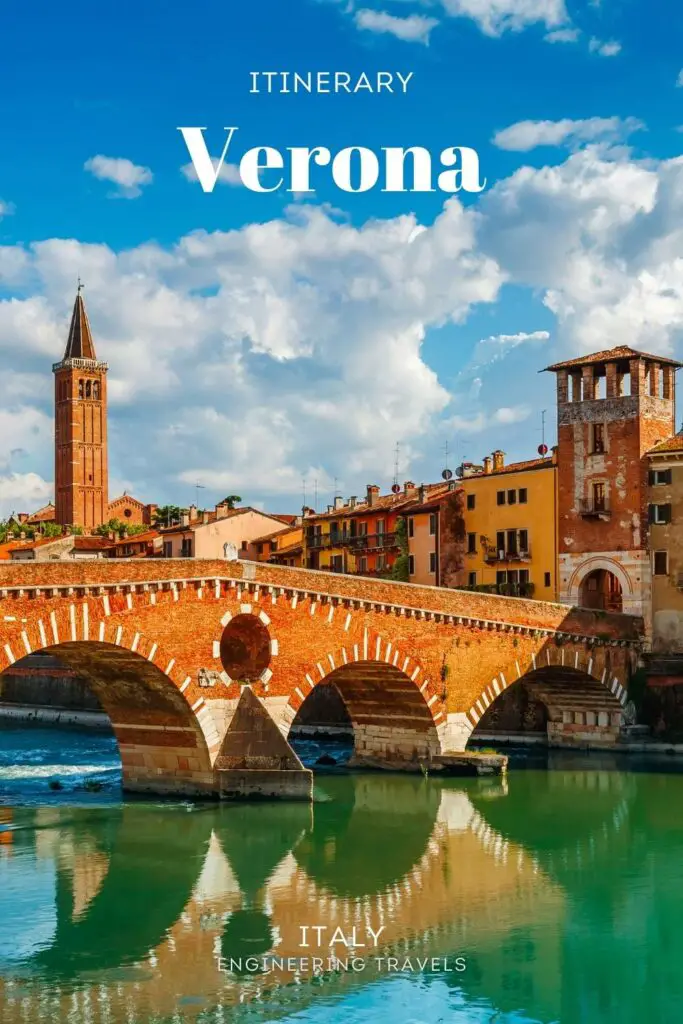
Similar Posts
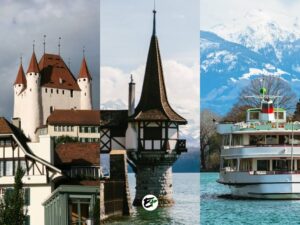
Thun Switzerland Travel Guide: 5 Unmissable Things to Do
Thun might not be the first place you think of when planning a trip to Switzerland, but it’s a place that shouldn’t be overlooked. It’s similar to Lucerne, but a little smaller. Overall, it offers a mix of stunning natural scenery and fairy tale attractions. Thun’s charm is undeniable. One of its highlights is a…

Wurzburg Travel Guide: 20 Things to Do, 5 Reasons to Visit
When I am en route to a destination less frequented, I often encounter a unique, strangely good sensation. It is similar to excitement, but not quite the same. The prospect of discovering something beautiful, unknown to most, along with the possibility of stumbling upon hidden gems, sparks this indescribable emotion. Wondering what it is like?…
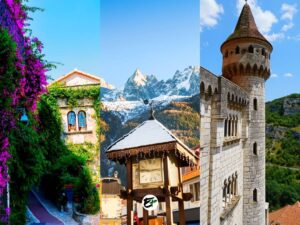
10 Stunning Villages in The South of France (Worth Visiting)
The South of France is without a doubt one of the most beautiful regions in the world. Whether looking for a picturesque place, a breathtaking destination, or a romantic spot, southern France won’t leave you empty-handed. If you’re planning to visit southern France, I suggest you add at least one of its charming towns or…

Interlaken Travel Guide: Things That Make It Worth Visiting
Like you, I was asking before: Is Interlaken worth visiting? Well the short answer is: Interlaken is the thrill-seeker’s paradise in Switzerland and a top-tier destination. This town offers a “front-row seat” to some of the most awe-inspiring alpine views on the planet. Plus, you can dive into fun-filled adventures at Lake Thun, Lake Brienz,…
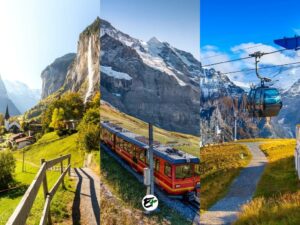
7 Days in Interlaken: A Week in The Jungfrau Region
When it comes to breathtaking natural beauty, only few places in Europe can rival what I saw in the Jungfrau Region. From hidden waterfalls echoing beneath the earth to lakes shimmering in ethereal turquoise, and majestic mountain peaks piercing the sky, the Jungfrau Region almost have everything that you are looking for that one perfect…

7 Beautiful Towns and Villages in the Black Forest to Visit
The Black Forest, with its panoramic views and unique attractions, is a place where you’ll never run out of things to see, even over a few days. From the world’s largest cuckoo clock to a park offering glimpses of different parts of Europe, there are so many things to see and places to visit in…
This was incredibly thorough and helpful! Thank you so much!
You are welcome! Hope you enjoy your trip to Verona 🙂
Leave a Reply Cancel reply
Your email address will not be published. Required fields are marked *

Bologna or Verona – Which Should you Visit?
Home > Blog > Bologna or Verona – Which Should you Visit?

If you’ve already ticked classic Italian destinations such as Rome , Venice and Florence off your travel bucket list then you may find yourself wondering where to visit next. Bologna and Verona are two of the country’s popular cities that each have a brilliant array of things to see and do, from ancient architecture to influential academic institutions.
Both locations have plenty of points in their favor for factors such as culture, cost and shopping, which can make choosing between them a tricky task. Luckily, we’ve broken down the best of what each city has to offer to help you decide whether to visit Bologna or Verona.

Verona is one of the oldest cities in Italy, thought to have first been inhabited in 550 B.C and founded as a Roman colony in the 1st century B.C. Its success as a city lies in its location; Verona was part of both the north-south and east-west trading routes which made it an incredibly prosperous location in the Roman Empire.
After the fall of this empire, several groups battled for control of Verona, and the Scaligeri family dynasty eventually took over. Under their power, the city grew and became a cultural centre for the arts, with famous creators such as Dante living and working within Verona’s walls.
The Scaligeri family were constantly fighting amongst themselves for power however and by the 15th century, the Venetians were ruling Verona instead. The city was then passed to Austria after a Napoleon invasion in the late 1700s and didn’t gain autonomy until Italy was unified as a country in the 1860s.
Verona was named a UNESCO World Heritage Site in 2000 because of the influence that the city had across Italian history and the wealth of architecture and culture that was preserved there. It’s a fantastic city in Italy to visit for fans of history because of the legacy of the area and the numerous remains of ancient buildings.
The origins of Bologna have been traced back to the Bronze Age, but it wasn’t until the Iron Age that villages were established in the area. The settlement prospered on various trade routes and was an important city in the Roman Empire before Byzantine and Lombard invaders took control and turned Bologna into more of a base for military operations.
In 1088 Bologna established what is largely thought of as the world’s first university, which led to the city becoming one of the most influential locations in the medieval world. The university continued to prosper even after Papal troops took control of Bologna in the 1500s and expanded the city, building more academic buildings, churches and the famous botanic gardens.
Bologna joined the new kingdom of Italy in 1860 and became a key industrial hub after the destruction of World War Two. Now, it’s one of the most economically powerful places in the country that is famous both for its liberal politics and exceptional food.
Both Verona and Bologna are fantastic destinations if you’re looking for a historic Italian holiday, as both have incredibly interesting pasts and plenty of remaining monuments.

Bologna is often thought of as one of Italy’s top cultural destinations, primarily because of its university. In 2000 the European Union named the city as a European Capital of Culture, and this reputation continues to make it a favoured location for fans of art, music, literature and more.
The University of Bologna was established in 1088 and continues to be a leading influence in academia. There are spectacular university buildings around the city, with the library in particular being a top attraction, and academic events are frequently hosted in various locations.
Art and history are also plentiful in Bologna, with over 50 galleries and museums that offer plenty of places to visit throughout the city. The National Gallery of Bologna is a real highlight for art lovers, with numerous famous pieces and plenty of examples of classic Italian Renaissance paintings.
Verona is perhaps most famous for being the setting of William Shakespeare’s classic tragedy ‘Romeo and Juliet’, which has made it a cultural highlight of Italy for centuries. Tourists flock to the city in their thousands to visit what was said to be the family home of the Capulets, and you can also see Juliet’s balcony along with a collection of antique engravings that tell the story of the two lovers.
As well as its literacy heritage, Verona also has an impressive history of art, music and poetry. Now, there is a brilliant range of galleries featuring everything from modern to renaissance pieces of art, many of which are also housed in historic buildings.
In the centre of the city is an impressive open-air amphitheatre which still hosts performances that range from pop concerts to classic performances and theatrical productions. The program of events is particularly good in the summer, with operatic performances being the main attraction for many visitors.
When it comes to culture, both cities are fantastic places to enjoy art, architecture, food and music. Whilst Verona is a top destination for fans of Shakespeare’s works, Bologna has a bigger variety of cultural attractions that makes it a better option for those who want to spend their trip immersed in the artistic legacy of the city.

ARCHITECTURE
One of the key reasons that Verona has been named a UNESCO World Heritage Site is the fantastic variety of preserved historic architecture that can be found inside the city. Notable structures from the Roman era include the two city gates – Porta Borsari and what remains of the Porta Leoni – the Ponte Pietra and the Arco dei Gavi.
The architectural highlight of Verona however is the fantastic Roman amphitheatre arena, which has remained beautifully preserved over the centuries. You can visit the arena or watch a variety of performances there throughout the year, which is a particularly popular tourist activity in the summer months.
Bologna is a haven for lovers of beautiful buildings, with plenty of examples of architectural styles from across the centuries showcased in the city. The most notable structures in the city are the long porticoes that cover the city centre and turn the streets into almost 40km of covered arcades; a truly unique piece of architectural design.
Another architectural highlight are the famous towers that are often used as a symbol of the city and were built in the Middle Ages. The Torre Garisenda and Torre Degli Asinelli are both ‘leaning’ (although not as much as the tower in Pisa) and you can climb up Asinelli Tower for unbeatable views of the whole city.
From palaces to squares, churches to stations and all kinds of houses, museums and galleries, there is a huge range of both historical and modern architecture to admire in Bologna. Verona has a better selection of ancient Roman remains, but Bologna has more unique examples of architecture, so which city you choose will really depend on what kind of buildings you favour.

Emilia Romagna is thought of as one of the best Italian regions for food and Bologna is certainly its finest city for exceptional dining experiences, described as many as the gastronomical capital of Italy. The city has been nicknamed ‘La Grassa’ (the fat one) because of its foodie reputation, and we advise that you embrace this idea and try and experience as many flavours of Bologna as possible during your stay.
The most famous dish to come from the city is the namesake bolognese pasta, or tagliatelle al ragù, which is an absolute must-try if you are visiting Bologna . The area is also famous for its stuffed pasta known as tortellini along with lasagna and other meaty pasta dishes.
Verona doesn’t have nearly as much of a reputation for food as Bologna, and local cuisine focuses on meaty dishes and rich flavours. The wine that comes from the Veneto region is famous however and is served almost everywhere in Verona, pairing perfectly with the traditional, hearty meals that the city is known for.
There’s no competition between the two locations when it comes to food – Bologna is the clear winner as Italy’s capital of gastronomy.

Verona is a stylish city, and the shopping scene is pretty impressive. As well as classic designer stores and well-known brands, there are plenty of independent retailers and boutiques in some of the more historic areas of the city which are a great place for picking up souvenirs or buying statement pieces of clothing.
Bologna is also a relatively good place in Italy for shopping, with plenty of streets dedicated to both designer and independent retailers. There are also several excellent markets in Bologna that are a great place to go food shopping and sample some of the delicious ingredients that the Emilia Romagna region is famous for.
When it comes to shopping opportunities, both cities offer an equally good selection of outlets and stores, with Bologna being the better choice if you’re looking for edible souvenirs to bring home.
Despite the wealth of history, art, culture and food on offer in Bologna, it is not as visited as other cities in Italy such as Rome, Venice and Florence. This makes it a relatively cheap part of the country to visit however, as prices for food and accommodation don’t tend to be heavily inflated by tourism.
Verona is also not a particularly expensive city in Italy to visit, although prices for travel and accommodation do tend to be higher over the summer months. Whilst there are many boutique hotels and five-star restaurants that are well worth splashing out on, you’ll also find budget options for every aspect of your holiday that make it a great place to stay for all travellers.
You can get around both cities on foot for the majority of the time, and a lot of the attractions are either free to see or only require a small ticket price. Bologna and Verona are pretty equally matched when it comes down to cost, so your decision on where to visit will be down to other factors.
THINGS TO DO
Verona and Bologna both offer tourists a multitude of different things to see and do on their visit, with each city containing a good mix of historic sites, classic Italian buildings and opportunities to enjoy good food and drink.
If you’re looking for sightseeing opportunities then Verona is full of notable spots and is a great place to see a really wide range of architectural styles from across the ages. It’s also a brilliant city to enjoy live performances, with plenty of musical and theatrical shows taking place in both the Verona Arena and other theatres.
Bologna is also a great place for a holiday filled with sightseeing, especially as so much of the city centre is undercover and therefore suitable for exploring in all weathers. Because of its culinary reputation, it’s also a great place to take part in Italian cooking classes if you want to brush up on your chef skills, or can be used as a hub to explore some of the other top gastronomic destinations in Emilia Romagna.

These two cities are equally matched in many aspects, which can make it incredibly hard to choose between the two.
If you’re a food lover then Bologna is definitely the best choice for a holiday filled with exceptional flavours and chances to try some of the finest dishes in Italy. It’s also the better destination for fans of history thanks to its status as the first university city in the world, and has a unique selection of architectural marvels.
Verona is one of the most romantic cities in Italy and therefore the best choice for couples wanting to plan a trip away. Its significance in the story of Romeo and Juliet also makes it the top choice for literature lovers, and the range of culture on offer means that music and art fans will be in heaven as well.

Whether you decide to visit Bologna or Verona, get in touch with Italy4Real for expert help and advice on planning a unique trip to one of these sensational cities.
About the Author

Rem Malloy started Italy4real back in 1995 with his mother, Deborah de Maio.
He specialises in Italian tours as well as customised tours to France, England, Ireland, Germany, Switzerland, Greece and Spain. He was also featured in the Travel Channel show Mysteries at The Museum in 2016.
Rem has family in Italy and his mothers home town is Cava di Terrani, near the Amalfi Coast. The family has a street named after them in Sorrento, Via Luigi de Maio; a relative who was mayor of Sorrento.
Other Blog Posts You Might Like

When is the Best Time to Visit Venice?

What to Do in Florence for 3 Days

The Best Foods in Sicily That You Need to Try

The 5 Best Day Trips from Florence

The 9 Best Places to Visit in Sicily

Should I Travel To Venice Or Florence – Which Trip Is Better?
A Solo Woman Traveling
Boutique Travel Guides & All-Female Luxury Tours

Should I Travel to Verona or Florence Which is Better?
So you are going to Italy and are wondering if you should travel to Verona or Florence? Having recently visited both cities I can help you make this decision!
When I traveled to Northern Italy, I made stops in Verona, Bologna, and Florence ! I have a good understanding of what these most beautiful cities have to offer!
There is no quick answer to which city is better… The choice is largely going to depend on your travel goals.
Even though choosing between Verona and Florence isn’t going to be an easy decision, with my expertise, I am confident I can help you find the perfect place for your trip .

Human-written content, by me, and nearly all original images, unless stated. Posts could have affiliate links to help offset the cost of maintaining this blog. When you click on a link we receive a small commission. This is at no extra cost to you. See Our Affiliate Policy and Advertiser Disclosure for more info.
Where are Verona and Florence Located?
First, let’s start with the logistics. Where are the popular cities of Verona and Florence located in Italy? Both having their own unique charms, histories, and cultures definitely make them worth visiting.
But if you’re trying to decide between them for your next Italian adventure, it’s important to know where they are located so that you can plan accordingly.
Verona is located in Northern Italy, in the Veneto region, and is situated on the banks of the Adige River. It’s just an hour away from Venice by train, so it makes a great day trip if you’re interested in visiting Italy’s “Floating City.”
Verona has a long history and is known for its Roman ruins, medieval architecture, and romantic literature connections to Romeo and Juliet.
Florence is situated in the region of Tuscany, in central Italy. It’s around an hour and a half away from Pisa by train, so it’s easy to combine these two cities into one trip .
Florence has been called the “Cradle of the Renaissance” and its art, architecture, culture, and history reflect this title.
No visit here would be complete without taking in the stunning Duomo cathedral , as well as the many sculptures and artworks from some of the world’s most famous artists. And of course, The David…
How Far Are Florence and Verona From Each Other?
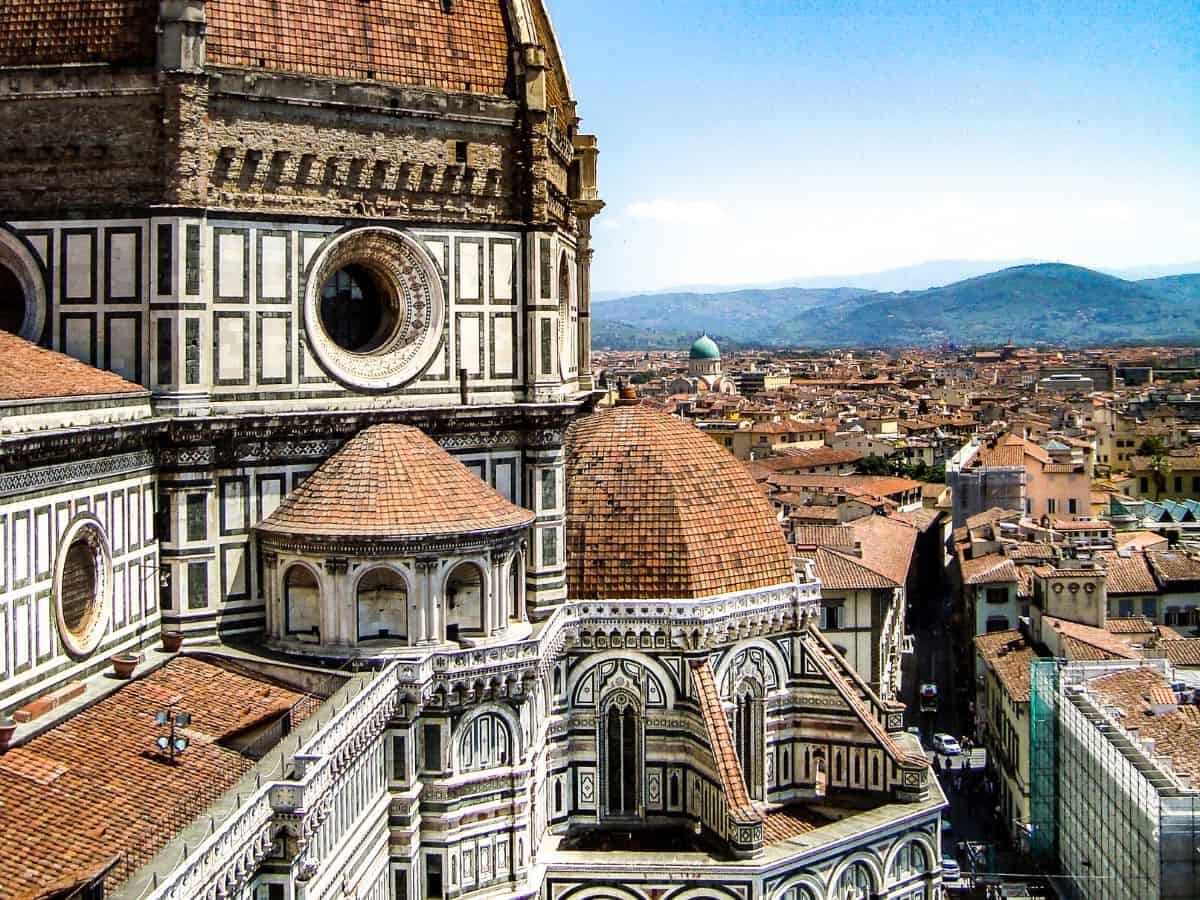
Florence is located in the Tuscany region of central Italy, while Verona is located in the Veneto region of Northern Italy. As such, they are around 150 miles (250 kilometers) apart by road.
The quickest way to get between these two cities is by train , with the travel time taking usually around 2 hours. The train journey is comfortable, with several train services throughout the day, so you can plan your trip accordingly.
While both cities have an airport I wouldn’t bother flying. You would spend more time dealing with getting to the airport and going through security than actually flying.
The drive is 4 and a half hours long without traffic. If you drive, I would suggest you make it a road trip and stay in the city rather than a day trip.
Whichever city you choose to stay in for the duration, both Verona and Florence will offer other nearby Italian cities I would consider for day trips!
🚗 Car Rental: Get a rental car and do a Northern Italy road trip!
Nearby Cities You Can Visit From Verona
If you are deciding between Florence and Verona, here is a list of the cities closest to Verona!

Venice is one of the most popular cities in Italy! With its close proximity to Verona, you should consider if your itinerary allows for a day trip.
Take the train for 1 hour or take a scenic 2 hour drive from Verona to Venice!

If you are looking for the best city to do a food tour in, check out Bologna!
Located only an hour from Verona by either car or train , it is the perfect place for a short visit.
Whether you are traveling solo or not, Bologna is the city you should try to squeeze in if you can!
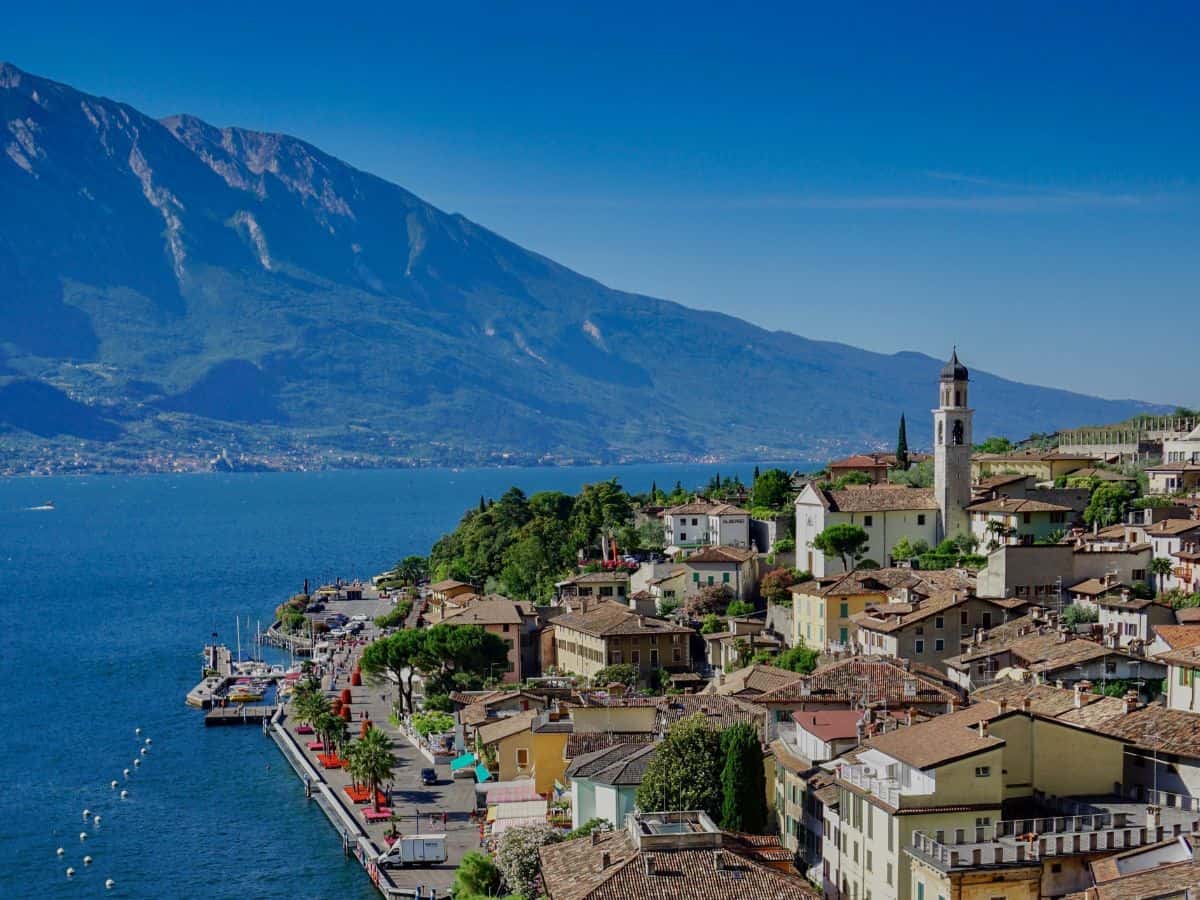
I think Lake Garda is possibly the best day trip you can make from Verona!
Located only an hour from Verona, you can join an organized tour, take one of the regional trains or drive .
Nearby Cities You Can Visit From Florence
If you decide to stay in Florence there are a few places that are more accessible from Florence than Verona. I have listed a few below suitable for a day trip !
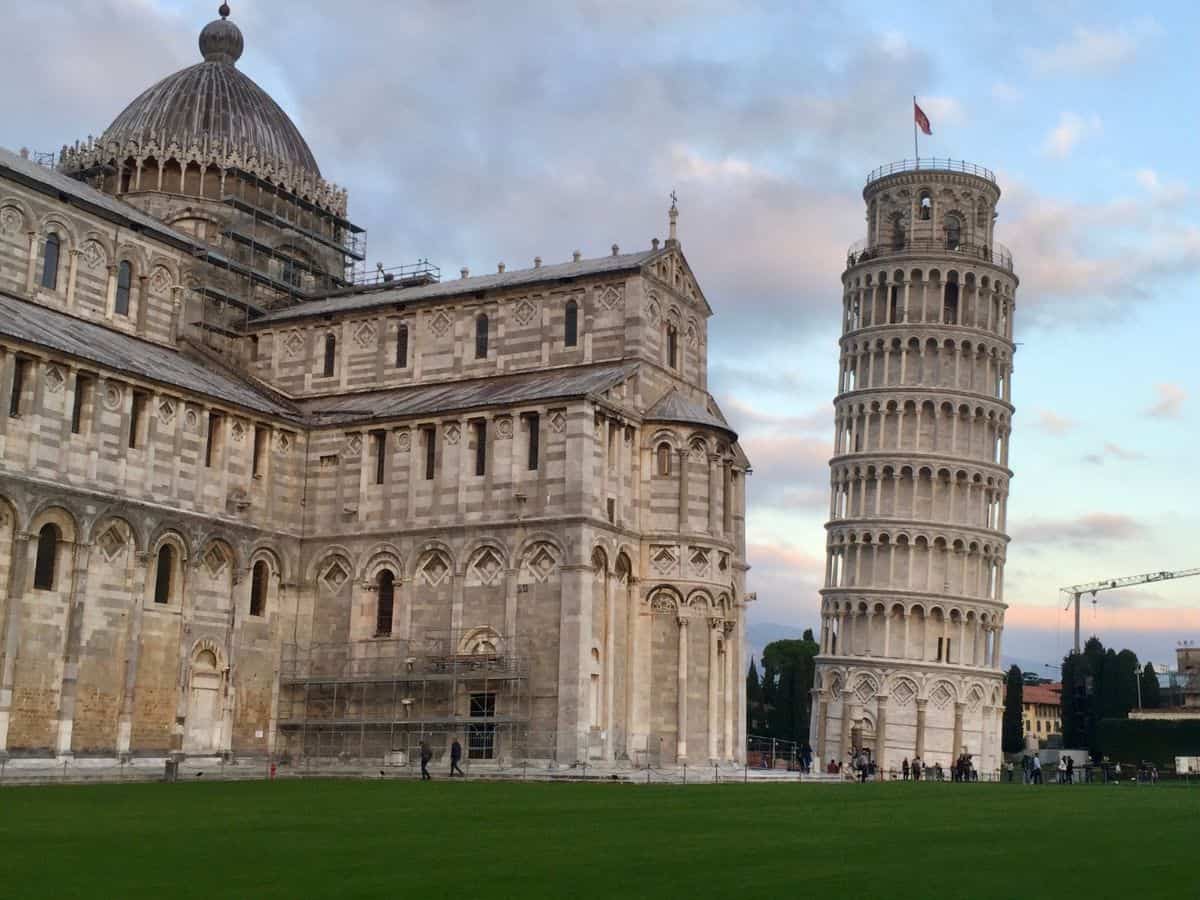
A great day trip from Florence would be to visit Pisa. Here you can visit the leaning tower of Pisa and the Cathedral of Santa Maria Assunta. Pisa is only an hour and 20 minutes by train and 2 hours by car .
❤︎ Organized Day Trip to Pisa: Check Rates & Availability

The food capital of Italy is only a short distance of about 40 minutes by train from Florence! It is the middle point city between Florence and Verona.
Having a reputation for having the most delicious food it is a good choice for day trips.
❤︎ Book a Food Tour in Bologna: Check Rates & Availability
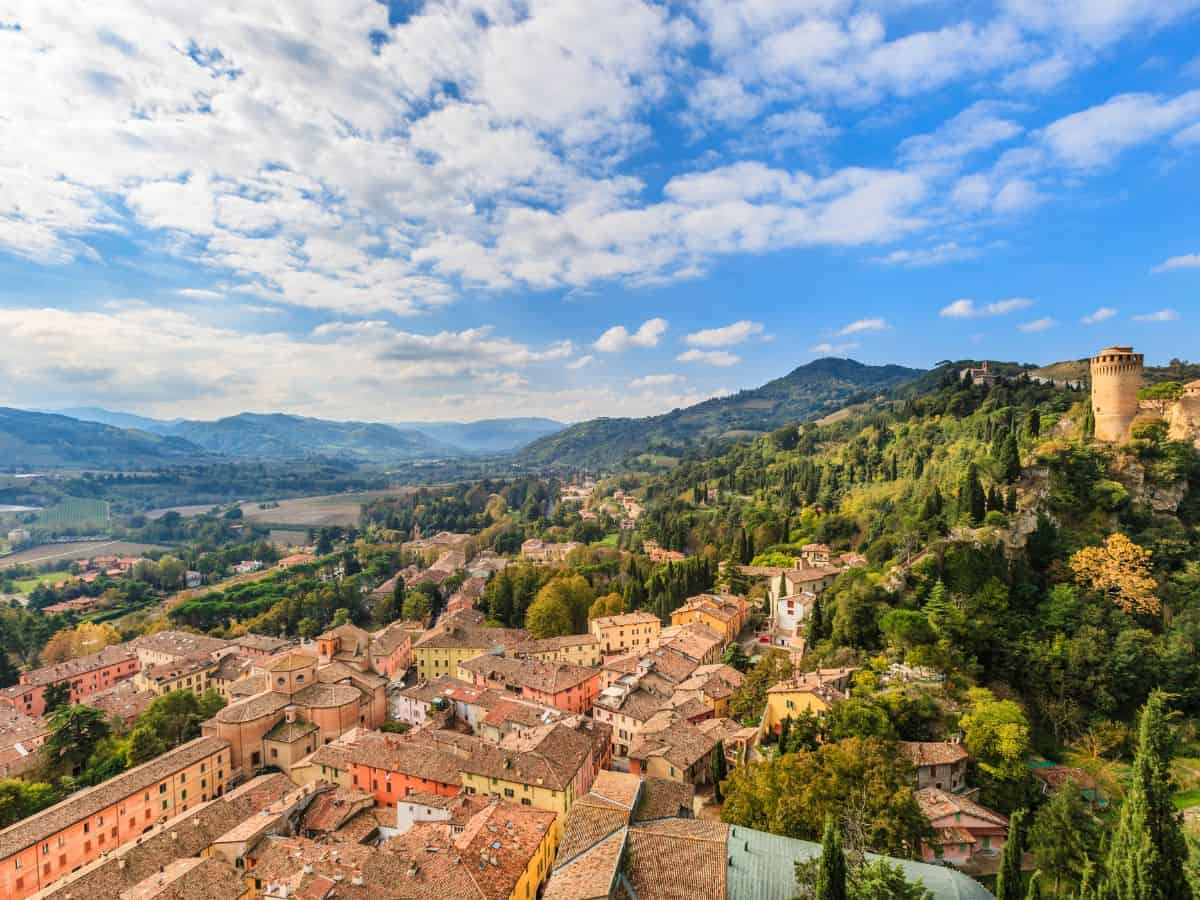
Exploring Ravenna from Florence was an amazing trip! From ancient art and architecture to stunning mosaic churches, Ravenna has something for everyone.
Getting there was easy – only a couple of hours by train – and it was worth every minute!
I highly recommend visiting this unique city if you’re looking for an unforgettable Italian adventure.
Getting Around Verona and Florence on Public Transit
The public transport in both these cities is fantastic . There are high-speed trains between both Verona and Florence making it possible to visit each city on the same trip if you have enough time.
📲 Download the Trainline app making it easy to purchase train tickets as well as search for direct trains to nearby cities.
The central train station is conveniently located in both cities.
In Verona, you arrive at the Verona Porta Nuova Station. From here is it about 20 minutes to the city walls and the town centre also referred to as Centro Storico.
From the station to Piazza delle Erbe (center square) it will take you 30 minutes on foot. Don’t worry there are taxis lined up outside the train station if you would rather get a lift than walk.
In Florence you arrive at Firenze Santa Maria Novella, also 9 minutes from Piazza del Duomo and a 15-minute walk to Piazza San Marco. It is a very easy walk unless you have a lot of baggage .
The Biggest Difference Between Florence and Verona
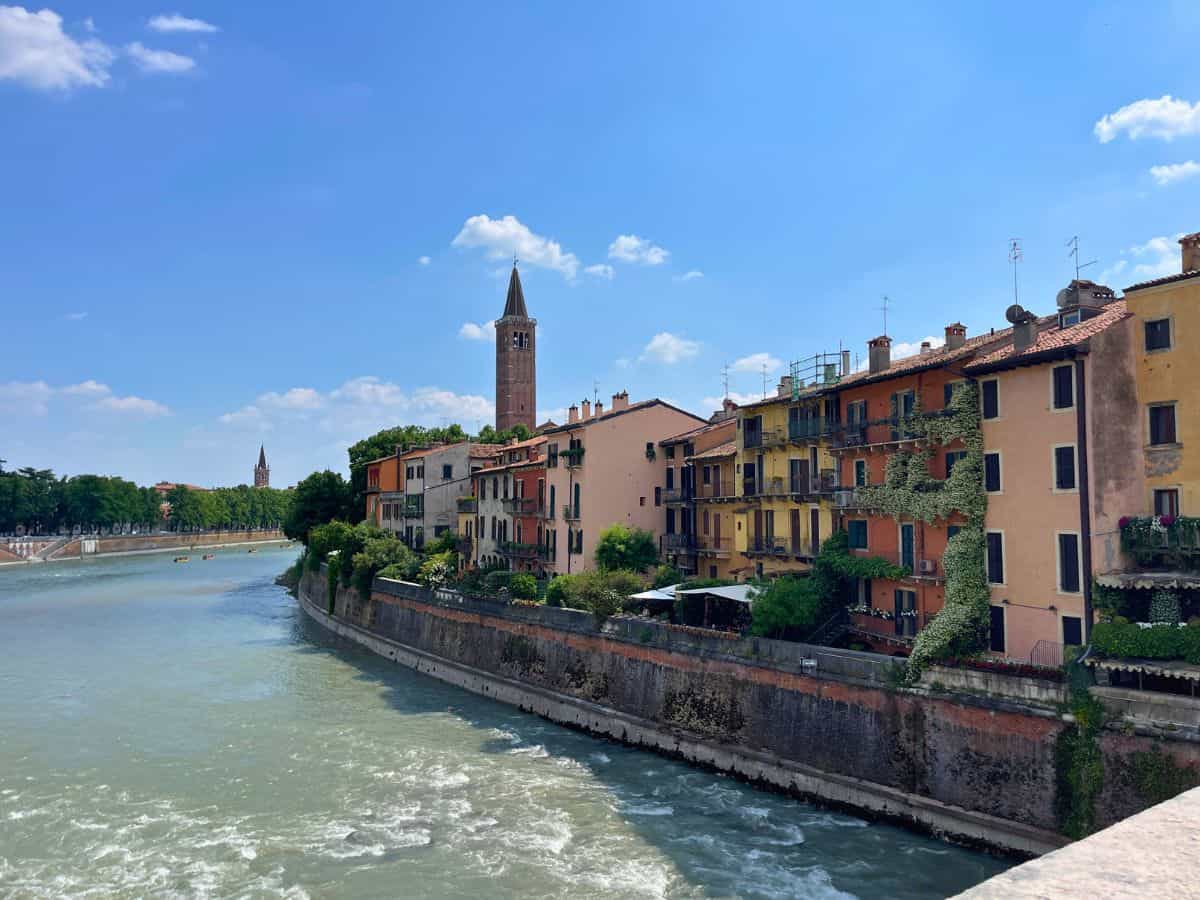
One of the biggest differences between Florence and Verona lies in their city size, architecture, and history . While both cities have been around since Roman times, Florence has a much longer and more diverse history, being the birthplace of the Renaissance.
Whereas Verona is best known for its romantic connections to Romeo and Juliet , as well as other historical figures like Alexander the Great who conquered it in the 4th century BC.
Florence boasts some of the most impressive art, architecture, and culture in Europe . It’s home to world-famous sights such as the Duomo Cathedral, the Uffizi Gallery, and the Galleria dell’Accademia, which houses Michelangelo’s famous sculpture of David.
Facts about Verona and Florence

Verona, a much smaller city, also has its own share of cultural attractions, such as the Arena di Verona and the nearby Castelvecchio Museum.
In terms of cuisine, Florence is known for hearty dishes like Ribollita soup and Bistecca alla Fiorentina steak.
Whereas Verona prides itself on its traditional Venetian-style cuisine, which includes dishes like risotto al radicchio and bigoli in salsa. Both cities offer an array of delicious dishes and fine wines that will delight any palate.
When it comes to shopping, Florence is home to some of the most luxurious boutiques and designer labels in Italy. Verona has a more relaxed atmosphere when it comes to shopping, with plenty of markets and independent stores offering unique gifts and keepsakes.
So when deciding which city to visit, it’s important to keep their respective histories and cultures in mind.
Whether you’re looking for a romantic escape or an artistic adventure, Florence and Verona both offer something special that can’t be found anywhere else in the world.
The Pros of Staying in Verona
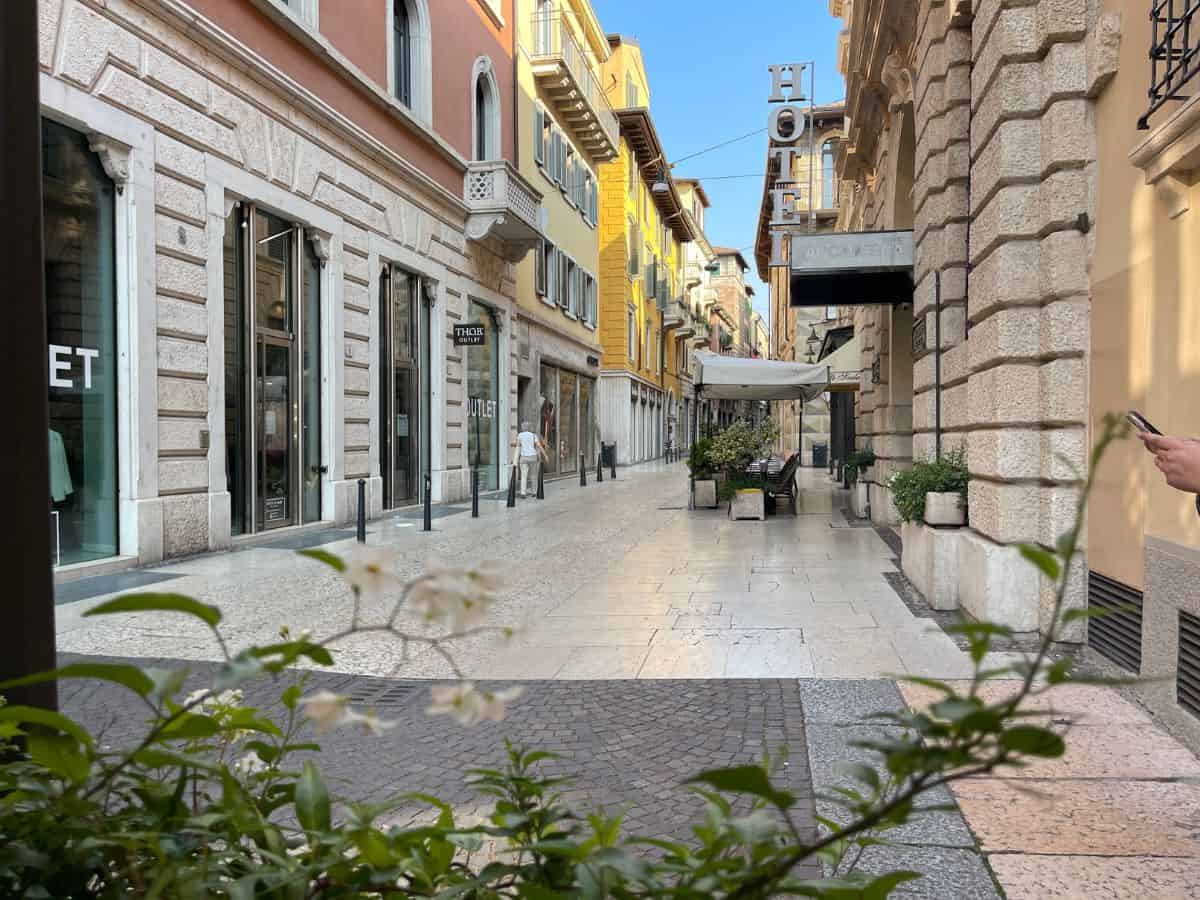
When it comes to Verona and Florence, there are pros and cons to staying in both cities.
One of the main pros of staying in the city of Verona is its romantic atmosphere .
Couples can wander past ancient buildings from Roman times, or gaze up at Juliet’s balcony, all while enjoying a chilled glass of prosecco!
Even though I visited Verona solo , it was still one of the most romantic cities I’ve ever visited!
It also has plenty of outdoor activities to enjoy, from cycling along the banks of the Adige River to exploring the nearby Lake Garda.
Verona is also a little less visited than Florence, so if you are hoping for fewer tourists, Verona beats Florence for sure.
The Cons of Staying in Verona
Verona can be a beautiful place to visit but there are definitely some cons to staying in this Italian city.
First, compared to Florence, Verona is much smaller and lacks the same level of attractions that Florence has .
This means fewer things to do and see while you’re visiting. Another con of Verona is its location. It’s quite far away from other notable cities, like Rome, if that is where you were planning to fly into.
Finally, Verona’s nightlife isn’t quite as lively compared to Florence’s bustling scene. While the lack of nightlife sounds better to me, some people would prefer the option.
Top Things to Do in Verona
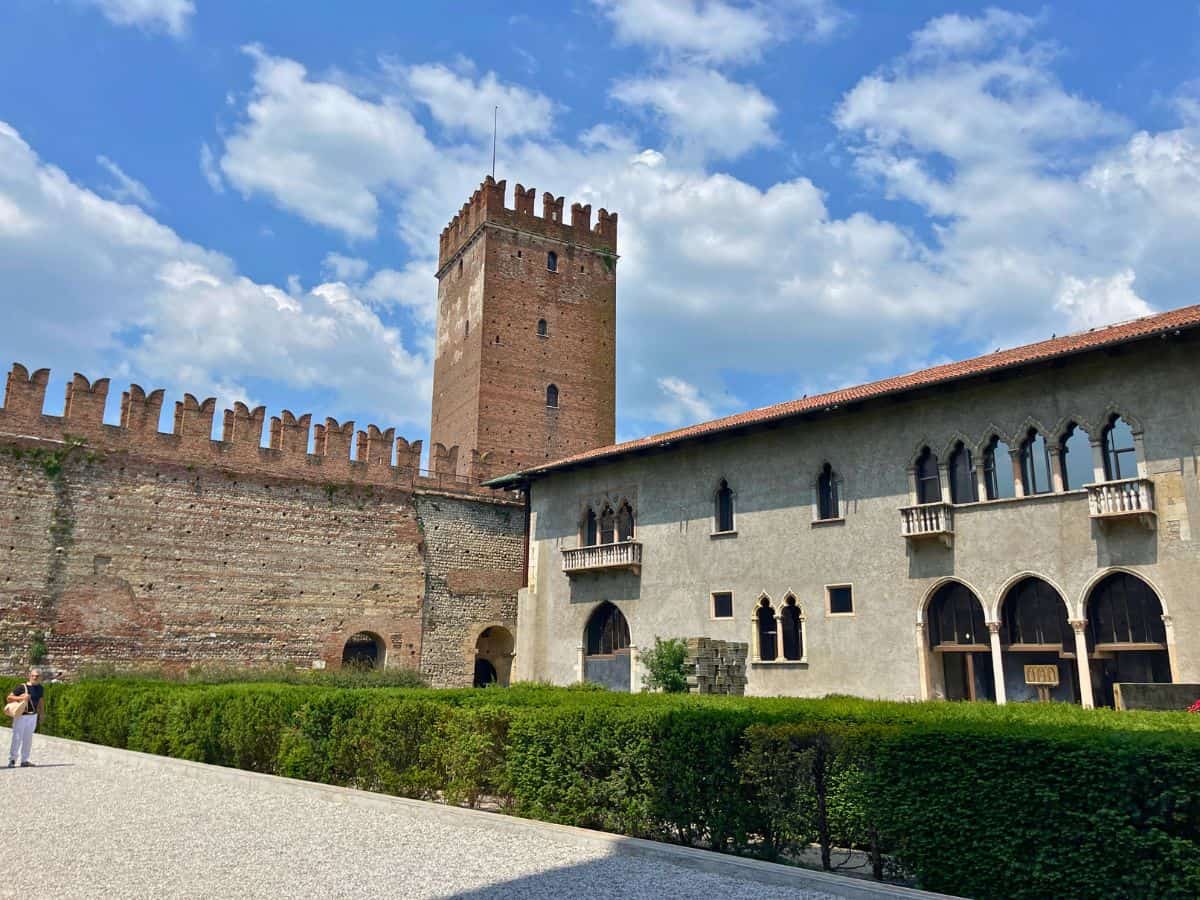
With the array of things to do in Verona , I was never bored! It is a city so rich in history and culture, incredible food. A great way to save money in Verona is by getting the Verona Card . I found it super useful.
🤑 Save MONEY & TIME: Get the Verona Card and get free entry and skip-the-line access for the Arena + entrance to Juliet’s Hour and Torre dei Lamberti, and more
Here are all the best places and top things to do when visiting Verona:
Admire the arena of verona.
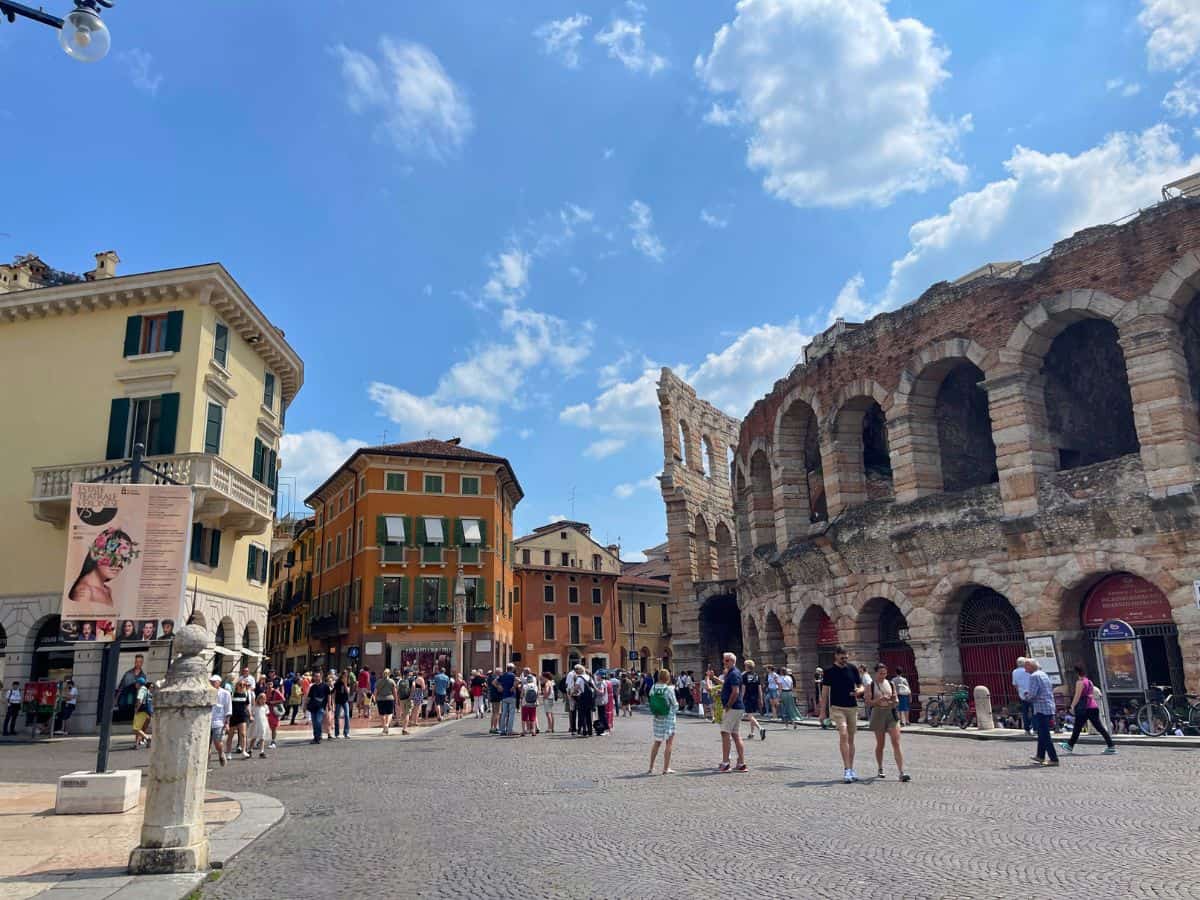
This ancient Roman amphitheater is a Unesco World Heritage Site and one of the best preserved in all of Italy.
It is a like a mini Colosseum! Whether you are a fan of theatre or just enjoy exploring historical sites, this arena is worth checking out.
Take a guided tour
Walking around Verona’s old town with an expert guide is the best way to really get to know the city.
You’ll learn all about the history of Verona while soaking up its picturesque streets and sights. I can recommend the 3-hour tour I took around Verona with food tasting & cable car .
Visit the Juliet House

This is where Shakespeare’s famous love story of Romeo and Juliet took place. It is slightly underwhelming in my opinion but worth visiting when you are in Verona.
I just made a visit to the courtyard at Casa di Giulietta to see the balcony.
Explore Castelvecchio Museum
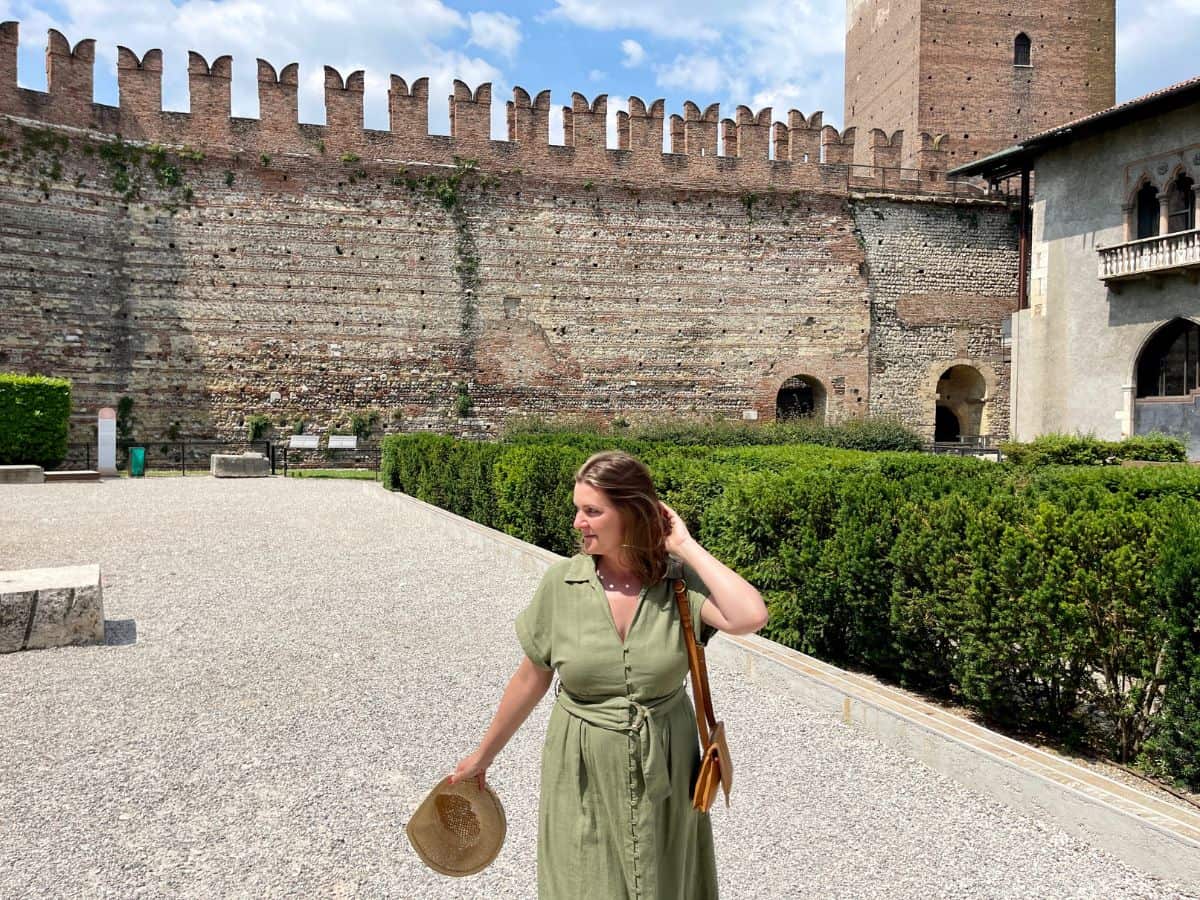
Located inside Verona’s old castle , this museum contains hundreds of paintings, sculptures, and other artifacts from the past.
The castle grounds are most impressive if you don’t have time to visit the museum. It is definitely a must-see!
Visit the Verona Cathedral
The Verona Cathedral is a beautiful 11th-century cathedral that is one of the oldest in all of Italy and has some incredible architecture and artwork that’s worth seeing.
Located close to the river, I would prioritize seeing it if you can.
Take a day trip to Lake Garda
One of the best ways to escape the crowds of Verona is to plan a day trip to nearby Lake Garda . Here you can take in stunning views, enjoy some watersports, and relax at one of the many lakeside cafés.
🎟️ Day Tour to Lake Garda Tickets: Check Rates & Availability
Climb The Lamberti Tower

One of my favorite things to do when I visit a new city is a climb a tower to get that ariel view. The Lamberti Tower has a bell tower you can climb for the best view of Verona.
Verona is such a charming city that has something for everyone. I hope my list gives you some ideas on what to do when visiting this beautiful city!
🎟️ Skip The Line: Get Your Tickets to Climb the Lamberti Tower! Check Rates & Availability!
Best Hotels in Verona
I prefer to stay in the heart of the city and the best hotel is Hotel Milano & Spa ! Located in Piazza Bra, you can’t get more central than this!
Hotel Milano has modern amenities, spacious rooms, and a rooftop bar with a jacuzzi with a view of the arena !
The hotel is pet friendly and also has parking! So if you rent a car you can easily park it on site which is very convenient.
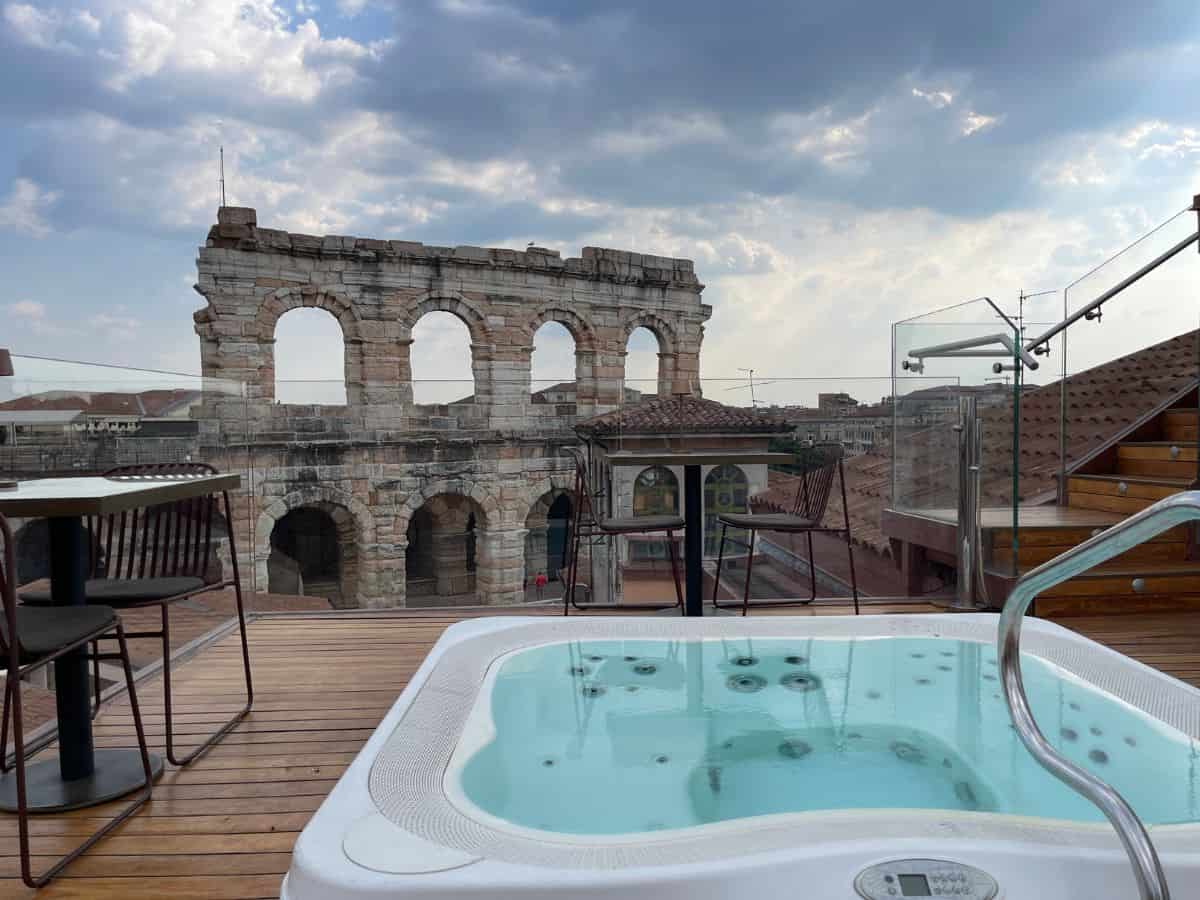
Some other hotels in the city center worth staying at are:
- Vista Palazzo ($$$$)
- Opera Relais De Charme ($$$)
- La Maison De Charme ROOMS ($$)
Pro of Staying in Florence
Staying in Florence, Italy is an incredible experience that everyone should have at least once in their lifetime. Even in winter, there are things to do in Florence!
From its stunning architecture to the many cultural attractions, there are so many wonderful things to explore and enjoy while visiting this magical city.
One of the best pros of staying in Florence is that it is incredibly easy to get around. Not only are the main attractions within walking distance, but there are also public transportation options such as buses and taxis that make getting from place to place a breeze.
Plus, Florence is full of bike paths so you can rent a bicycle for an affordable rate and explore the city in a fun and eco-friendly way.
The food in Florence is another great pro for staying here. From traditional Tuscan dishes to modern Italian fare, you can find something delicious no matter what cuisine you want.
Plus, many restaurants have outdoor seating so you can enjoy your meal with a beautiful view of the city.
One more pro of staying in Florence is that it has plenty of nightlife options, too. As I mentioned, this isn’t a draw for me, but it could be the one thing that helps you make the decision between Florence and Verona.
Cons of Staying in Florence
Unfortunately, I found staying in Florence does have a few cons. The first is that it can be pretty busy and crowded during peak season , and this was the deal breaker for me.
In the summer months, tourists flock from all over the world to visit this historic city. It can make getting around more of a challenge due to the sheer number of people.
Another con for staying in Florence is that accommodation tends to be expensive, especially during peak season. While Airbnb can be an affordable option, it can still be difficult to find something that fits your budget.
Something else to consider if staying in Florence is that the city is quite spread out, making it difficult to explore everything in one day. This means you’ll have to plan carefully if you want to make sure you get to see all the sights.
Overall, although there are a few cons, staying in Florence is an amazing experience that no one should miss out on. With its stunning architecture and rich culture, it’s a city everyone should visit at least once in their lifetime.
Top Things To Do In Florence
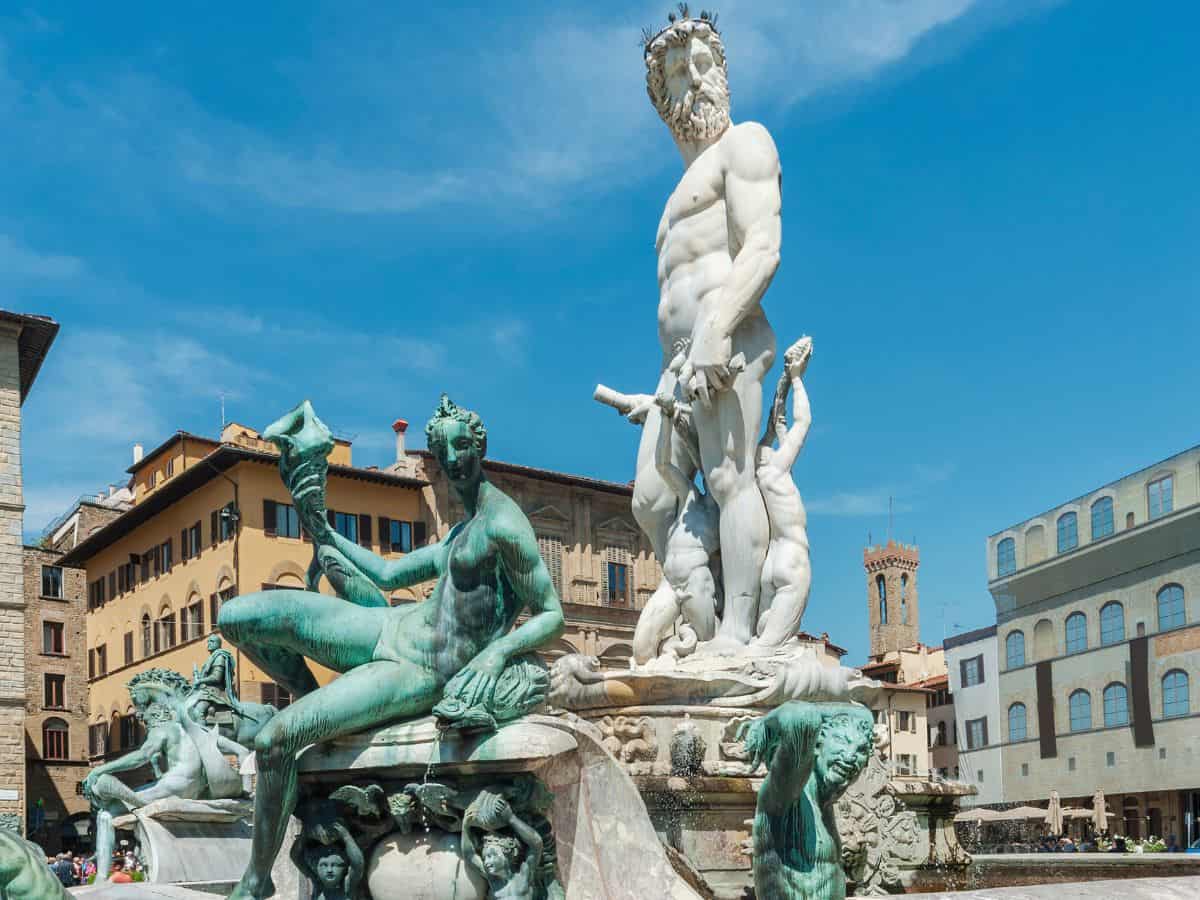
When it comes time to plan your itinerary for Florence, it can be hard to decide where to start!
To help you make the most of your time there, here are the top sights and my top things to do in Florence:
Climb the duomo.

The majestic red-tiled dome of the Santa Maria del Fiore Cathedral is a must-see on any Florence itinerary.
One of the best things to do to get a breathtaking view of the city is to climb to the top. You can purchase tickets online and get access to a reserved entry.
I would highly recommend booking in advance! If you only have one day in Florence , I would put this at the top of the list.
❤︎ Organized Tour: Another way to visit the Cathedral, Duomo Museum, and Baptistery is on a walking tour. Check Rates & Availability !
Visit the Uffizi Gallery
This world-class art museum houses some of Italy’s greatest works from renowned Renaissance artists like Leonardo da Vinci, Michelangelo, and Raphael.
Stroll Across Ponte Vecchio
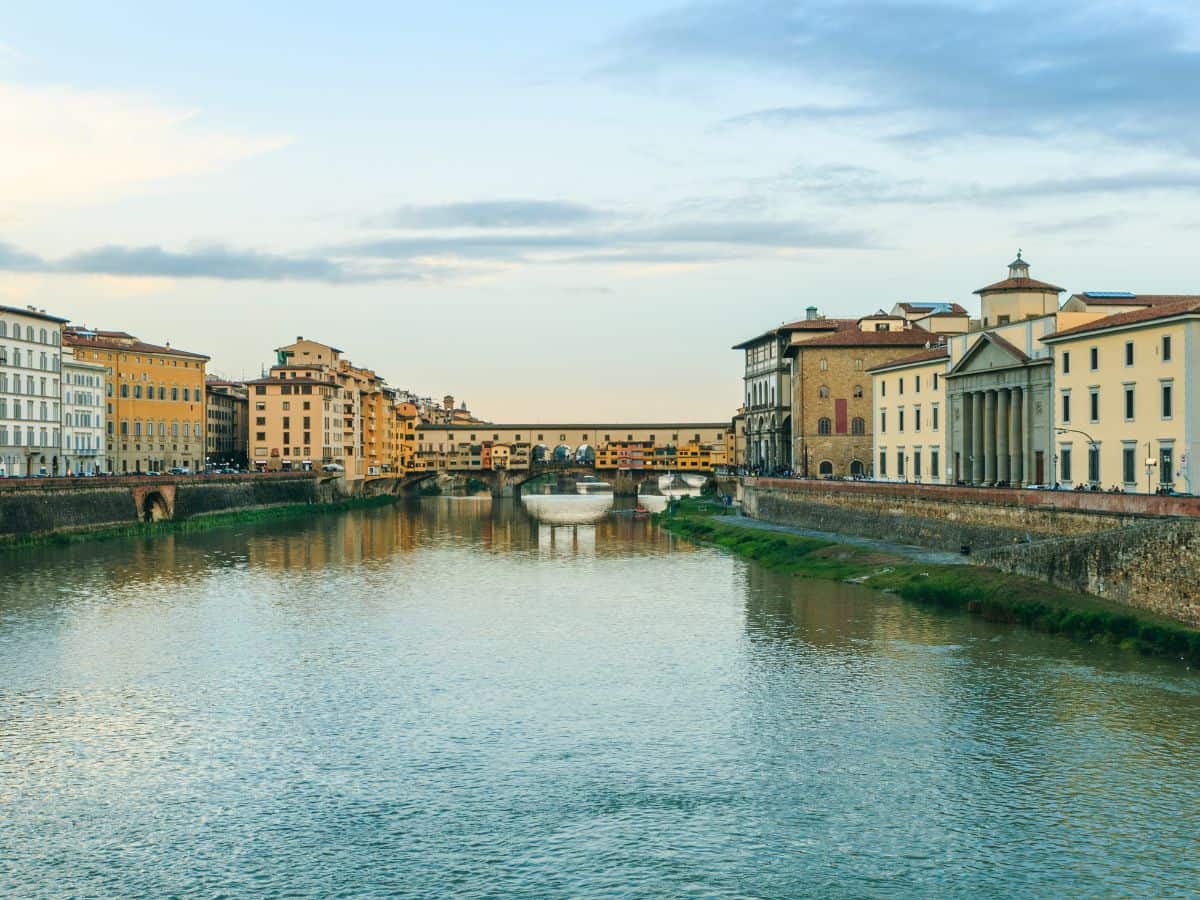
This iconic bridge is a great spot for people-watching and admiring the view of the Arno River below.
And don’t miss out on all the unique jewelry shops that line both sides of the bridge!
Wander Through Pitti Palace
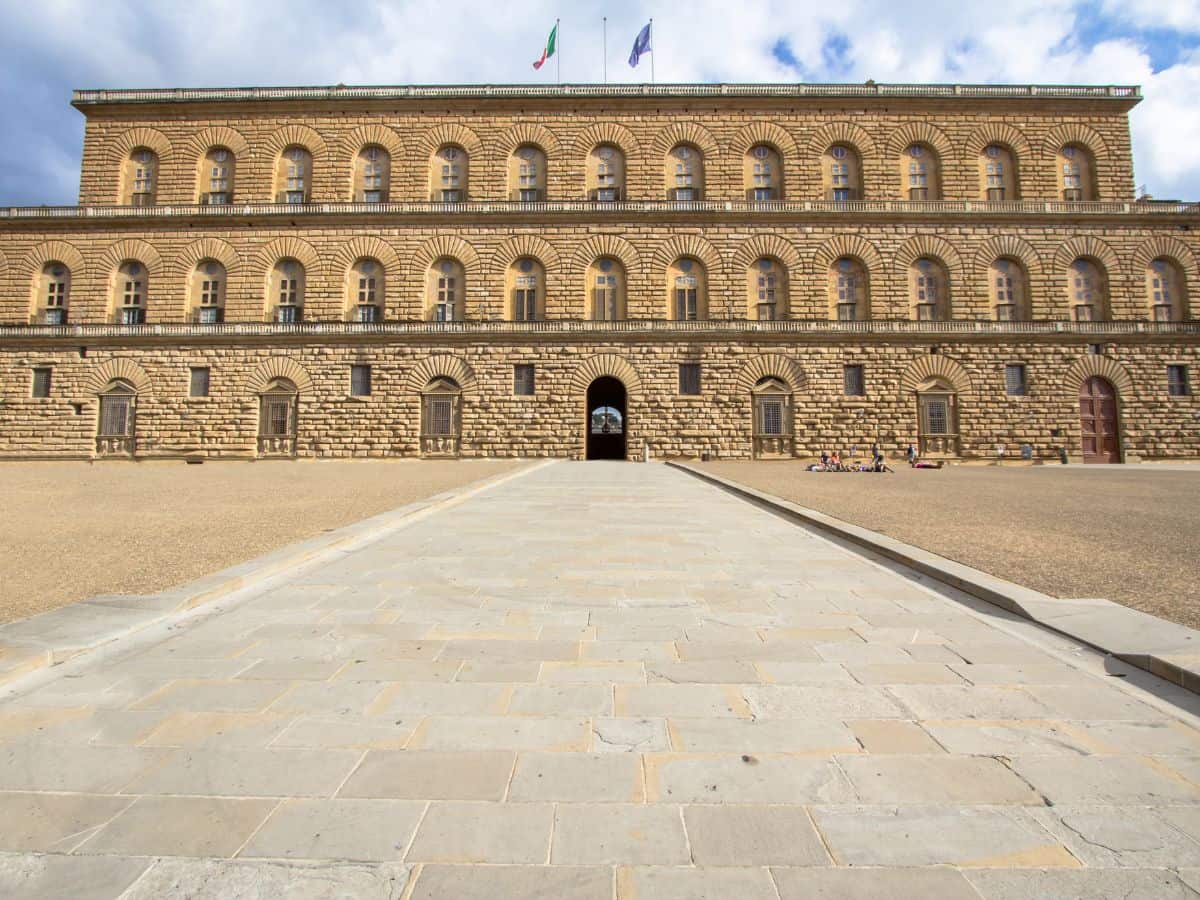
One of Florence’s most splendid palaces, the Pitti Palace is home to a number of museums and galleries, as well as the Boboli Gardens.
This former palace is one of Florence’s largest Musuems of Modern Art from the 18th century to World War I.
🎟️ Get Tickets: Grab tickets to the Pitti Palace ahead of time! Check Rates & Availability
Explore San Lorenzo Market
This bustling outdoor food market is a great spot for finding souvenirs like leather goods, jewelry, and handmade crafts.
Here at the market is a great place to do some wine tasting of the local varietals!
Watch The Sunset
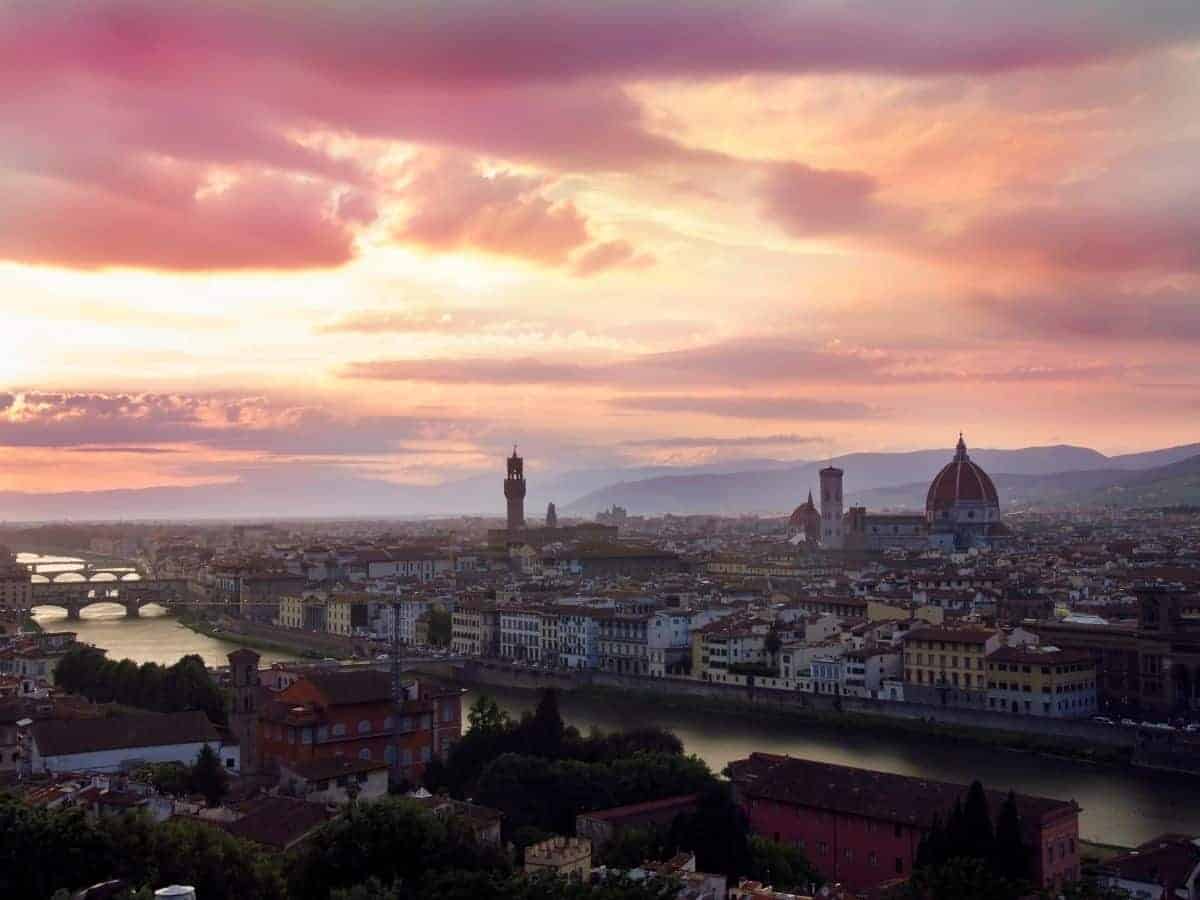
If you are looking for a good place to watch the sunset in Florence then head to Piazzale Michelangelo and watch the sunset over this historic city.
A great way to experience it is by bringing your own picnic of bread, cheese, and wine up to Piazzale Michelangelo .
Get everything you need for your picnic at Formaggioteca Terroir !
Where to Stay in Florence
One of the nicest areas to stay in Florence is Piazza Michelangelo. It is a little expensive, but you only live once, so I say stay somewhere nice!
❤︎ Click here to see all the best hotels in Florence.
Do You Need a Car in Northern Italy?

If you’re planning a visit to Northern Italy, you may be wondering whether you need a car.
In general, the answer is maybe – Northern Italy is well-connected by public transportation and it’s easy to get around without a car.
From my experience there are certain occasions when renting a car might be beneficial .
For example, if you’re planning to explore a number of cities or smaller towns, then having your own car could be convenient.
This is especially true if you’re visiting places that don’t have direct public transportation links. Like some epic wineries located outside the cities.
Additionally, having a car can make it easier to visit scenic spots like hilltop villages.
On the other hand, if you’re only staying in one or two cities, then a car may not be necessary.
Florence and Verona have excellent public transportation and walking is often an option as well.
It all really depends on your travel style and whether you are looking to make day trips.
Final thoughts on Verona vs Florence
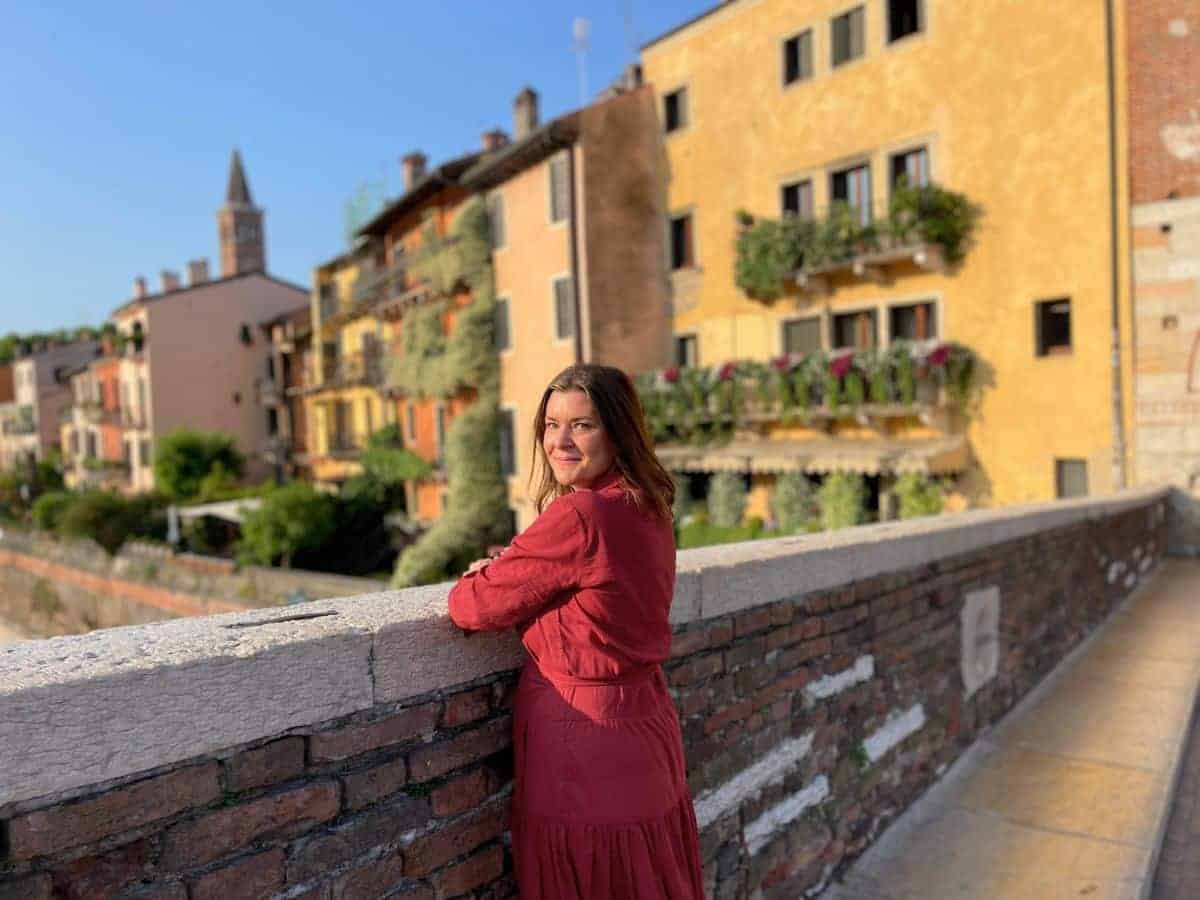
This blog post has given you all the pros and cons of both Verona and Florence so that you can make the best decision for your trip to Italy.
I personally had a more enjoyable experience staying in Verona based on my interests and travel style. Verona just felt like a little hidden gem that I’ve visited more than once.
The choice is totally up to you, in Italy, you likely won’t be disappointed with whichever decision you end up making.
Pin It For Later
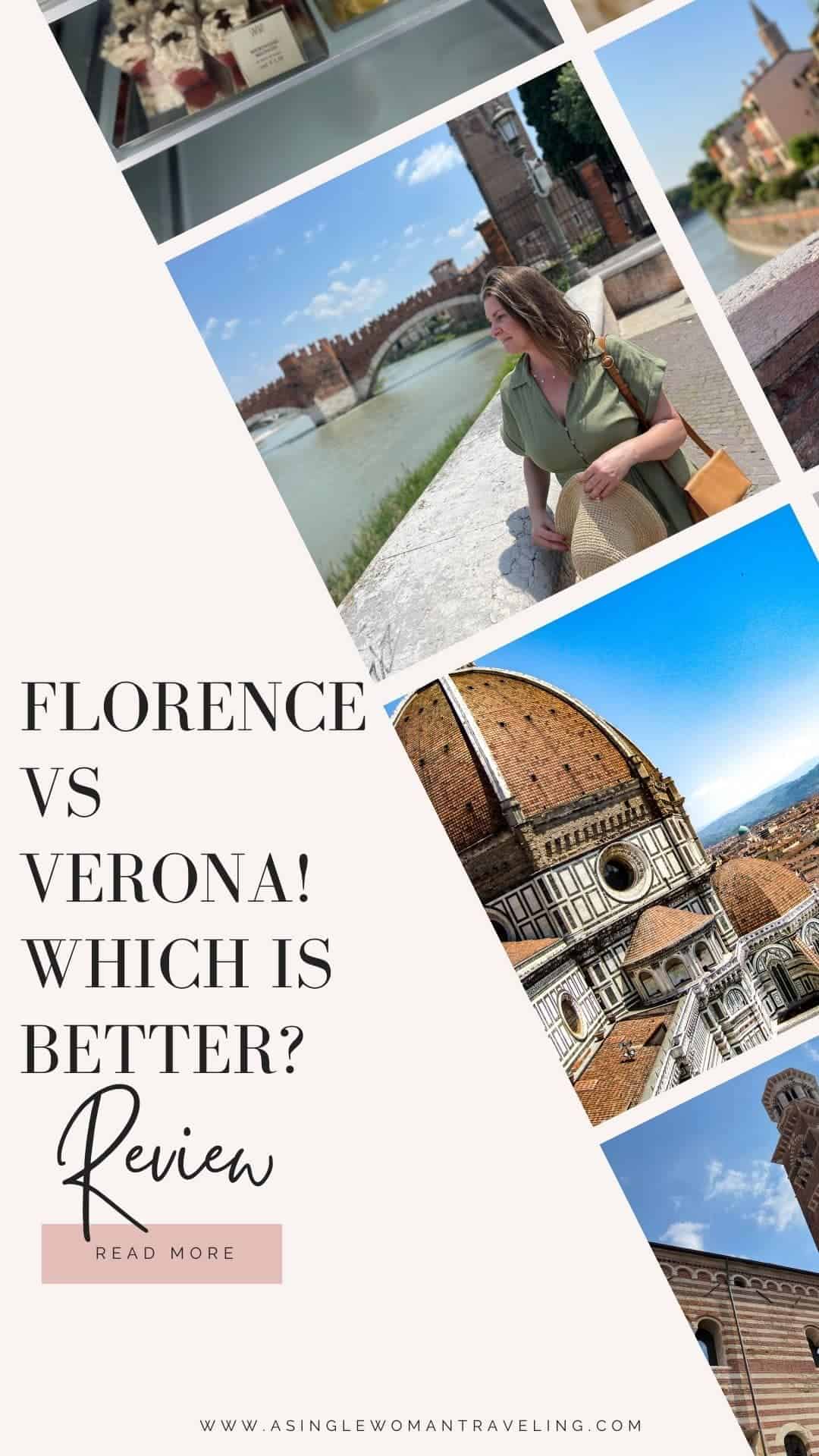
Ready to Explore
More of italy.
🫶 Did you enjoy this article? Help fellow travelers and share this guide with the buttons below!
Melissa Byron, a seasoned solo traveler since 2009, is the founder & visionary behind A Solo Woman Traveling. Drawing from her extensive personal experience globetrotting solo to over 40 countries, she has dedicated herself to a mission: crafting invaluable guides and itineraries for women who embark on solo adventures.
Related Posts
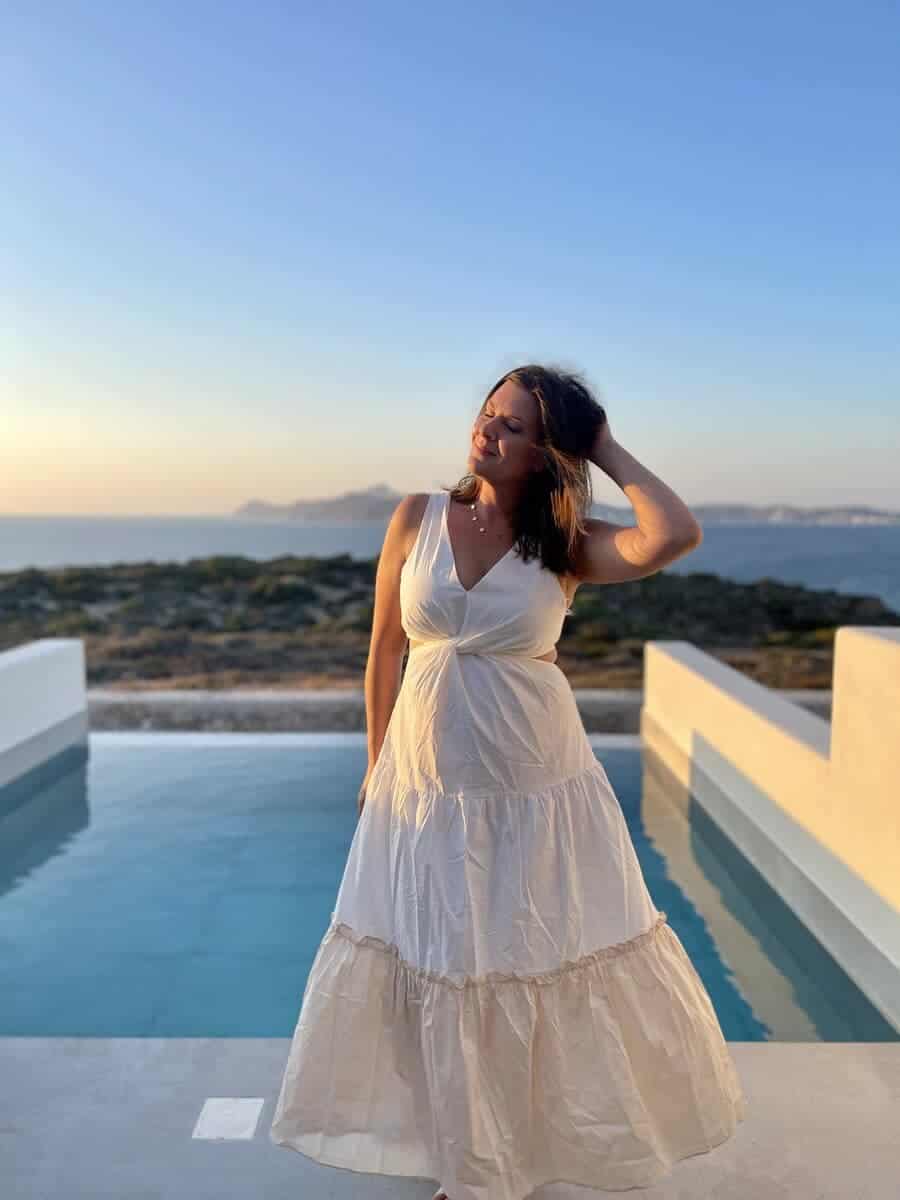
Are Solo Trips to Greece Safe For Women? The Truth From Female Travelers
If you are wondering “is Greece safe for solo female travellers” you’ve come to the right place. I have been taking solo trips to Greece for the past 10 years! It’s definitely a safe place for women to travel. In 2023, I moved and found a new home in Athens, a place where I’ve always…
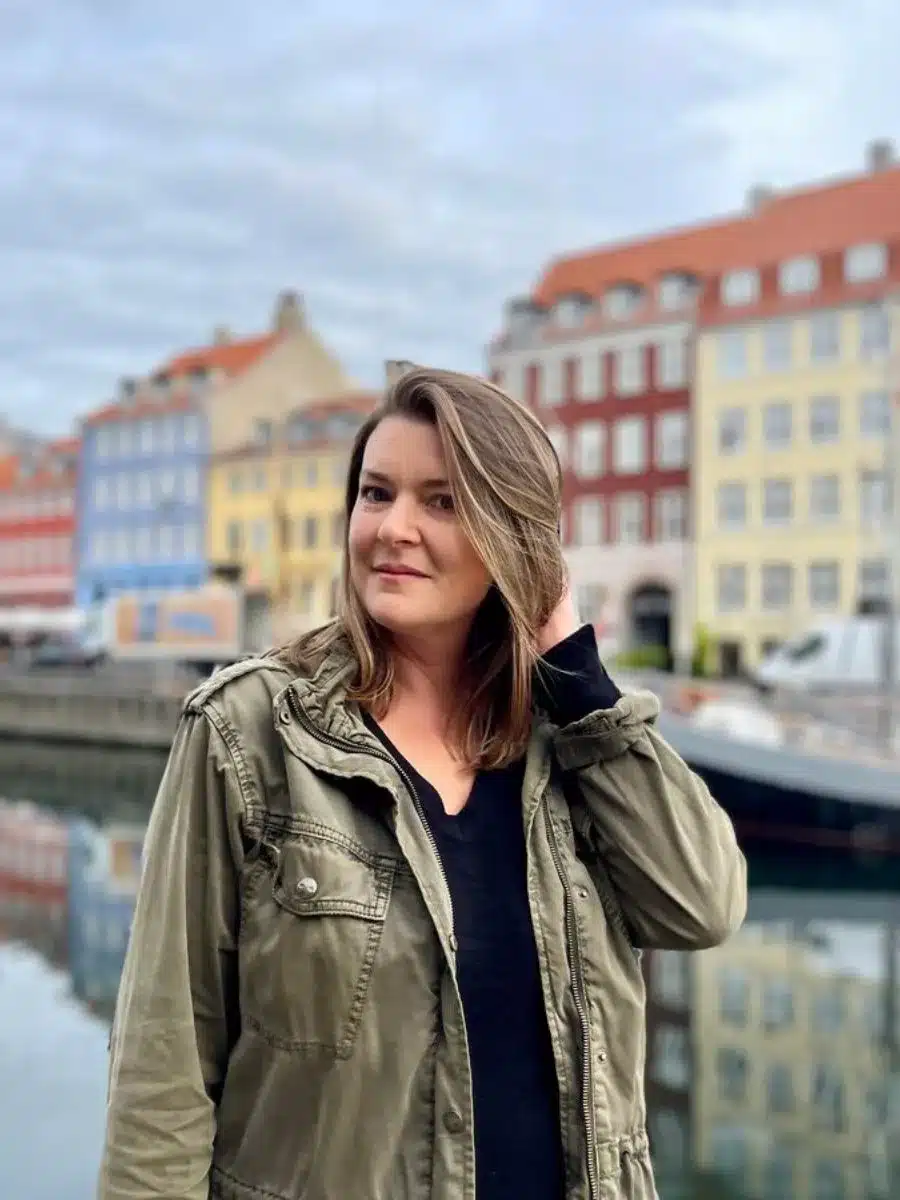
Foolproof Copenhagen 3 Day Itinerary + Map
Three days in Copenhagen will go by in the blink of an eye, so if you need help to craft a truly foolproof Copenhagen 3-day itinerary, I’ve got you covered. I’ve been to Copenhagen so many times, I consider myself a local. My itinerary, ideal for first-timers, hits every must-see spot and hip restaurant, in…
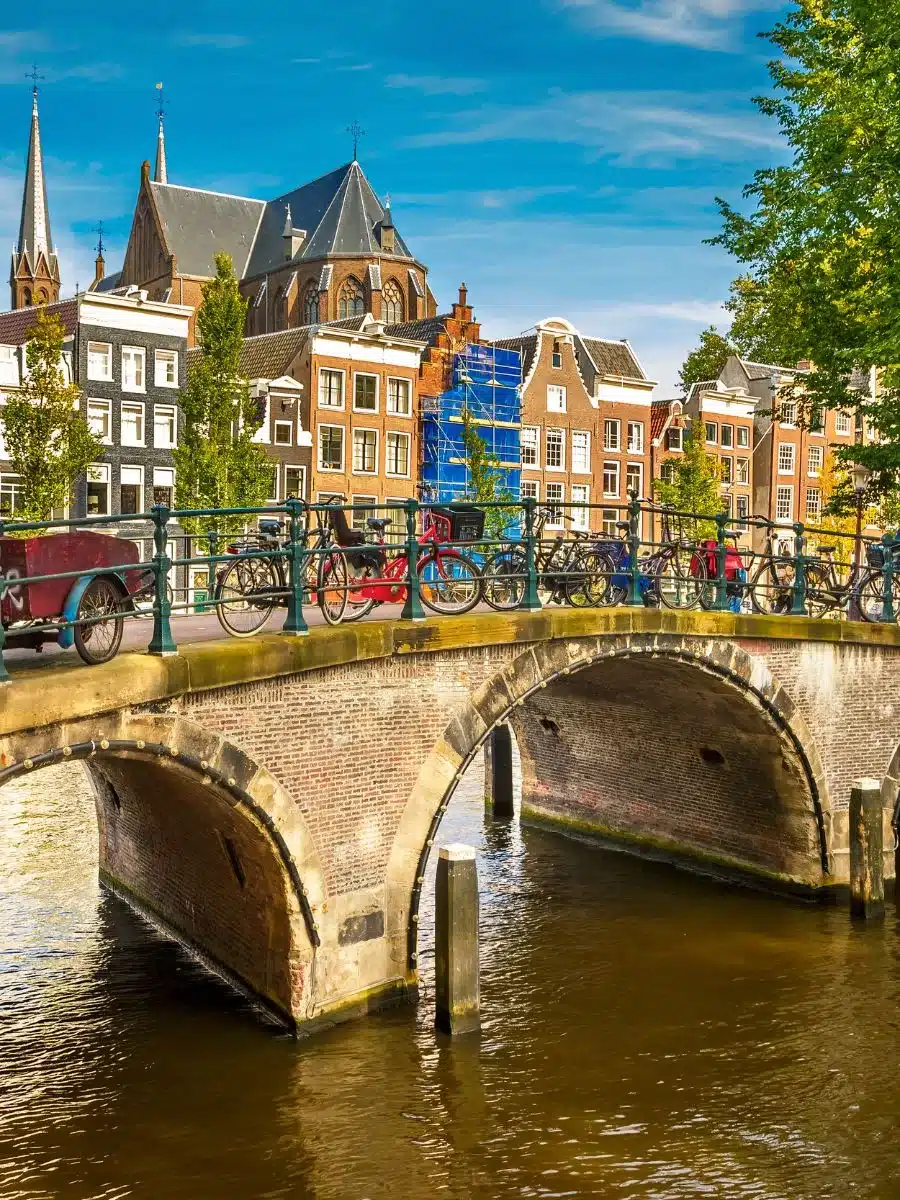
Ultimate Guide For a Safe Solo Trip to Amsterdam + Map
Back in the day, when I was figuring out the ropes of solo travel, safety was my top priority. I’d spend hours searching “Is Amsterdam safe for solo female travelers?” and looking for the safest places to stay. Now, after hitting up Amsterdam solo on three different occasions over the years, I’ve decided to put…

The Complete Day Trip to Verona Itinerary & Guide + Map
Let me take you on a day trip to one of my favorite Italian cities, VERONA! I’ve been to this picturesque town twice in the last few years! It is one of the easiest places to reach from nearby destinations such as Milan, Florence, and Bologna! Depending on where you are in Northern Italy, Verona…

How To Spend 3 Days in Belfast Solo + Map
Looking for ways to spend 3 days in Belfast solo? More and more women are traveling to Belfast solo, and I was one of them! I had only planned on visiting Belfast for one day, but I loved it so much I stayed for three! Belfast itself is pretty small, so if you don’t have…
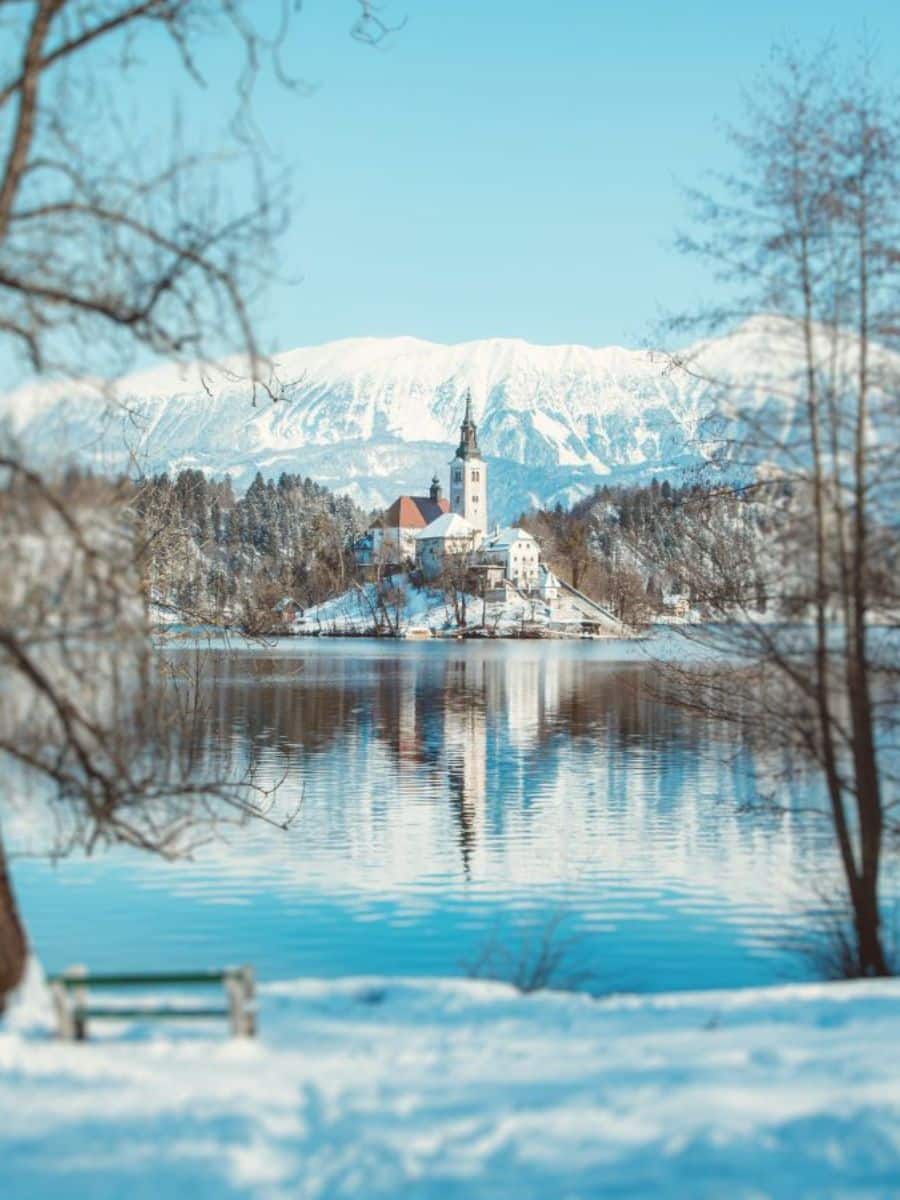
10 Most Magical Things To Do in Lake Bled in the Winter
Looking for the best things to do in Lake Bled in the winter? Though my visit was short, I was pleasantly surprised by all the fun things to do around the lake! It was the perfect little place to escape for a weekend. During winter time, Lake Bled is VERY quiet. I went at the…
What are you looking for?

- Privacy Overview
- Strictly Necessary Cookies
- 3rd Party Cookies
This website uses cookies so that we can provide you with the best user experience possible. Cookie information is stored in your browser and performs functions such as recognising you when you return to our website and helping our team to understand which sections of the website you find most interesting and useful.
Strictly Necessary Cookie should be enabled at all times so that we can save your preferences for cookie settings.
If you disable this cookie, we will not be able to save your preferences. This means that every time you visit this website you will need to enable or disable cookies again.
This website uses Google Analytics to collect anonymous information such as the number of visitors to the site, and the most popular pages.
Keeping this cookie enabled helps us to improve our website.
Please enable Strictly Necessary Cookies first so that we can save your preferences!
- Travel Planning Guide
A Travel Price Comparison for Italy Verona vs. Bologna for Food, Attractions, Nightlife, and Old Town

- Pros & Cons
- Attractions
- Backpackers
- Public Transit
- Walkability
- More time in Verona or Bologna?
- Which is Cheaper, Verona or Bologna? (Travel Cost Comparison)
Which is Bigger, Verona or Bologna?
- When to Visit Verona or Bologna?
Should you visit Verona or Bologna?
Which is cheaper to visit which is more expensive for vacation.
Should I visit Verona or Bologna? This is a common question asked by many travelers. By figuring out which city has activities that align with your interests along with knowing which is more affordable, you'll understand where you can get more bang for your buck. So, let's dive into the details and the data, which all comes from actual travelers.
Verona is a romantic, cultural, and beautiful city. With stunning beauty, it attracts visitors from all around. Other popular activities here include nightlife, food, and shopping.
Bologna is a fun, historical, and culinary city. The beauty of this spot is also one of the main reasons why visitors come. Visitors also love the museums, nightlife, and food.
Verona and Bologna: Pros and Cons
- Popular museums and historical sights
- Active nightlife
- Good for couples and romance
- Good for backpackers and budget travelers
- Impressive beauty
- Less family-friendly
- Less popular for students
- Family-friendly
- Good for students
Is there more to do in Verona or Bologna?
Travelers will usually find more to do in Bologna than Verona, as it is bigger with more sights, attractions, and activities for visitors. Bologna is more popular for its food, nightlife, and shopping, while Verona is known for its museums. Verona is more touristy than Bologna and is popular for its role as the setting of one of Shakespeare's most famous plays. Bologna is popular for its Terracota buildings, large international student population, and being the birthplace of Bolognaise pasta. It is also home to Piazza Maggiore.
How is Verona different from Bologna?
Which is better for a holiday.
Let's take a look at the differences and similarities between Bologna and Verona. Then, you can decide for yourself which place is better for your next trip.
Are the Museums and Historical Sights Better in Verona or Bologna?
Verona is a well-known place for its sights and museums. Also, Bologna is not as famous, but is still a good city to visit for its museums and history.
Many visitors head to Verona specifically to visit some of its top-rated museums and other sights. While most people know Verona as the setting of Shakespeare's play "Romeo and Juliet", there are also many unrelated but still impressive sights around town. Of course you must check out the Casa di Giulietta (Juliet's House and Balcony), but also make sure you visit the fortress of Castelvecchio, Arena di Verona, and Basilica of San Zeno Maggiore.
Bologna is a good place to visit if you're interested in museums or other recognizable sights. It has many historical and religious landmarks, active squares, and impressive museums including the Basilica of St. Petronius, St. Stephen Basilica, the Leaning Towers, and the Portico of the Madonna di San Luca.
Is the Food Better in Verona or Bologna? Which Destination has the Best Restaurants?
Bologna is an unbeatable place for its local flavors and cuisine. Also, Verona is not as popular, but is still a nice city for its local cuisine and restaurants.
For foodies, Bologna is an obvious choice, as it is one of the food capitals of the world. Foodies will appreciate the city's well earned culinary reputation. Some people even consider Bologna to be a food capital in Italy. There are cooking classes and food tours around town, as well as many great restaurants that serve up local dishes. Visitors should try Tagliatelle with Ragu (now famously known around the world as Bolognaise), Tortellini in broth, and Mortadella (salami).
Dining out in Verona is an experience not to be missed. Food is a source of pride for the locals in Verona, and you'll find excellent dishes in most eateries, even those catering specifically to tourists. There are many local recipes that are worth sampling while you're in the area including risotto with tastasal, potato gnocchi, and polenta.
Is Verona or Bologna Better for Nightlife?
Bologna is a great city for nightlife and partying. Also, Verona is not as popular, but is still a nice city for its evening party scene.
The nightlife in Bologna has something for everybody. The young population that is filled with international students means that the city has a fun and active nightlife scene. Some of the city's best neighborhoods for nightlife include Centro Storico, where the tourists hang out, the University District, which is perfect for students in their 20s, and Via dell'Indipendenza, which is popular for an upscale evening out.
There's a variety of activities in the evening in Verona. The nightlife scene caters to a mature crowd and there is a heavy focus on regional wine. There are many local bars and traditional osterie (inns) where you can sip local wine or hear live music.
Is Verona or Bologna Better for its Old Town?
It's fun to wander around the great old towns in both Verona and Bologna.
Many visitors explore the old town while visiting Verona. At the heart of the city is the old town, which is filled with medieval and Renaissance style architecture. It's easy to explore this beautiful area on foot.
There is a nice variety of sights in the old town of Bologna. The old town is filled with Terracota buildings, which give the city its nickname, La Rossa (The Red).
Is the Shopping Better in Verona or Bologna?
Bologna is a great city for its shopping opportunities. Also, Verona is not as popular, but is still a nice city for its shopping areas.
Bologna is well-known for its shopping. The city hosts regular open-air markets where you can pick up local produce or local items. It is among the best shopping destinations in the region. For some of the city's best shopping, head to Piazza Maggiore, Mercato di Mezzo, Mercato delle Erbe, or Via Rizzoli.
Many visitors go to Verona to go shopping. The most well known shopping street is Corso Santa Anastasia, which has many antique shops as well as jewelry stores and high end boutiques.
Is Verona or Bologna Better for Families?
Bologna is a popular place for its kid-friendly activities. However, Verona is not known for its family-friendly activities.
Bologna offers lots of family activities. There are kid-friendly museums such as Museo Geologico Cappellini and the interactive history museum of Museo della Storia di Bologna. There's even a museum solely dedicated to gelato - Gelato at Carpigiani Museum. If your kids need a bit of time in nature, check out Dulcamara farm or the Botanic Garden. On the weekend you many be able to catch a show at Margherita's Puppet Theatre.
Verona is not the most family-friendly destination. You can head to the top of the the Lamberti Tower and, of course, check out the Romeo and Juliet balcony. Wandering the streets and grabbing gelato is also fun for the whole family.
Is Verona or Bologna Better for Couples?
Verona is a well-known place for couples. Also, Bologna is not as famous, but is still a good city to visit for romance.
Verona is a very popular place to visit for couples. As the setting for Shakespeare's famed "Romeo and Juliet", this town is seeped in romantic history. In addition to checking out the classic balcony, couples can enjoy seeing an opera at Verona Arena or seeking out views of the beautiful city. Crossing the romantic Ponte Pietra is another must-do romantic activity in the area.
Bologna is a nice destination for couples. With beautiful museums, interesting architecture. and lively squares, this is a great city for a couple's holiday. It's filled with romance, but it has less tourist crowds than some of Italy's more popular cities.
Is Verona or Bologna Better for Backpackers and Budget Travelers?
Bologna is a great city for backpackers and budget travelers. Also, Verona is not as popular, but is still a nice city for backpackers.
Many backpackers visit Bologna. It's not a popular as some of the other cities in Italy and Europe, but it still has a number of hostels and a good backpacker scene.
Verona is popular with backpackers and budget travelers. Backpackers rarely spend more than a day or two in town, but there are hostels in the area that offer cheap accommodation.
Is Verona or Bologna Better for Students?
Bologna is an unbeatable place for its student-friendly activities. Also, Verona is not as popular, but is still a nice city for students.
Many students frequent Bologna. It's a top study abroad destination in Italy and is home to a few great universities including the well ranked University of Bologna. There are many great activities for students and a variety of fun places to explore.
Verona is a good city to visit for students. The city offers a more authentic Italian experience than some of the more popular tourist and study abroad destinations in Italy.
Is Verona or Bologna Better for Public Transit? Which Is Easier to Get Around Without a Car?
Verona and Bologna both offer good public transit to get you around.
While Verona offers some public transit options, it might not be your first choice. ATV operates buses through the city.
Bologna has a few public transit options. There is an efficient and reliable bus system.
Is Verona or Bologna a more walkable city?
Verona and Bologna are great when it comes to walkability.
Verona is a very walkable city. It's a compact city that's easy to explore on foot. Many locals get around by walking or biking.
Bologna is a very walkable destination. Most sights are always within a 30 minute walk, and the city itself is very walkable.
For even more information, also check out Is Verona Worth Visiting? and Is Bologna Worth Visiting? .
Should I spend more time in Bologna or Verona?
How long in verona or bologna.
Visitors can find plenty of fun things to do in both Verona and Bologna. In our opinion, Bologna has more to see and do, so we recommend spending more time in Bologna than Verona . However, 1-3 days is a good amount of time to spend in either destination.
Families should spend more time in Bologna than Verona. Because of the many family-friendly attractions and fun things to do for kids in Bologna, it's a great place to visit with the whole family.
Couples should spend more time in Verona than Bologna. You'll find plenty of romantic sights and fun activities in Verona that are great for a weekend getaway or a longer couple's trip.
Backpackers and budget travelers should spend more time in Bologna than Verona if your budget allows for it. With a larger number of budget-friendly sights, good nightlife, and active things to do, anyone traveling on a budget would have a good time in Bologna.
- How many days in Verona or Bologna? Ideal Length of Stay Verona 1-3 Bologna 1-3
One day in Verona or Bologna?
In Verona, you'll find nightlife and food. Most visitors spend time around the old town while in the area. This city offers something for everyone. This would be the perfect place to spend one day, as it has just the right amount of activities.
Many travelers enjoy the museums and nightlife when visiting the destination of Bologna. The old town is one of the main draws for visitors. One day is often enough time to do most activities.
A weekend in Verona or Bologna?
In Verona, you'll find food and shopping. The length of your trip often depends on your style of travel. A weekend here is typical. Visiting the old town is also a must. A weekend is a great amount of time to relax and see the many things that Verona has to offer.
Bologna is a great place to explore. It is common to spend a weekend here. Don't miss the food, as that's what most people do. With all of its activities, you can easily fill a weekend here. Your budget might influence how long you stay.
Five days in Verona or Bologna?
Verona is a great place to explore. The old town is one of the main draws for visitors. Five days is more than enough time to enjoy everything. Take some day trips to nearby places to fill the extra days. Anyone can find something fun to do here.
It's hard to know how much time to spend in Bologna. Don't miss the food, as that's what most people do. Make sure you visit the old town while you're here. Five days may feel like too much time unless you plan to do a lot of relaxing. It has many unique tourist attractions and fascinating things to do.
A week in Verona or Bologna?
It's hard to know how much time to spend in Verona. Many people enjoy the museums and nightlife when visiting Verona. Exploring the old town is a popular activity. One week may feel like too much time unless you plan to do a lot of relaxing.
Travelers enjoy the shopping and museums when visiting the fun destination of Bologna. This city offers a variety of activities to choose from. Most visitors spend time around the old town while in the area. Most people find that one week is more than enough time to see everything.
For some great organized tour ideas, see The Best 10-Day Tours in Italy , The Best One Week (7-Day) Tours in Italy , The Best 2-Week Tours in Italy , and The Best Bicycle Tours in Italy .
Which place is cheaper, Bologna or Verona?
These are the overall average travel costs for the two destinations.
- Verona Prices Italy Prices Bologna Prices Italy Prices
- Average Daily Cost Per person, per day Verona € 168 Bologna € 159
The average daily cost (per person) in Verona is €168, while the average daily cost in Bologna is €159. These costs include accommodation (assuming double occupancy, so the traveler is sharing the room), food, transportation, and entertainment. While every person is different, these costs are an average of past travelers in each destination. What follows is a categorical breakdown of travel costs for Verona and Bologna in more detail.
Accommodation
- Accommodation Hotel or hostel for one person Verona € 107 Bologna € 87
- Accommodation Typical double-occupancy room Verona € 214 Bologna € 174
Compare Hotels in Verona and Bologna
Looking for a hotel in Verona or Bologna? Prices vary by location, date, season, and the level of luxury. See below for options and compare which is best for your budget and travel style.
Hotels in Verona
Hotels in Bologna
Kayak helps you find the best prices for hotels, flights, and rental cars for destinations around the world. Compare prices for multiple destinations when planning your next trip.
Local Transportation
- Local Transportation Taxis, local buses, subway, etc. Verona € 6.88 Bologna € 21
Typical Local Transportation Prices in Verona
Below are a few samples from actual travelers for transportation costs in Verona:
- Bus From Airport € 6.00
Hired Cars and Shuttles in Verona
Also for Verona, here are a few examples of actual transportation services:
- Verona to Verona Airport (VRN) - Departure Private Transfer: $27
- Luxury Transfer from Verona airport to Verona city: $37
- Verona Private Transfer - to/from any location: $56
- Private Transfer from/to Valerio Catullo Airport to/from Verona : $58
- Private Transfer Verona Center to Valerio Catullo Airport VRN: $64
- 1-Way private Transfer to Valerio Catullo Airport: $69
- Verona Airport (VRN) to Venice - Arrival Private Transfer: $80
- Transfer Verona airport - Verona center: $84
- Private Transfer from Verona Airport (VRN) to Venice City or Port: $85
- Verona Airport (VRN) to Venice port - Arrival Private Transfer: $85
- Verona Airport (VRN) to Venice - Arrival Private Transfer: $95
- Verona Airport (VRN) to Val Gardena/Alta Badia - Arrival Transfer: $103
Hired Cars and Shuttles in Bologna
Some specific examples of transportation prices in Bologna:
- Bologna Airport: Round Trip Transfer to Venice+Water Taxi: $1,655
- Bologna Airport(BLQ): Roundtrip Transfer to Venice p-le Roma: $1,396
- From Private Venice Day Trip with Transfer: $766
- Siena: Private Round-Trip Transfer from/to Bologna Airport: $686
- Bologna Airport (BLQ): One Way Transfer to Ravenna Port/City: $521
- Tour Ferrari, Lambo, Parmesan, Vinegar, Wine with Transfer: $500
- Bologna:Parmesan, Prosciutto, Balsamic, Wine, Lunch&Transfer: $500
- Ferrari&Lambo, Parmesan, Balsamic, Red wine with Transfer: $495
- Florence: Private Transfer from Bologna Airport (BLQ): $427
- Ferrari, Lambo, Parmesan, Balsamic tour w/Lunch & Transfer: $388
- Bologna Airport(BLQ): 1-Way Transfer to Venice Piazzale Roma: $372
- Bologna Airport (BLQ): Private Transfer to Bologna: $293
Is it cheaper to fly into Verona or Bologna?
Prices for flights to both Bologna and Verona change regularly based on dates and travel demand. We suggest you find the best prices for your next trip on Kayak, because you can compare the cost of flights across multiple airlines for your prefered dates.
- Food Meals for one day Verona € 54 Bologna € 39
Typical Food Prices in Verona
Here are some examples of typical meal expenses from previous travelers to Verona:
- Sitdown Dinner (for Two) € 36
- Casual Lunch (for Two) € 23
- Cappucino € 1.75
Food Tours and Cooking Classes in Verona
For Verona, here are some samples of tours and activities related to meals and dining experiences:
- Guided Food Tour with Wine Tasting: $63
- Tortellini Cooking Class and Lunch with Mamma Ivana: $64
- Small Group Cooking Class in Valpolicella with Licensed Guide: $77
- Vegetarian Dinner Cooking Class in Verona : $89
- Dining Experience at a local's Home in Castelnuovo del Garda with Show Cooking: $92
- Dining Experience at a local's Home in Fumane with Show Cooking: $92
- Verona Food Tour with Guide: $95
- Food Tour with Amarone Wine Tasting: $95
- Wine and Food Tour with Dinner and Tastings: $96
- Small-group Street food tour in Soave: $97
- Small-group Street food tour in Verona: $97
- Valpolicella: Traditional cooking class with local products: $101
Food Tours and Cooking Classes in Bologna
Also, here are some specific examples of food and dining related activities in Bologna.
- Exclusive Cooking Class - Pasta Tagliatelle Ragu & Spritz: $11
- Exclusive Bologna Cooking Class - Pasta Tagliatelle Ragu & Spritz: $11
- Virtual Cooking Class: Ravioli variations with classic tomato sauce: $35
- Bologna Traditional Home Cooking Class with Lunch or Dinner: $73
- Bologna Food Tour including Tagliatelle, Mortadella, Wine: $73
- Traditional Bolognese Cooking Class with a Meal: $80
- Traditional Recipes Cooking Class with Local Wines: $82
- Tastes and Traditions Food Tour with Market Visit: $84
- Hands on Home Cooking Class: $84
- Walking Food Tour with a Local Guide: $84
- Tastes & Traditions of Food Tour with Market Visit: $86
- Dining Experience at a local's Home in Dozza with Show Cooking: $92
Entertainment
- Entertainment Entrance tickets, shows, etc. Verona € 12 Bologna € 38
Typical Entertainment Prices in Verona
For Verona, here are some examples of average entertainment and activity prices from previous travelers:
- Juliet's House Entry € 4.00
- Verona Card € 10
Tours and Activities in Verona
Also, here are some specific examples of entertainment, tickets, and activities for Verona.
- First Discovery Walk and Reading Walking Tour: $3.19
- Digital Guide made by a Local for your walking tour: $6.70
- Solferino Ticket Valid for Visit to the Museum and the Rocca: $6.78
- City Exploration Game and Tour: $6.92
- Highlights Self-Guided Scavenger Hunt and City Tour: $7.98
- Verona's History and Highlights: Self-Guided Audio Tour: $7.99
- The city of Romeo and Juliet: A self-guided audio tour through Verona: $7.99
- Tour Escape Verona - The happy ending of Juliet: $9.58
- Self-Guided Walking Tour and 1-Day Itinerary: $10
- Non guided tour of the wine museum and amarone tasting: $11
- Verona and Lake Garda: Self-Guided Audio Tour: $11
- Self-Guided Audio Tour: $11
Typical Entertainment Prices in Bologna
Some typical examples of activities, tours, and entrance ticket prices in Bologna are as follows:
- Food Tour (for 2) € 31
- Wine Tasting Tour (for 2) € 115
- Hop-on-Hop-off Bus Tour (for 2) € 67
- National Gallery Museum Bologna (for 2) € 12
- Archaeology Museum of Bologna (for 2) € 12
Tours and Activities in Bologna
Some specific costs of activities, tours, and entrance tickets for Bologna are as follows:
- the red medieval pearl and its delicious food (private tour): $282
- 2 Hours Bologna Guided Private Tour for Kids and Families : $178
- 2.5-hour Bologna City and University Walking Tour: $136
- 3 hours walking tour with tastings: Bologna "La Grassa": $184
- BOLOGNA FOOD WALKING TOUR (morning or evening PRIVATE tour): $206
- Best of Private & Personalised Walking Experience: $81
- Best walking tour of Bologna: $157
- Bike Tour Bologna: $141
- Bologna - Old Town Private Historic Walking Tour: $372
- Bologna 3 hour Private Guided City Tour of Must-see Sites: $260
- Bologna : Highlights & Hidden Gems Private Walking Tour: $96
- Bologna : Historic Center Walking Tour: $69
- Alcohol Drinks for one day Verona € 11 Bologna € 28
Sample the Local Flavors in Verona
Also in Verona, these are the prices for nightlife and alcohol related activities from various tour providers:
- Wine tasting in Bardolino: $26
- Valpolicella Wine Tour and Tasting in Medieval Court: $33
- Amarone Wine Tour: $35
- Amarone Wine Tasting in Valpolicella | 3 Wines + Snacks: $36
- Montresor Winery Visit with Wine Tasting and Snacks: $37
- Valdadige: Roeno Guided Tour and Wine tasting: $37
- Food and Wine Tasting in Valpolicella: $38
- Verona area: Wine Tasting Experience in Valpolicella: $38
- Unique Wine tasting in Verona, with Amarone docg: $42
- Visit and wine tasting at Tenuta La Cà: $42
- Lazise: Historical Center Wine Tasting Tour: $43
- Lake Garda: Wine Tour & Tasting Experience in Bardolino area: $43
Sample the Local Flavors in Bologna
Here are a few nightlife and alcohol tours and activities from local tour providers in Bologna:
- Wine Tasting: $20
- Modena area: Lambrusco Wine Tasting Experience: $38
- From Wine Tasting and Vineyard Tour with the winemaker: $53
- Colli Bolognesi: wine tasting at Montevecchio Isolani: $53
- Bologna Food & Wine tour with a local Chef: $68
- Wine Tasting Tour in One of the Oldest Inns: $69
- Bologna Wine Tasting in One of the Oldest Inns: $71
- Small-Group Half-Day Wine Tour with Tasting in Dozza Village: $102
- Wine Tasting Experience with a Local Guide: $117
- Exclusive Italian Wine Tasting: $130
- Food and Wine Tasting Tour in Bologna with a local guide : $137
- Bologna private wine tour : $163
When comparing the travel costs between Verona and Bologna, we can see that Verona is more expensive. However, the two cities are actually relatively comparable in price, as the difference is somewhat minimal. Generally, this means that you could travel with generally the same travel style and level of luxury in each place. Since both cities are in Europe, it's no surprise that their costs are relatively close, as many destinations here have somewhat similar travel prices overall.
If you're trying to decide if either of these two destinations are within your price range, also see Is Verona Expensive? and Is Bologna Expensive? .
Bologna has a larger population, and is about 47% larger than the population of Verona. When comparing the sizes of Verona and Bologna, keep in mind that a larger population does not always imply the destination has more attractions or better activities. So, always research the type of place that you want to visit along with the activities and attractions that interest you.
When is the best time to visit Verona or Bologna?
Both places have a temperate climate with four distinct seasons. As both cities are in the northern hemisphere, summer is in July and winter is in January.
Should I visit Verona or Bologna in the Summer?
Both Bologna and Verona during the summer are popular places to visit. The family-friendly experiences are the main draw to Verona this time of year. Also, many travelers come to Bologna for the family-friendly experiences.
In the summer, Verona is around the same temperature as Bologna. Typically, the summer temperatures in Verona in July average around 24°C (75°F), and Bologna averages at about 24°C (75°F).
In Bologna, it's very sunny this time of the year. It's quite sunny in Verona. In the summer, Verona often gets less sunshine than Bologna. Verona gets 286 hours of sunny skies this time of year, while Bologna receives 316 hours of full sun.
Verona usually gets more rain in July than Bologna. Verona gets 62 mm (2.4 in) of rain, while Bologna receives 23 mm (0.9 in) of rain this time of the year.
- Summer Average Temperatures July Verona 24°C (75°F) Bologna 24°C (75°F)
Should I visit Verona or Bologna in the Autumn?
The autumn attracts plenty of travelers to both Verona and Bologna. Many travelers come to Verona for the shopping scene and the natural beauty of the area. Also, many visitors come to Bologna in the autumn for the shopping scene and the natural beauty of the area.
In October, Verona is generally cooler than Bologna. Daily temperatures in Verona average around 14°C (57°F), and Bologna fluctuates around 16°C (61°F).
Verona usually receives less sunshine than Bologna during autumn. Verona gets 137 hours of sunny skies, while Bologna receives 177 hours of full sun in the autumn.
Bologna receives a lot of rain in the autumn. In October, Verona usually receives less rain than Bologna. Verona gets 82 mm (3.2 in) of rain, while Bologna receives 123 mm (4.8 in) of rain each month for the autumn.
- Autumn Average Temperatures October Verona 14°C (57°F) Bologna 16°C (61°F)
Should I visit Verona or Bologna in the Winter?
The winter brings many poeple to Verona as well as Bologna. Many visitors come to Verona in the winter for the museums, the shopping scene, and the cuisine. Also, most visitors come to Bologna for the museums, the shopping scene, and the cuisine during these months.
Bologna can be very cold during winter. Verona can get quite cold in the winter. Verona is around the same temperature as Bologna in the winter. The daily temperature in Verona averages around 2°C (36°F) in January, and Bologna fluctuates around 2°C (36°F).
In the winter, Verona often gets around the same amount of sunshine as Bologna. Verona gets 98 hours of sunny skies this time of year, while Bologna receives 105 hours of full sun.
Verona usually gets less rain in January than Bologna. Verona gets 55 mm (2.1 in) of rain, while Bologna receives 75 mm (3 in) of rain this time of the year.
- Winter Average Temperatures January Verona 2°C (36°F) Bologna 2°C (36°F)
Should I visit Verona or Bologna in the Spring?
Both Bologna and Verona are popular destinations to visit in the spring with plenty of activities. Most visitors come to Verona for the natural beauty during these months. Also, the spring months attract visitors to Bologna because of the natural beauty.
In the spring, Verona is around the same temperature as Bologna. Typically, the spring temperatures in Verona in April average around 13°C (55°F), and Bologna averages at about 13°C (55°F).
Verona usually receives less sunshine than Bologna during spring. Verona gets 169 hours of sunny skies, while Bologna receives 192 hours of full sun in the spring.
In April, Verona usually receives less rain than Bologna. Verona gets 69 mm (2.7 in) of rain, while Bologna receives 79 mm (3.1 in) of rain each month for the spring.
- Spring Average Temperatures April Verona 13°C (55°F) Bologna 13°C (55°F)
Typical Weather for Bologna and Verona
Related articles for verona, related articles for bologna.

Subscribe to our Newsletter
By signing up for our email newsletter, you will receive occasional updates from us with sales and discounts from major travel companies , plus tips and advice from experienced budget travelers!
Some of the links on this website are sponsored or affiliate links which help to financially support this site. By clicking the link and making a purchase, we may receive a small commission, but this does not affect the price of your purchase.
- Privacy / Terms of Use
- Activities, Day Trips, Things To Do, and Excursions

COMMENTS
The city of lovers, opera, and romance in northern Italy, fair Verona has beguiled many a traveller over the centuries. Its connections with a certain Romeo may be the most popular of reasons for a visit here, but the roles of Romans, Renaissance artists, and retreating armies have been more significant in shaping this beautiful northern Italian river city than a fictional Shakespearean balcony.
Read on to see what you should see and do while in Verona. 19 Top Things to do in Verona. Note: This post contains affiliate links. If you click a link and make a purchase, I may receive a small commission at no cost to you. While many people visit Verona on a day trip from Venice, I encourage you to stop and stay a while. The city center is ...
While Verona is a gorgeous city full of things to do, the Veneto region is rich in nature as well as culture. On day 3, we will head out to the famous Lake Garda for some fantastic views, and weather depending, maybe a swim. Lake Garda (Lago di Garda) is Italy's largest lake and should certainly be on your travel radar.
6. The views from above are breathtaking. The hills surrounding Verona seem to have been created on purpose to offer unimpeded views of town. They're located right outside the city center and aren't too tall, so you'll get to watch everything in detail.
It's a tough time. Art's disappearing, politics are a mess. Italy's birth: 1860s, Verona joins the new Italy. Things are calmer, but money's tight until after World War II. 20th Century: World War II hits hard. Verona's bombed to hell. After that, it's rebuild time. The city focuses on culture, education, history.
Admire remnants of Porta Leoni and Porta Borsari - gates in the defensive walls originally ensnaring two sides of the riverside city - and tour the Arena di Verona. Complete the story at the Museo Archeologico, squirrelled away in a second Roman theatre, just north of the city centre. 8. Admire fine art at the Museo di Castelvecchio.
1 Day in Verona (best day trip itinerary) Start the day with breakfast at Pasticceria Camesco. See the famous Arena di Verona. Tour the medieval Castelvecchio. Stroll along the Ponte Scaligero. Climb the Lamberti Tower. See the iconic balcony of Romeo and Juliet. Visit the impressive Basilica of Santa Anastasia.
Should you decide to Visit Verona, this article can already serve as a guide to help you make the most of your time in Verona. This post contains affiliate links. I may receive a tiny commission at no additional cost to you. Table of Contents. 1. Verona, a City of Love and Romance; 2. Verona Arena & Operas
A single trip ticket costs €1.30, while a ten trip ticket costs €11.70. Another popular way to get around for tourists is on a hop-on hop-off bus. The bus stops at all the city's main attractions and landmarks, and you are allowed to hop on and off whenever you like with a single ticket purchase.
Verona is absolutely worth visiting and you should visit it sooner rather than later before it becomes overly touristic as we've seen happen with some other Italian destinations. ... Best time to visit Verona. Verona is beautiful any time of the year and can be visited year-round, even in winter. In fact, Verona is the perfect destination for ...
5. Piazza Delle Erbe. Source: flickr. Piazza Delle Erbe. Verona has a wonderful amount of charming squares and the Piazza Delle Erbe is one of the finest examples. This diamond shaped piazza lies in the heart of the historic centre of the city and serves as one of the main points of activity.
1. Arena di Verona. 18,763. Historic Sites. Built in the first century AD, this is one of the best conserved Roman amphitheatres, whose seating area is made up of 44 levels and can hold up to 22,000 spectators. See full details. See ways to experience (88) 2023. 2.
That's 3 days in the city, suppose 7 hours will be spent visiting places and landmarks per day. Assume you give yourself 12 hours per day to explore Verona. With six or seven hours per day on tourist attractions, you still have 6 or 5 hours for other things such as meals, transportation, queueing, etc.
THINGS TO DO. Verona and Bologna both offer tourists a multitude of different things to see and do on their visit, with each city containing a good mix of historic sites, classic Italian buildings and opportunities to enjoy good food and drink. If you're looking for sightseeing opportunities then Verona is full of notable spots and is a great ...
Should I visit Verona or Milan in the Winter? The winter attracts plenty of travelers to both Verona and Milan. The winter months attract visitors to Verona because of the museums, the shopping scene, and the cuisine. Furthermore, the museums, the shopping scene, and the cuisine are the main draw to Milan this time of year. ...
Families should spend more time in Como than Verona. Because of the many family-friendly attractions and fun things to do for kids in Como, it's a great place to visit with the whole family. Couples should spend more time in Como than Verona. You'll find plenty of romantic sights and fun activities in Como that are perfect for a weekend getaway ...
Families should spend more time in Rome than Verona. Because of the many family-friendly attractions and fun things to do for kids in Rome, it's a great place to visit with the whole family. Couples should spend more time in Rome than Verona. You'll find plenty of romantic sights and fun activities in Rome that are perfect for a weekend getaway ...
Florence is located in the Tuscany region of central Italy, while Verona is located in the Veneto region of Northern Italy. As such, they are around 150 miles (250 kilometers) apart by road. The quickest way to get between these two cities is by train, with the travel time taking usually around 2 hours.
Venice is better than Verona, regardless of your interests. So, if you only have time to visit one of these Italian cities, I'd make it this one. That's not to say Verona isn't great. I've visited Venice and Verona several times, and they are both fantastic. But Venice is an iconic travel destination with more to see, do, and experience.
Should I visit Verona or Florence in the Winter? The winter attracts plenty of travelers to both Verona and Florence. Most visitors come to Verona for the museums, the shopping scene, and the cuisine during these months. Also, the winter months attract visitors to Florence because of the museums, the shopping scene, and the cuisine. ...
Should I visit Verona or Venice in the Summer? Both Venice and Verona are popular destinations to visit in the summer with plenty of activities. The family-friendly experiences are the main draw to Verona this time of year. Also, many travelers come to Venice for the family-friendly experiences.
Families should spend more time in Bologna than Verona. Because of the many family-friendly attractions and fun things to do for kids in Bologna, it's a great place to visit with the whole family. Couples should spend more time in Verona than Bologna. You'll find plenty of romantic sights and fun activities in Verona that are great for a ...